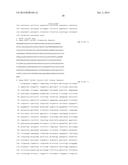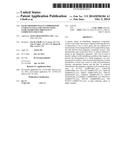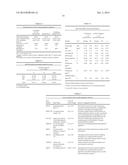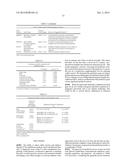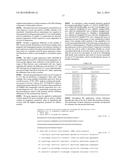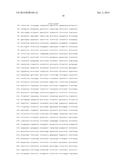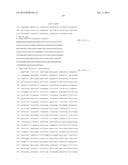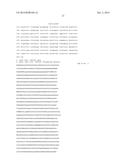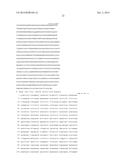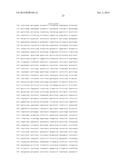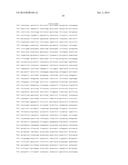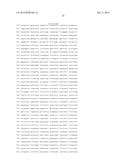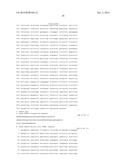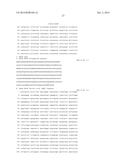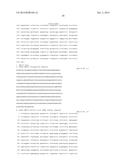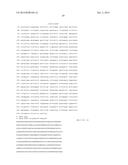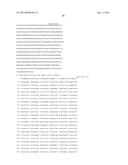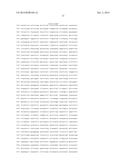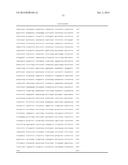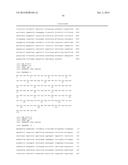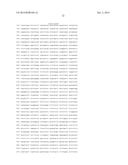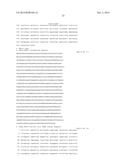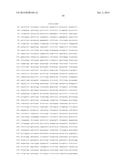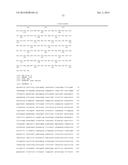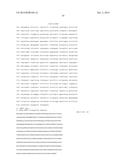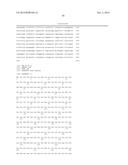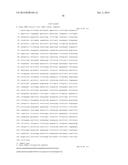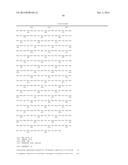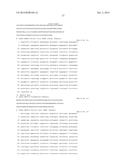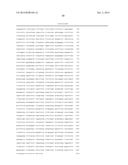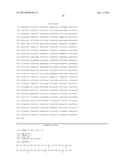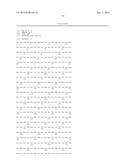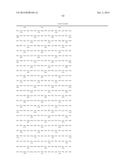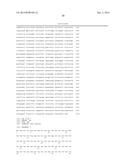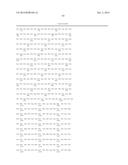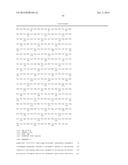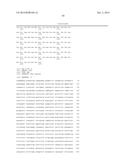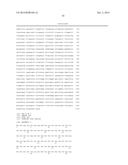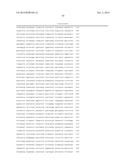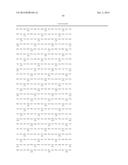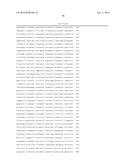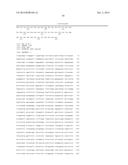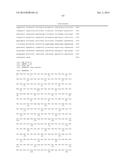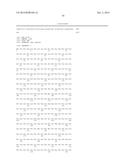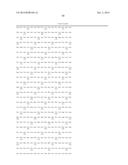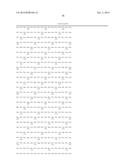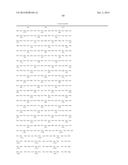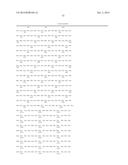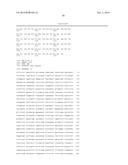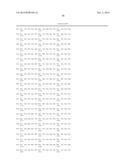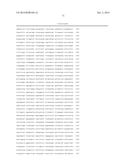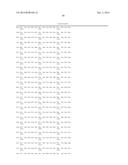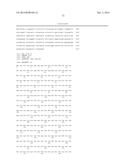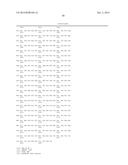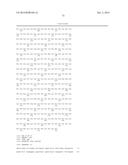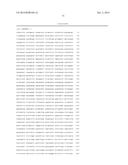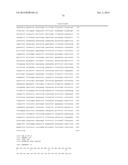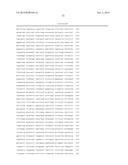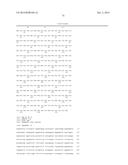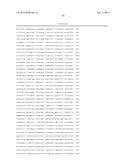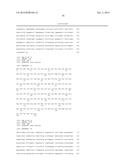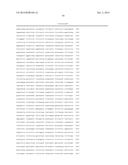Patent application title: Genes Differentially Expressed by Cumulus Cells and Assays Using Same to Identify Pregnancy Competent Oocytes
Inventors:
Jose B. Cibelli (East Lansing, MI, US)
Amy E. Iager (Ada, MI, US)
Hasan H. Otu (Istanbul, TR)
IPC8 Class: AC12Q168FI
USPC Class:
506 9
Class name: Combinatorial chemistry technology: method, library, apparatus method of screening a library by measuring the ability to specifically bind a target molecule (e.g., antibody-antigen binding, receptor-ligand binding, etc.)
Publication date: 2014-10-02
Patent application number: 20140296104
Abstract:
A genetic means of identifying "pregnancy competent" oocytes is provided.
The means comprises detecting the level of expression of one or more
genes that are expressed at characteristic levels (upregulated or
downregulated) in cumulus cells derived from pregnancy competent oocytes.
This characteristic gene expression level, or pattern referred to herein
as the "pregnancy signature", also can be used to identify subjects with
underlying conditions that impair or prevent the development of a viable
pregnancy, e.g., pre-menopausal condition, other hormonal dysfunction,
ovarian dysfunction, ovarian cyst, cancer or other cell proliferation
disorder, autoimmune disease and the like. In preferred embodiments the
pregnancy signature will comprise one or more of FG-F12, (Hs00374427_m1),
GPR137B (Hs00162803_m1), SLC2A9 (Hs00417125_m1), ARID IB (Hs00368175_m1),
NR2F6 (Hs00172870_m1), ZNF132 (Hs01036387_m1), FAM36A (Hs00831105_s1),
ZNF93 (Hs01656246,,s1), RHBDL2 (Hs00384848_m1), DNAJC15 (Hs00387763_m1),
MTUS1 (Hs00826834_m1), ND NUP133 (Hs00217272_m1), or their orthologs,
splice or allelic variants.Claims:
1. A non-invasive method of identifying oocytes that are capable of
giving rise to a viable pregnancy when fertilized comprising the
following steps: (i) obtaining at least one cumulus cell associated with
an oocyte that is to be tested for pregnancy competency from a female
donor or for other oocytes of said same donor; (ii) assaying the
expression of at least one gene by said at least one cumulus cell, the
expression of which correlates to the capability of an oocyte associated
with said cell to yield a viable pregnancy upon fertilization and
transferal into a suitable uterine environment wherein said genes are
selected from FGF12, (Hs00374427_m1), GPR137B (Hs00162803_m1), SLC2A9
(Hs00417125_m1), ARID1B (Hs00368175_m1), NR2F6 (Hs00172870_m1), ZNF132
(Hs01036387_m1), FAM36A (Hs00831105_s1), ZNF93 (Hs01656246_s1), RHBDL2
(Hs00384848_m1), DNAJC15 (Hs00387763_m1), MTUS1 (Hs00826834_m1), ND
NUP133 (Hs00217272_m1), or their orthologs, splice or allelic variants or
any combination of 1, 2, 3, 4, 5, 6, 7, 8, 9, 10, 11 or 12 of said genes;
and (iii) identifying, based on the level of expression of said at least
one gene as compared to the characteristic level of expression by a
cumulus cell associated with a pregnancy competent oocyte whether said
oocytes or another oocyte derived from said female donor is potentially
capable of yielding a viable pregnancy upon fertilization and transferal
into a suitable uterine environment.
2-13. (canceled)
14. The method of claim 1, wherein: (i) said oocyte and cumulus cell is mammalian. (ii) said oocyte and cumulus cell is human. (iii) said oocyte and cumulus cell is from a non-human primate oocyte. (iv) the method of assaying gene expression uses a method that monitors differential gene expression; (v) the method comprises indexing differential display reverse transcriptase polymerase chain reaction (DDRT-PCR); (vi) the oocyte is obtained from a human female who is at least 25 years old; (vii) the oocyte is obtained from a human female who is at least 30 years old. (viii) the oocyte is obtained from a human female who is at least 35 years old; (viii) the oocyte is obtained from a human female who is at least 40 years old; (ix) the aberrant expression of said at least one gene is correlated to a condition selected from menopause, cancer, ovarian dysfunction, ovarian cyst, autoimmune disorder and hormonal dysfunction; and/or (x) or any combination of the foregoing.
15-23. (canceled)
24. A method of assessing the efficacy of a fertility treatment comprising: (i) treating a human female with a putative fertility enhancing treatment; (ii) obtaining an oocyte and cumulus cells associated therewith from said human female after treatment and measuring the expression of at least one gene selected from those contained in Table 4 and further including FGF12, (Hs00374427_m1), GPR137B (Hs00162803_m1), SLC2A9 (Hs00417125_m1), ARID1B (Hs00368175_m1), NR2F6 (Hs00172870_m1), ZNF132 (Hs01036387_m1), FAM36A (Hs00831105_s1), ZNF93 (Hs01656246_s1), RHBDL2 (Hs00384848_m1), DNAJC15 (Hs00387763_m1), MTUS1 (Hs00826834 m1), ND NUP133 (Hs00217272_m1), or their orthologs, splice or allelic variants by at least one cumulus cell associated with said oocyte or any combination of 1, 2, 3, 4, 5, 6, 7, 8, 9, 10, 11 or 12 of said genes and (iii) evaluating whether said treatment is effective based on the level of expression of said at least one gene by said oocyte-associated cell as compared to the characteristic level of expression of said gene by a cumulus cell associated with a normal or pregnancy oocyte or other appropriate control.
25-36. (canceled)
37. The method of claim 24, wherein: (i) said fertility treatment comprises hormonal therapy; (ii) the subject is menopausal and the treatment comprises hormone replacement therapy; (iii) gene expression is detected by real-time polymerase chain reaction (RT-PCR). (iv) gene expression is detected differentially by indexing differential display reverse transcriptase polymerase chain reaction (DDRT-PCR); (v) gene expression results are obtained using RNA from a cumulus cell; or (vi) any combination of the foregoing.
38-42. (canceled)
43. A method of evaluating fertility potential in a subject comprising detecting the expression levels of specific pregnancy signature genes selected from those in Table 4, Table 12 or selected from FGF12, (Hs00374427_m1), GPR137B (Hs00162803_m1), SLC2A9 (Hs00417125_m1), ARID1B (Hs00368175_m1), NR2F6 (Hs00172870_m1), ZNF132 (Hs01036387_m1), FAM36A (Hs00831105_s1), ZNF93 (Hs01656246_s1), RHBDL2 (Hs00384848_m1), DNAJC15 (Hs00387763_m1), MTUS1 (Hs00826834_m1), ND NUP133 (Hs00217272_m1), or their orthologs, splice or allelic variants and ABCA6, NCAM1, OLFML3, PTPRA, SDF4, GPR137B, DDIT4, DUSP1, GPR137B, IDUA, KCTD5, NDNL2, SLC26A3, and TERF21P, or their orthologs, splice or allelic variants, or any combination of 1, 2, 3, 4, 5, 6, 7, 8, 9, 10, 11 or 12 of said genes, by a cumulus cell associated with an oocyte whose pregnancy potential is being evaluated or another oocyte collected from said subject, comparing said levels of expression to the characteristic levels of expression of said genes by cumulus cells which are associated with an oocyte capable of yielding a viable pregnancy; and determining whether said subject is potentially "pregnancy competent" based on whether said cumulus cell expresses one or more pregnancy signature genes at levels characteristic of pregnancy competent oocytes.
44-53. (canceled)
54. The method of claim 1, for selecting a competent oocyte or a competent embryo, further comprising a step of measuring the expression level of one or more genes selected from ABCA6, NCAM1, OLFML3, PTPRA, SDF4, GPR137B, DDIT4, DUSP1, GPR137B, IDUA, KCTD5, NDNL2, SLC26A3, and TERF21P or their orthologs, splice or allelic variant or any combination thereof by said cumulus cell or cumulus cells from the same female donor.
55. The method of claim 24, further comprising a step of measuring the expression level of one or more genes selected from ABCA6, NCAM1, OLFML3, PTPRA, SDF4, GPR137B, DDIT4, DUSP1, GPR137B, IDUA, KCTD5, NDNL2, SLC26A3, and TERF21P or their orthologs, splice or allelic variant or any combination thereof by said cumulus cell or cumulus cells from the same female donor.
56. The method of claim 1, wherein comparison of gene expression of the at least gene by the cumulus cell and the control is performed using a method selected from the group consisting of: weighted voting, Bayesian compound covariate, diagonal linear discriminant, nearest centroid, k-nearest neighbors, shrunken centroids, support vector machines, compound covariate, and any combination thereof.
57. The method of claim 56, wherein comparison of gene expression of the at least one gene by a cumulus cell associated with an oocyte that is to be tested for pregnancy competency to the characteristic level of expression by a cumulus cell associated with a pregnancy competent oocyte is performed using weighted voting.
58. The method of claim 1, further comprising producing an indicator that indicates whether said oocytes derived from said female donor is potentially capable of yielding a viable pregnancy upon fertilization and transferal into a suitable uterine environment.
59. The method of claim 58, wherein said indicator is provided as a report.
60. The method of claim 58, wherein said indicator is displayed on an electronic display.
61. The method of claim 58, wherein said indicator is provided as an electronic communication.
62. An array or detection kit composition for use in claim 1, containing at least 2 of the following genes, polypeptides encoded thereby, probes that specifically bind to the polypeptide or nucleic acid expression product at least 2 of said genes, primers that result in the specific amplification of mRNAs that encode at least 2 of the expression product of these genes, or antibodies that specifically bind to at least 2 of the polypeptides encoded by said genes wherein said genes are selected from: FGF12, (Hs00374427_m1), GPR137B (Hs00162803_m1), SLC2A9 (Hs00417125_m1), ARID1B (Hs00368175_m1), NR2F6 (Hs00172870_m1), ZNF132 (Hs01036387_m1), FAM36A (Hs00831105_s1), ZNF93 (Hs01656246_s1), RHBDL2 (Hs00384848_m1), DNAJC15 (Hs00387763_m1), MTUS1 (Hs00826834_m1), ND NUP133 (Hs00217272_m1), or their orthologs, splice or allelic variants or any combination of 1, 2, 3, 4, 5, 6, 7, 8, 9, 10, 11 or 12 of said genes.
63-67. (canceled)
68. The one or more array or detection kits according to claim 62 that includes one or more detectable labels.
69. The array or detection kits according claim 62, that includes directions in how to use in assays for detecting the level of expression of at least 2 of said 12 genes by cumulus cells associated with a donor woman's oocyte relative to a control which comprises the level of expression of the same genes by cumulus cells which are associated with normal oocytes (oocytes that are capable of giving rise to viable pregnancy naturally or in an IVF procedure).
70-75. (canceled)
Description:
CROSS REFERENCE TO RELATED APPLICATIONS
[0001] This PCT application claims priority to U.S. Provisional Application Ser. No. 61/547,403 filed on Oct. 14, 2011 and U.S. Provisional Application Ser. No. 61/581,219 filed on Dec. 29, 2011.
[0002] This application also relates to PCT application WO/2011/060080, published May 19, 2011, U.S. provisional application Ser. No. 61/388,296 filed Sep. 30, 2010; U.S. provisional application Ser. No. 61/387,313 and 61/387,286 both filed Sep. 28, 2010; U.S. provisional application Ser. No. 61/360,556 filed on Jul. 1, 2010 and U.S. provisional application Ser. No. 61/259,783 filed on Nov. 10, 2009. The contents of all of the identified provisional and non-provisional applications is incorporated herein by reference in its entirety.
FIELD OF THE INVENTION
[0003] The present invention identifies a pregnancy signature gene set containing 12 genes, i.e., FGF12, (Hs00374427_m1), GPR137B (Hs00162803_m1), SLC2A9 (Hs00417125_m1), ARID1B (Hs00368175_m1), NR2F6 (Hs00172870_m1), ZNF132 (Hs01036387_m1), FAM36A (Hs00831105_s1), ZNF93 (Hs01656246_s1), RHBDL2 (Hs00384848_m1), DNAJC15 (Hs00387763_m1), MTUS1 (Hs00826834_m1), ND NUP133 (Hs00217272_m1), wherein the expression of one or more of these genes by cumulus cells correlates to the competency of an oocyte associated therewith, or from the same female donor.
[0004] Based on this discovery, the present invention provides methods and test kits for identifying human oocytes which are potentially suitable for use in IVF procedures by detecting the level of expression of one or more of these 12 genes or corresponding polypeptides consisting of FGF12, (Hs00374427_m1), GPR137B (Hs00162803_m1), SLC2A9 (Hs00417125_m1), ARID1B (Hs00368175_m1), NR2F6 (Hs00172870_m1), ZNF132 (Hs01036387_m1), FAM36A (Hs00831105_s1), ZNF93 (Hs01656246_s1), RHBDL2 (Hs00384848_m1), DNAJC15 (Hs00387763_m1), MTUS1 (Hs00826834_m1), ND NUP133 (Hs00217272_m1).
[0005] Based on this discovery, the present invention provides arrays or test kits containing one or more of these genes or polypeptides or primers or antibodies that provide for the detection and/or quantification of the level of expression of one or more of these 12 genes or corresponding polypeptides consisting of FGF12, (Hs00374427_m1), GPR137B (Hs00162803_m1), SLC2A9 (Hs00417125_m1), ARID1B (Hs00368175_m1), NR2F6 (Hs00172870_m1), ZNF132 (Hs01036387_m1), FAM36A (Hs00831105_s1), ZNF93 (Hs01656246_s1), RHBDL2 (Hs00384848_m1), DNAJC15 (Hs00387763_m1), MTUS1 (Hs00826834_m1), ND NUP133 (Hs00217272_m1). For example, such test kits may contain antibodies that specifically detect one or more of the gene products encoded by these 12 genes and one or more detectable label. Also, such test kits may comprise primers that provide for the specific amplication of one or more of these 12 genes in a sample such as a nucleic acid sample obtained from cumulus cells which are associated with oocytes potentially to be used for fertilization or IVF procedures.
[0006] Based on the foregoing, the present invention further provides genetic methods of identifying female subjects and materials (microarrays, test kits) for use therein, preferably human females, having impaired fertility function, e.g., as a result of impaired ovarian function because of age (menopause), underlying disease condition or drug therapy by analyzing the expression of one or more of these 12 specific genes on cumulus cells obtained from oocytes isolated from said female subject.
[0007] Also, the invention provides methods of evaluating the efficacy of a putative fertility or hormonal treatment by assessing its effect on the expression of one, two, three, four, five, six, seven, eight, nine, ten, eleven or all 12, or any combination thereof, of 12 specific genes, i.e., FGF12, (Hs00374427_m1), GPR137B (Hs00162803_m1), SLC2A9 (Hs00417125_m1), ARID1B (Hs00368175_m1), NR2F6 (Hs00172870_m1), ZNF132 (Hs01036387_m1), FAM36A (Hs00831105_s1), ZNF93 (Hs01656246_s1), RHBDL2 (Hs00384848_m1), DNAJC15 (Hs00387763_m1), MTUS1 (Hs00826834_m1), ND NUP133 (Hs00217272_m1), by cumulus cells of a female subject receiving this fertility or hormonal treatment.
BACKGROUND OF THE INVENTION
[0008] Currently, there is no reliable commercially available genetic or non-genetic procedure for identifying whether a female subject produces oocytes that are "pregnancy competent", i.e., oocytes which when fertilized by natural or artificial means are capable of giving rise to embryos that in turn are capable of yielding viable offspring when transferred to an appropriate uterine environment. Rather, conventional fertility assessment methods assess fertility e.g., based on hormonal levels, visual inspection of numbers and quality of oocytes, surgical or non-invasive (MRI) inspection of the female reproduction system organs, and the like. Often, when a woman has a problem in producing a viable pregnancy after a prolonged duration, e.g., more than a year, the diagnosis may be an "unexplained" fertility problem and the woman advised to simply keep trying or to seek other options, e.g., adoption or surrogacy.
[0009] Perhaps in part of the lack of a means for identifying pregnancy competent oocytes, the success rate for assisted reproductive technology (ART), pregnancy and birth rates following in vitro fertilization (IVF) attempts remain low. Subjective morphological parameters are still a primary criterion to select healthy embryos used for in IVF and ICSI programs. However, such criteria do not truly predict the competence of an embryo. Many studies have shown that a combination of several different morphologic criteria leads to more accurate embryo selection. Morphological criteria for embryo selection are assessed on the day of transfer, and are principally based on early embryonic cleavage (25-27 h post insemination), the number and size of blastomeres on day two, day three, or day five, fragmentation percentage and the presence of multi-nucleation in the 4 or 8 cell stage (Fenwick et al., Hum Reprod, 17, 407-12. (2002).
[0010] A recent study has shown that the selection of oocytes for insemination does not improve outcome of ART as compared to the transfer of all available embryos, irrespective of their quality (La Sala et al., Fertil Steril. (2008)).
[0011] There is a need to identify viable embryos with the highest implantation potential to increase IVF success rates, reduce the number of embryos for fresh replacement and lower multiple pregnancy rates. For all these reasons, several biomarkers for embryo selection are currently being investigated (Haouzi et al., Gynecol Obstet Fertil, 36, 730-742. (2008); He et al., Nature, 444, 12-3. (2006)).
[0012] As embryos that result in pregnancy differ in their metabolic profiles compared to embryos that do not, some studies are trying to identify a molecular signature that can be detected by non-invasive evaluation of the embryo culture medium (Brison et al., Hum Reprod, 19, 2319-24. (2004); Gardner et al., Fertil Steril, 76, 1175-80. (2001); Sakkas and Gardner, Curr Opin Obstet Gynecol, 17, 283-8 (2005); Seli et al., Fertil Steril, 88, 1350-7. (2007); Zhu et al. Fertil Steril. (2007).
[0013] Genomics are also providing vital knowledge of genetic and cellular function during embryonic development. McKenzie et al., Hum Reprod, 19, 2869-74. (2004); Feuerstein et al., Hum Reprod, 22, 3069-77 have reported, that the expression of several genes in cumulus cells, such as cyclooxygenase 2 (COX2), was indicative of oocyte and embryo quality. In addition Gremlin 1 (GREM1), hyaluronic acid synthase 2 (HAS2), steroidogenic acute regulatory protein (STAR), stearoyl-coenzyme A desaturase 1 and 5 (SCD1 and 5), amphiregulin (AREG) and pentraxin 3 (PTX3) have also been reported to be positively correlated with embryo quality (Zhang et al., Fertil Steril, 83 Suppl 1, 1169-79. (2005)). More recently, the expression of glutathione peroxidase 3 (GPX3), chemokine receptor 4 (CXCR4), cyclin D2 (CCND2) and catenin delta 1 (CTNND1) in human cumulus cells have been shown to be inversely correlated with embryo quality, based on early-cleavage rates during embryonic development (van Montfoort et al., (2008) MoI Hum Reprod, 14, 157-68. (2008)).
[0014] Also Cillo et al., Reprod. 134:645-50 (2007) suggests a correlation between the expression of certain cumulus genes, i.e., HAS2, GREM1 and PTX3 and oocyte quality and embryo development. Still further Assidi et al. Biol. Reprod. 79(2) 209-222 (2008) suggest a correlation as to the expression of certain cumulus genes, i.e., EGFR, CD44, HAS2, PTSG2 and BTC and oocyte quality and development of embryos therefrom. Further, Bettegowda et al., Biol. Reprod. 79(2):301-309 (2008) suggest a correlation as to the expression of certain proteinase cathepsin genes and bovine oocyte quality and development of offspring therefrom.
[0015] In addition, a patent was recently issued to Zhang et al. (Aug. 11, 2009) claims the detection of pentraxin 3 and a BCL-2 member on cumulus cells to assess oocyte quality. Also, US20040058975 published on Mar. 25, 2004 teaches that antagonism of the EP2 receptor and/or cycloxygenase COX-2 promotes cumulus cell proliferation and oocyte development.
[0016] Also, while early cleavage has been shown to be a reliable biomarker for predicting pregnancy (Lundin et al., Hum Reprod, 16, 2652-7. (2001); Van Montfoort et al., Hum Reprod, 19, 2103-8 (2004; Yang et al., Fertil Steril, 88, 1573-8 (2007)), little has been reported correlating gene expression profiles of cumulus cells with respect to pregnancy outcome (but see Assou et al., Mol Hum Reprod. 2008 December; 14(12):711-9. Epub 2008 Nov. 21).
[0017] Therefore, notwithstanding the foregoing, providing alternative and more predictive methods for identifying oocytes suitable for use in IVF procedures and in identifying the genetic bases of fertility problems in women would be highly desirable. In particular an identification of other genes, and biomarkers, the expression of which by cumulus cells correlates to pregnancy competency of oocytes and test kits and assays using same would be highly desirable as this could enhance the outcome of IVF procedures.
[0018] These methods and test kits would in addition provide for the identification of women with oocyte related fertility problems, which is desirable as such fertility problems may correlate to other health issues that preclude pregnancy, e.g., cancer, menopausal condition, hormonal dysfunction, ovarian cyst, or other underlying disease or health related problems.
BRIEF DESCRIPTION AND OBJECTS OF THE INVENTION
[0019] The present invention relates to a method for selecting a competent oocyte, e.g., one that gives rise to a fertilized embryo that yields a viable pregnancy comprising a step of measuring the expression level of any combination of one of 12 genes selected from the group consisting of FGF12, (Hs00374427_m1), GPR137B (Hs00162803_m1), SLC2A9 (Hs00417125_m1), ARID1B (Hs00368175_m1), NR2F6 (Hs00172870_m1), ZNF132 (Hs01036387_m1), FAM36A (Hs00831105_s1), ZNF93 (Hs01656246_s1), RHBDL2 (Hs00384848_m1), DNAJC15 (Hs00387763_m1), MTUS1 (Hs00826834_m1), ND NUP133 (Hs00217272_m1) by a cumulus cell associated with an oocyte or from an oocyte from the same female donor and comparing said gene expression to a suitable control, e.g., cumulus cells of female donors with normal oocytes, i.e., which give rise to viable pregnancies.
[0020] The present invention also relates to a method for selecting a competent embryo, comprising a step of measuring the expression level of specific genes in a cumulus cell surrounding the embryo, wherein said genes include or consist of genes selected from the group consisting of FGF12, (Hs00374427_m1), GPR137B (Hs00162803_m1), SLC2A9 (Hs00417125_m1), ARID1B (Hs00368175_m1), NR2F6 (Hs00172870_m1), ZNF132 (Hs01036387_m1), FAM36A (Hs00831105_s1), ZNF93 (Hs01656246_s1), RHBDL2 (Hs00384848_m1), DNAJC15 (Hs00387763_m1), MTUS1 (Hs00826834_m1), ND NUP133 (Hs00217272_m1).
[0021] The present invention also relates to a method for selecting a competent oocyte or a competent embryo, comprising a step of measuring in a cumulus cell surrounding said oocyte or said embryo the expression level of one or more genes selected from the FGF12, (Hs00374427_m1), GPR137B (Hs00162803_m1), SLC2A9 (Hs00417125_m1), ARID1B (Hs00368175_m1), NR2F6 (Hs00172870_m1), ZNF132 (Hs01036387_m1), FAM36A (Hs00831105_s1), ZNF93 (Hs01656246_s1), RHBDL2 (Hs00384848_m1), DNAJC15 (Hs00387763_m1), MTUS1 (Hs00826834_m1), ND NUP133 (Hs00217272_m1).
[0022] Aberrant expression levels of one or more of these genes is predictive of a non competent oocyte or embryo due to early embryo arrest.
[0023] As discussed infra, it has been found that the level of expression of these genes by a cumulus cell of a woman donor correlates to the likelihood that an oocyte associated with said cumulus cell or derived from the same subject are "pregnancy competent" when fertilized by natural or artificial means. These genes and expression levels constitute what Applicants refer to as the "pregnancy signature". In addition the pregnancy signature may further include one or more of the genes disclosed in Applicant's prior applications identified supra.
[0024] It is a related object of the invention to provide a novel method of determining whether an individual has a genetic associated fertility problem which potentially renders the individual's oocytes unsuitable for use in IVF methods based on the detected level of expression of one or more genes or corresponding polypeptides which constitute the "pregnancy signature." The genes and gene products which constitute the pregnancy signature are again preferably selected from those contained in FGF12, (Hs00374427_m1), GPR137B (Hs00162803_m1), SLC2A9 (Hs00417125_m1), ARID1B (Hs00368175_m1), NR2F6 (Hs00172870_m1), ZNF132 (Hs01036387_m1), FAM36A (Hs00831105_s1), ZNF93 (Hs01656246_s1), RHBDL2 (Hs00384848_m1), DNAJC15 (Hs00387763_m1), MTUS1 (Hs00826834_m1), ND NUP133 (Hs00217272_m1).
[0025] It is another object of the invention to provide a method of evaluating the efficacy of a female fertility treatment which comprises: treating a female subject putatively having a problem that prevents or inhibits her from having a "viable pregnancy" and isolating at least one oocyte from said female subject and cells associated therewith after said fertility treatment; isolating at least one cumulus cell associated with said isolated oocyte, and detecting the level of expression of at least one gene selected from FGF12, (Hs00374427_m1), GPR137B (Hs00162803_m1), SLC2A9 (Hs00417125_m1), ARID1B (Hs00368175_m1), NR2F6 (Hs00172870_m1), ZNF132 (Hs01036387_m1), FAM36A (Hs00831105_s1), ZNF93 (Hs01656246_s1), RHBDL2 (Hs00384848_m1), DNAJC15 (Hs00387763_m1), MTUS1 (Hs00826834_m1), ND NUP133 (Hs00217272_m1), or their orthologs, splice or allelic variants that is expressed at a characteristic level of expression in "pregnancy competent" oocytes; and determining the putative efficacy of said fertility treatment based on whether said gene is expressed at a level characteristic of "pregnancy competent" oocytes as a result of treatment.
[0026] It is another specific object of the invention to provide novel methods of treating infertility by modulating the expression of one or more genes that constitute the pregnancy signature. These methods include the administration of compounds that agonize or antagonize the expression of one or more of the genes selected from FGF12, (Hs00374427_m1), GPR137B (Hs00162803_m1), SLC2A9 (Hs00417125_m1), ARID1B (Hs00368175_m1), NR2F6 (Hs00172870_m1), ZNF132 (Hs01036387_m1), FAM36A (Hs00831105_s1), ZNF93 (Hs01656246_s1), RHBDL2 (Hs00384848_m1), DNAJC15 (Hs00387763_m1), MTUS1 (Hs00826834_m1), ND NUP133 (Hs00217272_m1), or their orthologs, splice or allelic variants and their splice or allelic variants.
[0027] It is another object of the invention to provide animal models for evaluating the efficacy of putative fertility treatments comprising identifying genes which are expressed at characteristic levels in cumulus cells associated with pregnancy competent oocytes of a non-human animal, e.g., a non-human primate; and assessing the efficacy of a putative fertility treatment in said non-human animal based on its effect on said gene expression levels, i.e., whether said treatment results in said gene expression levels better mimicking gene expression levels observed in cumulus cells associated with pregnancy competent oocytes, ("pregnancy signature"). i.e. one or more of the 12 genes selected from FGF12, (Hs00374427_m1), GPR137B (Hs00162803_m1), SLC2A9 (Hs00417125_m1), ARID1B (Hs00368175_m1), NR2F6 (Hs00172870_m1), ZNF132 (Hs01036387_m1), FAM36A (Hs00831105_s1), ZNF93 (Hs01656246_s1), RHBDL2 (Hs00384848_m1), DNAJC15 (Hs00387763_m1), MTUS1 (Hs00826834_m1), ND NUP133 (Hs00217272_m1), or their orthologs, splice or allelic variants.
DETAILED DESCRIPTION OF THE FIGURES
[0028] FIG. 1 contains a flow chart of methods used to identify the subject "pregnancy signature" i.e., 12 genes the expression of which on cumulus cells correlates to the pregnancy competency or ability of an oocyte associated with said cumulus cell or from the same female human or other mammalian donor to be capable of fertilization and when used in an IVF procedure capable of giving rise to a viable fetus and live offspring
[0029] FIG. 2 shows the predictive value and specificity of the subject gene detection methods according to Youdun's index.
DETAILED DESCRIPTION OF THE INVENTION
[0030] Prior to discussing the invention in more detail, the following definitions are provided. Otherwise all words and phrases in this application are to be construed by their ordinary meaning, as they would be interpreted by an ordinary skilled artisan within the context of the invention.
[0031] "Pregnancy-competent oocyte": refers to a female gamete or egg that when fertilized by natural or artificial means is capable of yielding a viable pregnancy when it is comprised in a suitable uterine environment.
[0032] "The term "competent embryo" similarly refers to an embryo with a high implantation rate leading to pregnancy. The term "high implantation rate" means the potential of the embryo when transferred in uterus, to be implanted in the uterine environment and to give rise to a viable fetus, which in turn develops into a viable offspring absent a procedure or event that terminates said pregnancy.
[0033] "Viable-pregnancy": refers to the development of a fertilized oocyte when contained in a suitable uterine environment and its development into a viable fetus, which in turn develops into a viable offspring absent a procedure or event that terminates said pregnancy.
[0034] "Cumulus cell" refers to a cell comprised in a mass of cells that surrounds an oocyte. This is an example of an "oocyte associated cell". These cells are believed to be involved in providing an oocyte some of its nutritional and or other requirements that are necessary to yield an oocyte which upon fertilization is "pregnancy competent".
[0035] "Differential gene expression" refer to genes the expression of which varies within a tissue of interest; herein preferably a cell associated with an oocyte, e.g., a cumulus cell.
[0036] "Real Time RT-PCR": refers to a method or device used therein that allows for the simultaneous amplification and quantification of specific RNA transcripts in a sample.
[0037] "Microarray analysis": refers to the quantification of the expression levels of specific genes in a particular sample, e.g., tissue or cell sample.
[0038] "Pregnancy signature": herein preferably refers to the normal level of expression of one or more genes or polypeptides that are selected or encoded by the specific genes selected from the group consisting of FGF12, (Hs00374427_m1), GPR137B (Hs00162803_m1), SLC2A9 (Hs00417125_m1), ARID1B (Hs00368175_m1), NR2F6 (Hs00172870_m1), ZNF132 (Hs01036387_m1), FAM36A (Hs00831105_s1), ZNF93 (Hs01656246_s1), RHBDL2 (Hs00384848_m1), DNAJC15 (Hs00387763_m1), MTUS1 (Hs00826834_m1), ND NUP133 (Hs00217272_m1). and their orthologs, splice or allelic variants wherein these genes or polypeptides are expressed in normal cumulus cells at levels which correlate to the likelihood that an oocyte that is associated with a cumulus cell which expresses said one or more genes or polypeptides at these characteristic levels are more likely to give rise to a viable pregnancy. Alternatively the signature may include one or more of the genes differentially expressed by cumulus cells the expression of which also correlates to pregnancy competent oocytes which are identified in the patent applications incorporated by reference herein.
[0039] "Characteristic level of expression of a cumulus gene" herein with respect to a particular detected expressed nucleic acid sequence or polypeptide means that the particular gene or polypeptide is expressed at levels which are substantially similar to the levels observed in cumulus cells that are associated with a normal cumulus cell or one associated with a normal or developmentally competent oocyte.
[0040] By "substantially similar" is meant that the levels of expression of individual genes are preferably within the range of +/-1-5 fold of the level of expression by a normal cumulus cell, more preferably within the range of +/-1-3-fold, still more preferably within the range of +/-1-1.5 fold and most preferably within the range of +/-1.0-1.4, 1.0-1.3, 1.0-1.2 or 1.0-1.1 fold of the detected levels of expression of the gene or polypeptide by a normal cumulus cell.
[0041] According to the invention, the oocyte may result from a natural cycle, a modified natural cycle or a stimulated cycle for cIVF or ICSI. The term "natural cycle" refers to the natural cycle by which the female or woman produces an oocyte. The term "modified natural cycle" refers to the process by which, the female or woman produces an oocyte or two under a mild ovarian stimulation with GnRH antagonists associated with recombinant FSH or hMG. The term "stimulated cycle" refers to the process by which a female or a woman produces one ore more oocytes under stimulation with GnRH agonists or antagonists associated with recombinant FSH or hMG.
[0042] "Oocyte or cumulus cell determined to possess suitable pregnancy signature or to be pregnancy competent" refers to an oocyte or a cumulus cell associated with the oocyte or an oocyte derived from the same subject at around the same time (within 0-6 months) as the tested cumulus cell which has been determined to express at least one of the genes or polypeptides encoded by the following genes: FGF12, (Hs00374427_m1), GPR137B (Hs00162803_m1), SLC2A9 (Hs00417125_m1), ARID1B (Hs00368175_m1), NR2F6 (Hs00172870_m1), ZNF132 (Hs01036387_m1), FAM36A (Hs00831105_s1), ZNF93 (Hs01656246_s1), RHBDL2 (Hs00384848_m1), DNAJC15 (Hs00387763_m1), MTUS1 (Hs00826834_m1), ND NUP133 (Hs00217272_m1). or an ortholog or splice or allelic variant thereof in a manner characteristic of the level of expression by a normal cumulus cell. Preferably at least 2 or 3 genes are expressed in a characteristic manner, more preferably at least 3-5 genes, or their allelic or splice variants. It should be understood that if the expression of numerous genes are evaluated in the subject genetic based assays, such as in the order of 10 or more, that a suitable pregnancy signature means that all or substantially all, i.e. at least 70-80% of the detected genes are expressed in a manner characteristic of a normal cumulus cell. For example if the expression of 10 genes is detected at least 7, 8 or 9 of the genes will preferably be expressed at the levels consistent with a normal cumulus cell, i.e. one associated with an oocyte capable of giving rise to a normal embryo and viable pregnancy.
[0043] In general with respect to the pregnancy signature the characteristic levels of expression is observed for any combination of the afore-identified 12-gene pregnancy signature set, i.e., any combination of at least 1, 2, 3, 4, 5, 6, 7, 8, 9, 10, 11 or 12 of the afore-identified genes, that are expressed at characteristic levels in cumulus cells, that surround "pregnancy competent" oocytes. This is intended to encompass the level at which the gene is expressed and the distribution of gene expression within cumulus cells analyzed.
[0044] "Pregnancy signature gene": refers to a gene which is expressed at characteristic levels by a cumulus cell, which is associated with a normal or "pregnancy competent" oocyte. These genes are FGF12, (Hs00374427_m1), GPR137B (Hs00162803_m1), SLC2A9 (Hs00417125_m1), ARID1B (Hs00368175_m1), NR2F6 (Hs00172870_m1), ZNF132 (Hs01036387_m1), FAM36A (Hs00831105_s1), ZNF93 (Hs01656246_s1), RHBDL2 (Hs00384848_m1), DNAJC15 (Hs00387763_m1), MTUS1 (Hs00826834_m1), ND NUP133 (Hs00217272_m1). and their orthologs, splice and allelic variants. These 12 human genes are referenced by their name as well as Accession number. It should be understood that the invention further encompasses detection of allelic and splice variants of these genes and species orthologs.
[0045] "Probe suitable for detection of the expression of a pregnancy signature gene or polypeptide" refers to a nucleic acid sequence or sequences or ligand such as an antibody that specifically detects the expression of the transcribed gene or corresponding polypeptide. In a preferred embodiment expression is selected by use of realtime PCR detection methods.
[0046] "IVF": refers to in vitro fertilization.
[0047] The term "classical in vitro fertilization" or "cIVF" refers to a process by which oocytes are fertilized by sperm outside of the body, in vitro. IVF is a major treatment in infertility when in vivo conception has failed. The term "intracytoplasmic sperm injection" or "ICSI" refers to an in vitro fertilization procedure in which a single sperm is injected directly into an oocyte. This procedure is most commonly used to overcome male infertility factors, although it may also be used where oocytes cannot easily be penetrated by sperm, and occasionally as a method of in vitro fertilization, especially that associated with sperm donation.
[0048] "Zona pellucida" refers to the outermost region of an oocyte.
[0049] "Method for detecting differential expressed genes" encompasses any known method for quantitatively evaluating differential gene expression using a probe that specifically detects for the expressed gene transcript or encoded polypeptide. Examples of such methods include indexing differential display reverse transcription polymerase chain reaction (DDRT-PCR; Mahadeva et al, 1998, J. Mol. Biol. 284:1391-1318; WO 94/01582; subtractive mRNA hybridization (See Advanced Mol. Biol.; R. M. Twyman (1999) Bios Scientific Publishers, Oxford, p. 334, the use of nucleic acid arrays or microarrays (see Nature Genetics, 1999, vol. 21, Suppl. 1061) and the serial analysis of gene expression. (SAGE) See e.g., Valculesev et al, Science (1995) 270:484-487) and real time PCR (RT-PCR). For example, differential levels of a transcribed gene in an oocyte cell can be detected by use of Northern blotting, and/or RT-PCR. A preferred method is the CRL amplification protocol refers to the novel total RNA amplification protocol that combines template-switching PCR and T7 based amplification methods. This protocol is well suited for samples wherein only a few cells or limited total RNA is available.
[0050] Preferably, the "pregnancy signature" genes are detected by hybridization of RNA or DNA to DNA chips, e.g., filter arrays comprising cDNA sequences or glass chips containing cDNA or in situ synthesized oligonucleotide sequences. Filtered arrays are typically better for high and medium abundance genes. DNA chips can detect low abundance genes. In the exemplary embodiment the sample may be probed with Affymetrix GeneChips comprising genes from the human genome or a subset thereof.
[0051] Alternatively, polypeptide arrays comprising the polypeptides encoded by pregnancy signature genes or antibodies that bind thereto may be produced and used for detection and diagnosis.
[0052] "EASE" is a gene ontology protocol that from a list of genes forms subgroups based on functional categories assigned to each gene based on the probability of seeing the number of subgroup genes within a category given the frequency of genes from that category appearing on the microarray.
[0053] Based on the foregoing the present invention provides a novel method of detecting whether a female, preferably human or non-human mammal, produces "pregnancy competent" oocytes or whether a particular oocyte is pregnancy competent. The method involves detecting the levels of expression of one or more genes in selected from the group consisting of FGF12, (Hs00374427_m1), GPR137B (Hs00162803_m1), SLC2A9 (Hs00417125_m1), ARID1B (Hs00368175_m1), NR2F6 (Hs00172870_m1), ZNF132 (Hs01036387_m1), FAM36A (Hs00831105_s1), ZNF93 (Hs01656246_s1), RHBDL2 (Hs00384848_m1), DNAJC15 (Hs00387763_m1), MTUS1 (Hs00826834_m1), ND NUP133 (Hs00217272_m1) that are expressed at characteristic levels by cumulus cells associated with (surrounding) oocytes that are "pregnancy competent", i.e., these oocytes when fertilized by natural or artificial means (IVF), and transferred into a suitable uterine environment are capable of yielding a viable pregnancy, i.e., embryo that develops into a viable fetus and eventually an offspring unless the pregnancy is terminated by some event or procedure, e.g., a surgical or hormonal intervention.
[0054] As described herein the inventors have determined a set of 12 genes expressed in cumulus cells that are biomarkers for embryo potential and pregnancy outcome. They demonstrated that genes expression profile of cumulus cells which surrounds oocyte correlated to different pregnancy outcomes, allowing the identification of a specific expression signature of embryos developing toward pregnancy. Their results indicate that analysis of cumulus cells surrounding the oocyte is a non-invasive approach for embryo selection.
[0055] The set of 12 predictive genes herein are known human genes. However, the expression of these genes (on cumulus cells) had not heretofore been correlated to oocyte competency or embryo development. Therefore, this invention relates to a method for selecting a competent oocyte, comprising a step of measuring the expression level of specific genes in a cumulus cell surrounding said oocyte, wherein said genes include at least one of the genes selected from the group consisting of FGF12, (Hs00374427_m1), GPR137B (Hs00162803_m1), SLC2A9 (Hs00417125_m1), ARID1B (Hs00368175_m1), NR2F6 (Hs00172870_m1), ZNF132 (Hs01036387_m1), FAM36A (Hs00831105_s1), ZNF93 (Hs01656246_s1), RHBDL2 (Hs00384848_m1), DNAJC15 (Hs00387763_m1), MTUS1 (Hs00826834_m1), ND NUP133 (Hs00217272_m1).
[0056] The methods of the invention may further comprise a step consisting of comparing the expression level of the genes in the sample with a control, wherein detecting differential in the expression level of the genes between the sample and the control is indicative whether the oocyte is competent. The control may consist in sample comprising cumulus cells associated with a competent oocyte or in a sample comprising cumulus cells associated with an unfertilized oocyte.
[0057] The methods of the invention are applicable preferably to human women but may be applicable to other mammals (e.g., primates, dogs, cats, pigs, cows) including endangered species wherein IVF procedures are often used in zoos in order to increase population numbers.
[0058] The methods of the invention are particularly suitable for assessing the efficacy of an in vitro fertilization treatment. Accordingly the invention also relates to a method for assessing the efficacy of a controlled ovarian hyperstimulation (COS) protocol in a female subject comprising: 1) providing from said female subject at least one oocyte with its cumulus cells; ii) determining by a method of the invention whether said oocyte is a competent oocyte.
[0059] Then after such a method, the embryologist may select the competent oocytes and in vitro fertilize them, fur example using a classical in vitro fertilization (cIVF) protocol or under an intracytoplasmic sperm injection (ICSI) protocol.
[0060] A further object of the invention relates to a method for monitoring the efficacy of a controlled ovarian hyperstimulation (COS) protocol comprising: 1) isolating from said woman at least one oocyte with its cumulus cells under natural, modified or stimulated cycles; ii) determining by a method of the invention whether said oocyte is a competent oocyte; iii) and monitoring the efficacy of COS treatment based on whether it results in a competent oocyte.
[0061] The COS treatment may be based on at least one active ingredient selected from the group consisting of GnRH agonists or antagonists associated with recombinant FSH or hMG.
[0062] The present invention also relates to a method for selecting a competent embryo, comprising a step of measuring the expression level of at least one of the 12 genes selected from the group consisting of FGF12, (Hs00374427_m1), GPR137B (Hs00162803_m1), SLC2A9 (Hs00417125_m1), ARID1B (Hs00368175_m1), NR2F6 (Hs00172870_m1), ZNF132 (Hs01036387_m1), FAM36A (Hs00831105_s1), ZNF93 (Hs01656246_s1), RHBDL2 (Hs00384848_m1), DNAJC15 (Hs00387763_m1), MTUS1 (Hs00826834_m1), ND NUP133 (Hs00217272_m1).
[0063] The methods of the invention may further comprise a step consisting of comparing the expression level of the genes in the sample with a control, wherein detecting differential in the expression level of the genes between the sample and the control is indicative whether the embryo is competent. The control may consist in sample comprising cumulus cells associated with an embryo that gives rise to a viable fetus or in a sample comprising cumulus cells associated with an embryo that does not give rise to a viable fetus.
[0064] It is noted that the methods of the invention leads to an independence from morphological considerations of the embryo. Two embryos may have the same morphological aspects but by a method of the invention may present a different implantation rate leading to pregnancy.
[0065] The methods of the invention are applicable preferably to human women but may be applicable to other mammals, both domesticated ad non-domesticated such as endangered species (e.g. primates, dogs, cats, pigs, cows, tigers, lions, pandas, cheetahs, et al.).
[0066] The present invention also relates to a method for determining whether an embryo is a competent embryo, comprising a step consisting of measuring the expression level of specific genes in a cumulus cell surrounding the embryo, wherein said genes include at least one of the 12 genes selected from the group consisting of FGF12, (Hs00374427_m1), GPR137B (Hs00162803_m1), SLC2A9 (Hs00417125_m1), ARID1B (Hs00368175_m1), NR2F6 (Hs00172870_m1), ZNF132 (Hs01036387_m1), FAM36A (Hs00831105_s1), ZNF93 (Hs01656246_s1), RHBDL2 (Hs00384848_m1), DNAJC15 (Hs00387763_m1), MTUS1 (Hs00826834_m1), ND NUP133 (Hs00217272_m1).
[0067] The present invention also relates to a method for determining whether an embryo is a competent embryo, comprising: i) providing an oocyte with its cumulus cells; ii) in vitro fertilizing said oocyte; and iii) determining whether the embryo that results from step ii) is competent by determining by a method of the invention whether said oocyte of step i), is a competent oocyte.
[0068] The present invention also relates to a method for selecting a competent oocyte or a competent embryo, comprising a step of measuring in a cumulus cell surrounding said oocyte or said embryo the expression level of one or more genes selected from at least one of the 12 genes selected from the group consisting of FGF12, (Hs00374427_m1), GPR137B (Hs00162803_m1), SLC2A9 (Hs00417125_m1), ARID1B (Hs00368175_m1), NR2F6 (Hs00172870_m1), ZNF132 (Hs01036387_m1), FAM36A (Hs00831105_s1), ZNF93 (Hs01656246_s1), RHBDL2 (Hs00384848_m1), DNAJC15 (Hs00387763_m1), MTUS1 (Hs00826834_m1), ND NUP133 (Hs00217272_m1). Aberrant expression of one or more of these genes selected my be predictive of a non competent oocyte or embryo, the inability of the embryo being unable to implant or of a non competent oocyte or embryo due to early embryo arrest.
[0069] The methods of the invention are particularly suitable for enhancing the pregnancy outcome of a female. Accordingly the invention also relates to a method for enhancing the pregnancy outcome of a female comprising: i) selecting a competent embryo by performing a method of the invention; iii) implanting the embryo selected at step i) in the uterus of said female, wherein said female may or may not be the oocyte donor.
[0070] The method as above described will thus help embryologist to avoid the transfer in uterus of embryos with a poor potential for pregnancy outcome. The method as above described is also particularly suitable for avoiding multiple pregnancies by selecting the competent embryo able to lead to an implantation and a viable, full-term pregnancy.
Methods for Determining the Expression Level of the Genes of the Invention:
[0071] Determination of the expression level of the genes in the "pregnancy signature" i.e., at least one of the 12 genes selected from the group consisting of FGF 12, (Hs00374427_m1), GPR137B (Hs00162803_m1), SLC2A9 (Hs00417125_m1), ARID 1B (Hs00368175_m1), NR2F6 (Hs00172870_m1), ZNF132 (Hs01036387_m1), FAM36A (Hs00831105_s1), ZNF93 (Hs01656246_s1), RHBDL2 (Hs00384848_m1), DNAJC15 (Hs00387763_m1), MTUS1 (Hs00826834_m1), ND NUP133 (Hs00217272_m1) can be performed by a variety of techniques. Generally, the expression level as determined is a relative expression level.
[0072] More preferably, the determination comprises contacting the sample with selective reagents such as probes, primers or ligands, and thereby detecting the presence, or measuring the amount, of polypeptide or nucleic acids of interest originally in the sample. Contacting may be performed in any suitable device, such as a plate, microtitre dish, test tube, well, glass, column, and so forth. In specific embodiments, the contacting is performed on a substrate coated with the reagent, such as a nucleic acid array or a specific ligand array. The substrate may be a solid or semi-solid substrate such as any suitable support comprising glass, plastic, nylon, paper, metal, polymers and the like. The substrate may be of various forms and sizes, such as a slide, a membrane, a bead, a column, a gel, etc. The contacting may be made under any condition suitable for a detectable complex, such as a nucleic acid hybrid or an antibody-antigen complex, to be formed between the reagent and the nucleic acids or polypeptides of the sample.
[0073] In a preferred embodiment, the expression level may be determined by determining the quantity of mRNA.
[0074] Methods for determining the quantity of mRNA are well known in the art. For example the nucleic acid contained in the samples (e.g., cell or tissue prepared from the patient) is first extracted according to standard methods, for example using lytic enzymes or chemical solutions or extracted by nucleic-acid-binding resins following the manufacturer's instructions. The extracted mRNA is then detected by hybridization (e.g., Northern blot analysis) and/or amplification (e.g., RT-PCR). Preferably quantitative or semi-quantitative RT-PCR is preferred. Real-time quantitative or semi-quantitative RT-PCR is particularly advantageous. Other methods of amplification include ligase chain reaction (LCR), transcription-mediated amplification (TMA), strand displacement amplification (SDA) and nucleic acid sequence based amplification (NASBA).
[0075] Nucleic acids having at least 10 nucleotides and exhibiting sequence complementarity or homology to the mRNA of interest herein find utility as hybridization probes or amplification primers. It is understood that such nucleic acids need not be identical, but are typically at least about 80% identical to the homologous region of comparable size, more preferably 85% identical and even more preferably 90-95% identical. In certain embodiments, it is advantageous to use nucleic acids in combination with appropriate means, such as a detectable label, for detecting hybridization. A wide variety of appropriate indicators are known in the art including, fluorescent, radioactive, enzymatic or other ligands (e.g. avidin/biotin).
[0076] Probes typically comprise single-stranded nucleic acids of between 10 to 1000 nucleotides in length, for instance of between 10 and 800, more preferably of between 15 and 700, typically of between 20 and 500. Primers typically are shorter single-stranded nucleic acids, of between 10 to 25 nucleotides in length, designed to perfectly or almost perfectly match a nucleic acid of interest, to be amplified. The probes and primers are "specific" to the nucleic acids they hybridize to, i.e. they preferably hybridize under high stringency hybridization conditions (corresponding to the highest melting temperature Tm, e.g., 50% formamide, 5× or 6×SCC. SCC is a 0.15 M NaCl, 0.015 M Na-citrate). The nucleic acid primers or probes used in the above amplification and detection method may be assembled as a kit. Such a kit includes consensus primers and molecular probes. A preferred kit also includes the components necessary to determine if amplification has occurred. The kit may also include, for example, PCR buffers and enzymes; positive control sequences, reaction control primers; and instructions for amplifying and detecting the specific sequences.
[0077] In a particular embodiment, the methods of the invention comprise the steps of providing total RNAs extracted from cumulus cells and subjecting the RNAs to amplification and hybridization to specific probes, more particularly by means of a quantitative or semiquantitative RT-PCR.
[0078] In another preferred embodiment, the expression level is determined by DNA chip analysis. Such DNA chip or nucleic acid microarray consists of different nucleic acid probes that are chemically attached to a substrate, which can be a microchip, a glass slide or a micro sphere-sized bead. A microchip may be constituted of polymers, plastics, resins, polysaccharides, silica or silica-based materials, carbon, metals, inorganic glasses, or nitrocellulose. Probes comprise nucleic acids such as cDNAs or oligonucleotides that may be about 10 to about 60 base pairs. To determine the expression level, a sample from a test subject, optionally first subjected to a reverse transcription, is labeled and contacted with the microarray in hybridization conditions, leading to the formation of complexes between target nucleic acids that are complementary to probe sequences attached to the microarray surface. The labeled hybridized complexes are then detected and can be quantified or semi-quantified. Labeling may be achieved by various methods, e.g. by using radioactive or fluorescent labeling. Many variants of the microarray hybridization technology are available to the man skilled in the art (see e.g. the review by Hoheisel, Nature Reviews, Genetics, 2006, 7:200-210)
[0079] In this context, the invention further provides a DNA chip comprising a solid support which carries nucleic acids that are specific to at least one of the 12 genes selected from the group consisting of FGF12, (Hs00374427_m1), GPR137B (Hs00162803_m1), SLC2A9 (Hs00417125_m1), ARID1B (Hs00368175_m1), NR2F6 (Hs00172870_m1), ZNF132 (Hs01036387_m1), FAM36A (Hs00831105_s1), ZNF93 (Hs01656246_s1), RHBDL2 (Hs00384848_m1), DNAJC15 (Hs00387763_m1), MTUS1 (Hs00826834_m1), ND NUP133 (Hs00217272_m1).
[0080] Other methods for determining the expression level of said genes include the determination of the quantity of proteins encoded by said genes.
[0081] Such methods comprise contacting the sample with a binding partner capable of selectively interacting with a marker protein present in the sample. The binding partner is generally an antibody that may be polyclonal or monoclonal, preferably monoclonal.
[0082] The presence of the protein can be detected using standard electrophoretic and immunodiagnostic techniques, including immunoassays such as competition, direct reaction, or sandwich type assays. Such assays include, but are not limited to, Western blots; agglutination tests; enzyme-labeled and mediated immunoassays, such as ELISAs; biotin/avidin type assays; radioimmunoassays; immunoelectrophoresis; immunoprecipitation, etc. The reactions generally include revealing labels such as fluorescent, chemiluminescent, radioactive, enzymatic labels or dye molecules, or other methods for detecting the formation of a complex between the antigen and the antibody or antibodies reacted therewith.
[0083] The aforementioned assays generally involve separation of unbound protein in a liquid phase from a solid phase support to which antigen-antibody complexes are bound. Solid supports which can be used in the practice of the invention include substrates such as nitrocellulose (e.g., in membrane or microtitre well form); polyvinylchloride (e.g., sheets or microtitre wells); polystyrene latex (e.g., beads or microtitre plates); polyvinylidine fluoride; diazotized paper; nylon membranes; activated beads, magnetically responsive beads, and the like. More particularly, an ELISA method can be used, wherein the wells of a microtiter plate are coated with an antibody against the protein to be tested. A biological sample containing or suspected of containing the marker protein is then added to the coated wells. After a period of incubation sufficient to allow the formation of antibody-antigen complexes, the plate (s) can be washed to remove unbound moieties and a detectably labeled secondary binding molecule added. The secondary binding molecule is allowed to react with any captured sample marker protein, the plate washed and the presence of the secondary binding molecule detected using methods well known in the art.
[0084] Alternatively an immunohistochemistry (IHC) method may be preferred. IHC specifically provides a method of detecting targets in a sample or tissue specimen in situ. The overall cellular integrity of the sample is maintained in IHC, thus allowing detection of both the presence and location of the targets of interest. Typically a sample is fixed with formalin, embedded in paraffin and cut into sections for staining and subsequent inspection by light microscopy. Current methods of IHC use either direct labeling or secondary antibody-based or hapten-based labeling. Examples of known IHC systems include, for example, EnVision® (DakoCytomation), Powervision® (Immunovision, Springdale, Ariz.), the NBA® kit (Zymed Laboratories Inc., South San Francisco, Calif.), HistoFine® (Nichirei Corp, Tokyo, Japan).
[0085] In particular embodiment, a tissue section (e.g. a sample comprising cumulus cells) may be mounted on a slide or other support after incubation with antibodies directed against the proteins encoded by the genes of interest. Then, microscopic inspections in the sample mounted on a suitable solid support may be performed. For the production of photomicrographs, sections comprising samples may be mounted on a glass slide or other planar support, to highlight by selective staining the presence of the proteins of interest.
[0086] Therefore IHC samples may include, for instance: (a) preparations comprising cumulus cells (b) fixed and embedded said cells and (c) detecting the proteins of interest in said cells samples. In some embodiments, an IHC staining procedure may comprise steps such as: cutting and trimming tissue, fixation, dehydration, paraffin infiltration, cutting in thin sections, mounting onto glass slides, baking, deparaffination, rehydration, antigen retrieval, blocking steps, applying primary antibodies, washing, applying secondary antibodies (optionally coupled to a suitable detectable label), washing, counter staining, and microscopic examination.
[0087] The invention also relates to a kit for performing the methods as above described, wherein said kit comprises means for measuring the expression level the levels of at least one of the 12 genes selected from the group consisting of FGF12, (Hs00374427_m1), GPR137B (Hs00162803_m1), SLC2A9 (Hs00417125_m1), ARID1B (Hs00368175_m1), NR2F6 (Hs00172870_m1), ZNF132 (Hs01036387_m1), FAM36A (Hs00831105_s1), ZNF93 (Hs01656246_s1), RHBDL2 (Hs00384848_m1), DNAJC15 (Hs00387763_m1), MTUS1 (Hs00826834_m1), ND NUP133 (Hs00217272_m1) that are indicative whether the oocyte or the embryo is competent.
[0088] The invention is further illustrated by the following description of how the inventors determined that the expression of one or more of these 12 genes on a cumulus cell correlates to oocyte competency and embryo development upon implantation and working examples. However, these examples and description should not be interpreted in any way as limiting the scope of the present invention.
[0089] The present inventors used accepted statisatical methods to assess specific genes wherein the levels of expression thereof by cumulus cells correlates to the pregnancy competency of an oocyte associated therewith or from the same donor. The methods are summarized below:
[0090] Statistical methods and algorithms used to identify the 12 gene signature of the present invention are further described below.
[0091] Gene Signature Refinement
[0092] We ran TLDAs on 49 (24N; 25F) samples that have been used in microarray profiling with 196 genes that can be represented on the TLDA.
[0093] TLDA Output Normalization
[0094] Scaling
[0095] From the TLDA analysis, we have two sets of output: Ct values (logged expression levels) and dCt values, where for a given sample, each gene's dCt value is calculated by subtracting Ct values of an endogenous control, in this case the 18S endogenous control gene imprinted on all TLDA plates, from the gene's cT value. Since cT values are logarithmic, this corresponds to dividing each gene's expression value by 18S's expression value. In other words, it is the fold change between a gene and 18S. Moving on with these values mean calculating fold change between groups based on genes' fold change with respect to 18S. dCt values are referred to as "scaled".
[0096] Delta Ct Value Normalization
[0097] Once scaled, further normalization was done so that 12-gene valued vector for each sample has "length" or "amplitude" 1.
[0098] For a given sample, we calculated the "amplitude" or "length" of the 12 valued-vector (this is achieved by summing the square of each gene and then taking the square root) and then divide each gene value by this number.
[0099] Prediction Analysis
[0100] Following normalization, it was observed that 84 genes showed the same direction of expression in both TLDA and microarray results.
[0101] In the prediction analysis, we used the only genes in agreement between Affy and TLDA when genes that are "undetected" in 25 or more samples are filtered out. We found 84 genes to be detected and concordant between Affy and TLDA.
[0102] Leave-One-Out-Cross-Validation (L1OXV)
[0103] To arrive at the smallest, most predictive set from these 84 genes, Gema executed an iterative strategy called leave-one-out-cross-validation (L1OXV). L1OXV is explained as follows:
[0104] In this method, first number of genes in the predictive gene set, say P, is fixed. Then one sample in the training set is left-out and top P genes using the remaining samples that differentiate between N and F are calculated. Using these P genes the sample that is left out is predicted as N or F. This process is cycled through all 33 samples in the training set (leaving one out at a time). The total number of correct predictions is listed as the accuracy of the predictor on the training set.
[0105] During L1OXV process, different values for P, number of predictor genes, are tried and for ones that show good L1OXV prediction accuracy, these genes are applied on the validation set. The number of samples correctly predicted in the validation set is reported as prediction accuracy in the validation set. The smallest P that yields high training and validation accuracies are reported as the predictor gene set.
[0106] Prediction Analysis Results
[0107] Prediction analysis using these 84 confirmed genes and the normalized TLDA values of the 49 samples yielded a 12 gene signature with ˜72% prediction accuracy (35/49 correct predictions--14/24 N's; 21/25 F's correctly predicted). The predictor gene set remained significant using the Fisher's test, permutation test and randomization test (p-value<0.05).
[0108] Weighted Average Prediction Algorithm
[0109] Signal to Noise Ratio
[0110] During the weighted voting approach, we used "signal to noise ratio" (SNR) to assess predictor value of a gene g (Golub et al., 1999). Let μF(g) and μN(g) be the mean value of gene g in F and N sample groups, respectively. Similarly, let σF(g) and σN(g) be the standard deviation of gene g in F and N sample groups, respectively. We define SNR(g)=[μF(g)-μN(g)]/[σF(g)+σN(g)]. This metric defines a neighborhood in RM around ideal gene expression vectors for both groups where M=|F|+|N|, total number of samples in the data set. SNR punishes genes with an expression highly deviant in either group and provides a signed ranking method for a gene's membership. In this case large positive values indicate a good predictor for the F group and large negative values (in absolute value) indicate a good predictor for the N group.
[0111] Boundary Value
[0112] We also define the boundary between the correlation between idealized expression patterns and a given gene g as B(g)=[μF(g)+μN(g)]/2.
[0113] Assume we are given a predictor gene set of P genes G=(g1, g2, . . . , gP), a group of F and N samples and a new sample S to be predicted. The vote of gi, 1≦i≦P, is defined as Vi=SNR(gi) [S(gi)-B(gi)], where S(gi) represents the signal value of gene gi in S. Vi represents how well S(gi) relates to the "behavior" of gi in F and N samples. If Vi is positive, we conclude that based on gi, S is predicted to be F and if Vi is negative gi predicts S as N. Cycling through all genes in the predictor set we obtain P votes and let VF be the sum of all positive votes and VN be the sum of all negative votes. If VF is greater than VN in absolute value, we predict sample S as F; otherwise we predict S as N. Alternatively, one can consider the number of positive versus number of negative votes. If number of positive votes is greater than P/2, then the sample is predicted as F; otherwise it is predicted as N. Finally, both "sum" and "number of votes" criteria can be used in combination for sample prediction.
[0114] Prediction Algorithm
[0115] The first step in the prediction algorithm is to calculate prediction values for each gene in each sample. These values are calculated by multiplying the SNR of the gene by the difference between the normalized dCt value and the boundary value.
[0116] Once prediction values for each gene in each sample is calculated, a total prediction value for each sample is calculated by summing the prediction values of each gene in the sample.
[0117] The final prediction is made by using the following logic: If the sum of the Prediction Values for that sample is less than 0 and the count of the positive Prediction Values for each gene in that sample is less than 7, then the sample is an "F", otherwise "N".
Data Analysis
[0118] There are various issues to consider such as handling of data points that have a value of 40, calculating fold change, and whether or not to use logged values. Below, we address such issues providing potential solutions.
[0119] Scaling: We have two sets of output: Ct values (logged expression levels) and dCt values, where for a given sample, each gene's dC value is calculated by subtracting GAPDH's Ct value from the gene's Ct value. Since Ct values are logarithmic, this corresponds to dividing each gene's expression value by GAPDH's expression value. In other words, it is the fold change between a gene and GAPDH. Moving on with these values mean calculating fold change between groups based on genes' fold change with respect to GAPDH. Since GAPDH is not one of the endogenous controls used on the array, there are no spike-in controls used in TLDA, and small variations in logarithmic scale may imply large differences in real values, we approach this with some caution. Nevertheless, we provide analysis both using scaled and unscaled values. For the remainder of this report unscaled values refer to Ct values as obtained in amplification files and scaled values refer to dCt values obtain by subtracting GAPDH.
[0120] Fold Change:
[0121] Assuming we have two samples A and B, and gene X's expression values in these samples are aX and bX, respectively. What we see in TLDA output (Ct values) are log(aX) and log(bX). If you want to calculate fold change between these two samples, you would subtract Ct values and take that to power of 2. That is, FC=2 log(aX)-log(bX). The reason for this is the following rules: log p-log q=log(p/q) and 2 log 2p=p. However, since Ct values are reversed, i.e. a smaller value means larger expression, this FC gives you the fold change B/A. To exemplify, if we see a Ct value of 10.8 in A and 12.3 in B, this means this gene is upregulated in A and fold change for B/A is 2 10.8-12.3=2-1.5=0.35. In other words, this gene is upregulated in A by 1/0.35=2.8 times. Another way to arrive this point is first to unlog Ct values and then calculate FC as we know it, except that the direction is reversed, i.e. in Ct world less means more. Hence, we have the expression level for A=2 10.8=1782, the expression level for B=2 12.3=5042, and FC B/A=1782/5042=0.35.
[0122] FC values less than 1 are hard to interpret so what we do is we reverse them and put a minus sign. For the above example, instead of saying FC for B/A is 0.35, we say FC for B/A is -1/0.35=-2.8. In all my calculations, we always subtracted F values from N values (if we were using log scale) or divided N values by F values (if we used unlogged values) and calculated FC for F/N. we used negative values to depict FCs less than 1 as explained above.
[0123] As if it has not been complicated enough to calculate a simple FC, we have more to think about. The example above contained only two samples, or, you can view it as having one sample in each group. How about if we have more than one sample in each group, as in our case (16 N, 19F)? If you average Ct values, you indeed get a geometric mean of expression levels. If you then subtract averages of Ct values in two groups and then take that to the power of two, this in turn means calculating FC by dividing geometric means of expressions in two groups. The reason for this is the following rules: alogX=logXa and logp+log q=log (pq).
[0124] To give an example, assume you have expression levels a, b, and c in group N and d, e, f, and g in group F. What we see in TLDA output is log a, log b, . . . , etc. In order to calculate FC (F/N), if we subtract the average value in F from the average value in N and then take that to power 2, we get the following:
Average in N=1/3[log a+log b+log c]=1/3 log [abc]=log(abc)1/3
Average in F=1/4[log d+log e+log f+log g]=1/4 log [defg]=log (defg)1/4
FC(F/N)=2 [log(abc)1/3-log(defg)1/4]=2 (log [(abc)1/3/(defg)1/4])=(abc)1/3/(defg)1/4
[0125] Recall that geometric mean of n numbers is nth root of their products. Therefore, we always choose to work with unlogged values. That is, we first took Ct values to the power of 2 and then did our analyses.
[0126] 40:40 is an arbitrary Ct value considered high enough to represent a gene that has not been detected. However, if you set it to 42 instead of 40, all your results will change. Therefore, we resolved this by first looking at all values that are not 40 and ranked them. For Hasan Genes, this corresponds to ranking 4623 values. We then looked at the bottom 2% of these genes, that is lowest 92 genes; calculated their average and standard deviation, which turned out to be 37.9 and 0.8. We then replaced each 40 by a number randomly chosen between the interval [37.9-0.8, 37.9+0.8].
[0127] Outliers: When you manually look at the expression levels, you often see samples that behave as outliers for a given gene. In order to overcome this we removed the highest and lowest expression levels in a group (N or F) when calculating FC. We also repeated this procedure by removing highest two and lowest two samples in each group.
[0128] Gene Signature Refinement
[0129] We ran TLDAs on 49 (24N; 25F) samples that have been used in microarray profiling with 196 genes that can be represented on the TLDA.
[0130] TLDA Output Normalization
[0131] Scaling
[0132] From the TLDA analysis, we have two sets of output:
[0133] Ct values (logged expression levels) and
[0134] dCt values, where for a given sample, each gene's dCt value is calculated by subtracting Ct values of an endogenous control, in this case the 18S endogenous control gene imprinted on all TLDA plates, from the gene's cT value. Since cT values are logarithmic, this corresponds to dividing each gene's expression value by 18S's expression value. In other words, it is the fold change between a gene and 18S. Moving on with these values mean calculating fold change between groups based on genes' fold change with respect to 18S. dCt values are referred to as "scaled".
[0135] Delta Ct Value Normalization
[0136] Once scaled, further normalization was done so that 12-gene valued vector for each sample has "length" or "amplitude" 1.
[0137] For a given sample, we calculated the "amplitude" or "length" of the 12 valued-vector (this is achieved by summing the square of each gene and then taking the square root) and then divide each gene value by this number.
[0138] Prediction Analysis
[0139] Following normalization, it was observed that 84 genes showed the same direction of expression in both TLDA and microarray results.
[0140] In the prediction analysis, we used the only genes in agreement between Affy and TLDA when genes that are "undetected" in 25 or more samples are filtered out. We found 84 genes to be detected and concordant between Affy and TLDA.
[0141] Leave-One-Out-Cross-Validation (L1OXV)
[0142] To arrive at the smallest, most predictive set from these 84 genes, Gema executed an iterative strategy called leave-one-out-cross-validation (L1OXV). L1OXV is explained as follows:
[0143] In this method, first number of genes in the predictive gene set, say P, is fixed. Then one sample in the training set is left-out and top P genes using the remaining samples that differentiate between N and F are calculated. Using these P genes the sample that is left out is predicted as N or F. This process is cycled through all 33 samples in the training set (leaving one out at a time). The total number of correct predictions is listed as the accuracy of the predictor on the training set.
[0144] During L1OXV process, different values for P, number of predictor genes, are tried and for ones that show good L1OXV prediction accuracy, these genes are applied on the validation set. The number of samples correctly predicted in the validation set is reported as prediction accuracy in the validation set. The smallest P that yields high training and validation accuracies are reported as the predictor gene set.
[0145] Prediction Analysis Results
[0146] Prediction analysis using these 84 confirmed genes and the normalized TLDA values of the 49 samples yielded a 12 gene signature with ˜72% prediction accuracy (35/49 correct predictions--14/24 N's; 21/25 F's correctly predicted). The predictor gene set remained significant using the Fisher's test, permutation test and randomization test (p-value <0.05).
[0147] The methods used to ascertain the 12 gene pregnancy signature are summarized below.
[0148] The first aspect of reducing the invention to practice involved identifying genes which constitute the pregnancy signature in women and potentially other mammals and was achieved by identifying and comparing the expression of genes in cumulus cells collected from women donors which are pregnancy competent or not. This was effected by collecting cumulus cells from different human oocytes of donor women and implanting patients with one or two putatively fertilized eggs. These patients were then, based on the results of the implantation, divided into three groups based on full, partial, and no pregnancy. For each oocyte used in the process, the transcriptional profile of at least one cumulus cell surrounding the particular oocyte was determined using Affymetrix HG 133 Plus 2 arrays containing over 54,000 transcripts. Patients were included in the study only if they did not meet any of the exclusion criteria identified in Table 1.
TABLE-US-00001 TABLE 1 Patient Exclusion Criteria On Female Side: >35 years of age Low Ovarian Reserve PCOS > IVF cycle 2 Presence of >4 cm fibroids BMI >35 History of chemotherapy of radiation to abdomen or pelvis On Male Side: History of testicular biopsy <5 million sperm
[0149] More particularly, in order to find gene signatures predictive of an oocyte's ability to produce a healthy baby, the inventors profiled the transcriptome of cumulus cells surrounding the oocyte using Affymetrix HG 133 Plus 2 arrays containing over 54,000 transcripts. Total RNA from individual cumulus samples was isolated using the PicoPure RNA isolation kit (Molecular Devices, Sunnyvale, Calif.). Sample RNA was amplified using a protocol developed in-house which ensures faithful and consistent amplification of small amounts of RNA to levels required for microarray analysis (Kocabas, et al., Proc Natl Acad Sci USA, 103, 14027-14032 (2006)).
[0150] Resulting amplified RNA (aRNA) was hybridized to the Affymetrix arrays. Thirty-six samples were used for which none of the embryo transfers led to successful pregnancies (labeled N for No success) and 30 samples for which all of the transfers led to successful pregnancies (labeled F for Full success). There were no known confounding factors to effect pregnancy success and relevant clinical parameters such as age or IVF cycle number did not vary significantly between the F and N groups.
[0151] Quality Control (QC) parameters were calculated for all 65 samples using Expression Console® (EC) software freely available by the manufacturer (Affymetrix). All QC parameters including scaling factor (coefficient needed to equate the 2% trimmed mean of overall chip intensity), percentage of probe sets called present, 3'-5' ratios for spike and labeling controls and housekeeping genes were within acceptable ranges (as described in manufacturer's guidelines) for all the samples. There were no known confounding factors to affect pregnancy success and relevant clinical parameters such as oocyte age or IVF cycle number did not vary significantly (t-test p>0.05) between F and N groups (see Table 1). Additional criteria for acceptance included absence of Polycystic Ovarian Syndrome (PCOS), no history of chemotherapy or radiation to the abdomen or pelvis, absence of >4 cm intramural or submucosal fibroids, and on the male side, no history of testicular biopsy and sperm count of >5 million.
[0152] In order to prove the soundness of the prediction model, F and N samples were divided randomly into training and validation sets. The goal was to find a predictive set of genes developed on the training set and then test the performance of the predictive genes on the validation set, which has not been used in development of the predictive model. This strategy (as opposed to using all the samples to develop a signature) prevents over-fitting and provides an assessment of predictive signature's robustness (Nevins, J. R. and Potti, A. (2007) Mining gene expression profiles: expression signatures as cancer phenotypes, Nat Rev Genet, 8, 601-609.)
[0153] A detailed summary of the materials and methods used to identify the preferred 12 gene "pregnancy signature" is provided below.
[0154] Materials and Methods Used to Identify 12-Gene Pregnancy Signature
[0155] Patient Selection, Implantation, and Pregnancy
[0156] This Institutional Review Board (IRB)-approved retrospective study included patients undergoing either IVF or ICSI from one clinical site in Chile, Clinica Las Condes (CLC) and from two in the U.S., Jarrett Fertility Group (JFG) and Pacific Fertility Center (PFC). One, two, or three embryos were transferred to each patient, and embryo transfers occurred on day 2, 3, or 5. Clinical pregnancy, defined as the presence of fetal heartbeat and gestational sac by first ultrasound examination, was determined between four and nine weeks following embryo transfer, depending upon the clinic's program. The Centers for Disease Control (CDC) use these as the standard criteria for defining pregnancy to report IVF results in the USA. This study included only samples from patients for whom all embryos transferred resulted in pregnancy (P, full success) or patients for whom zero embryos transferred resulted in pregnancy (N, no success). Live birth outcome was further recorded for patients with clinical pregnancy (P samples). We excluded patients older than 35, patients with fibroids larger than 4 cm in diameter, those with a body mass index greater than 35, or those with a history of chemo- or radiotherapy. Additionally, our study excluded families with severe male factor infertility as defined by a total sperm count of less than 5 million or a history of testicular biopsy.
[0157] Patient Stimulation
[0158] Clinicians determined the most appropriate means for stimulating their patients, but protocols generally combined either GnRH agonist or antagonist, to suppress spontaneous ovulation, with purified or recombinant FSH; they also either did or did not include hMG or luteal phase support. Ovarian response and follicular development were monitored by serum estradiol level and transvaginal ultrasound. We induced final follicular maturation by administering hCG and retrieved with ultrasound guidance 36 hours later.
[0159] Human CC Collection
[0160] Individual cumulus-oocyte-complexes (COCs) were rinsed in culture media to remove any blood, loose cells, or other debris. A small number of CCs from each COC, carefully were mechanically removed, careful to not take the very outer- or innermost layers. Each CC sample was rinsed in PBS and placed in a microcentrifuge tube with 100 μl, extraction buffer (Life Technologies, Carlsbad, Calif., USA) and resuspended gently by pipetting. Individual CC samples were incubated at 42° C. for 30 minutes, centrifuged, and frozen in liquid nitrogen until they were shipped to a processing laboratory. Corresponding oocytes were placed in individual culture drops and cultured individually until embryo transfer (ET).
[0161] RNA Isolation
[0162] RNA isolation was performed using the PicoPure RNA Isolation Kit (Life Technologies, Carlsbad, Calif., USA), according to the manufacturer's instructions. We analyzed total RNA quantity and quality using a NanoDrop 2000 spectrophotometer (NanoDrop Technologies, Wilmington, Del., USA). Total RNA isolation was done at Michigan State University, East Lansing, Mich., USA, and at GeneMarkers in Kalamazoo, Mich., USA.
[0163] Microarray Analysis
[0164] We performed transcriptional profiling of 64 individual CC samples (29 P, 35 N; Table 2) from 35 patients with Affymetrix HG-U 133 Plus 2.0 chips, which use more than 54,000 probe sets representing over 47,000 transcripts and variants. We synthesized and amplified cDNA using a protocol developed in house, as previously described (Kocabas A M, Crosby J, Ross P J, Otu H H, Beyhan Z, Can H et al. The transcriptome of human oocytes. Proc Natl Acad Sci USA 2006; 103:14027-32). Samples were analyzed with Affymetrix GeneChip Microarray Analysis Suite 5.0 and Expression Console software (Affymetrix Inc., Santa Clara, Calif., USA) for quality control assessment and normalization, following manufacturer's instructions.
[0165] Prediction Analysis
[0166] We applied the weighted voting approach utilizing "signal to noise ratio" (SNR) to assess predictor value of a gene g (Golub et al. 1999). Let μP(g) and μN(g) be the mean value of gene g in P and N sample groups, respectively. Similarly, let σP(g) and σN(g) be the standard deviation of gene g in P and N sample groups, respectively. SNR is defined as SNR(g)=[μF(g)-μN(g)]/[σF(g)+σN(g)]. This metric defines a neighborhood in RM around ideal gene expression vectors for both groups where M=|P|+|N|, total number of samples in the data set. SNR punishes genes with an expression highly deviant in either group and provides a signed ranking method for a gene's membership. In this case large positive values indicate a good predictor for the P group and large negative values (in absolute value) indicate a good predictor for the N group. The boundary between the idealized expression patterns and a given gene g is defined as B(g)=[μP(g)+μN(g)]/2.
[0167] When we are given a predictor gene set of T genes G={g1, g2, . . . , gT}, a group of P and N samples and a new sample S to be predicted. The vote of gi, 1≦i≦T, is defined as Vi=SNR(gi) [S(gi)-B(gi)], where S(gi) represents the signal value of gene gi in S. Vi represents how well S(gi) relates to the "behavior" of gi in P and N samples. If Vi is positive, we conclude that based on gi, S is predicted to be P and if Vi is negative gi predicts S as N. Cycling through all genes in the predictor set we obtain T votes used in the prediction of sample S.
[0168] When a prediction model is applied on a data set, the data set is first divided into Training and Validation sets. The predictor gene set is calculated on the Training set using leave-one-out cross-validation (L1OXV). In the L1OXV method utilizing a predictive gene set of T genes, one sample in the Training Set is left-out and top T genes using the remaining samples that differentiate between N and P are calculated. Using these T genes, the sample that is left out is predicted as N or F. This process is cycled through all samples in the Training Set leaving one out at a time. The total number of correct predictions is listed as the accuracy of the predictor on the training set. The predictor set of T genes is then applied on the Validation set. We assigned significance of the predictor genes using Fisher's test and two additional strategies: i) a permutation test, in which we randomly permuted class labels of P and N sample groups and identified optimum gene predictors using the same strategy ii) randomization test, in which we assessed the accuracy of T randomly chosen gene predictors using the original data set class labels. We compared the performance of the original predictor set with the results obtained using permutation and randomization tests to assess the original predictor set's significance. In both tests, we used 1000 realizations.
[0169] Quantitative Real-Time PCR
[0170] We performed cDNA synthesis using 8 ng total RNA with the High Capacity cDNA Reverse Transcription Kit (Life Technologies, Carlsbad, Calif., USA), according to the manufacturer's protocol. Preamplification was done according to the Taqman PreAmp Pools Protocol (Life Technologies) using a custom PreAmp Pool for 381 unique mRNA assays. Each sample reaction included 25 μL of 2× Taqman PreAmp Master Mix (Life Technologies), 12.5 μL of custom PreAmp Pool (Life Technologies), and 12.5 μL of cDNA template. The thermocycler conditions were as follows: 10 minutes at 95° C., followed by 14 cycles of 15 seconds at 95° C. and then 4 minutes at 60° C. We employed a custom Taqman Low Density Array (TLDA; Life Technologies) and ran one sample per array. Endogenous control genes 18S, GAPDH, and β-actin were included for relative quantification of transcripts. Forty-nine of the 64 individual CC samples previously used on microarray, along with 37 new individual biological CC samples from new patients, were analyzed on TLDA (Table 2).
[0171] Statistics
[0172] We used the GeNorm algorithm in Real-Time StatMiner (Integromics, Philadelphia, Pa., USA) software to identify the most stable endogenous control gene, or combination of endogenous control genes on the qRT-PCR TLDA across all sample sets. The Mann-Whitney test (Zar J H. Biostatistical Analysis (5th Edition). Upper Saddle River, N.J.: Pearson Prentice-Hall, 2010) was used to evaluate the clinical characteristics between pregnant (P) and nonpregnant (N) groups. Because we assessed several variables, we used α=0.01 to determine statistical significance so as to manage the potentially inflated false-positive error rate. Fisher's exact test was used to determine the significance of prediction results during the pregnancy prediction analysis of the qRT-PCR gene expression data. We employed analysis of variance (ANOVA) to assess categorical variable differences in gene expression, and we used Pearson's correlation to evaluate the relationship between continuous variables and gene expression. The ROC analysis was performed on the gene expression using the clinical pregnancy outcome (P, N) as the basis for truth. The ROC curve was created by plotting the true positive fraction (TPF or sensitivity) versus the false positive fraction (FPF or 1-specificity) determined by moving the cut-point value along the gene expression range. The area under this curve (AUC) indicates the degree of predictive ability of the gene expression ranging from 0.5 (random chance) to 1.0 (perfect). All analyses were carried out using SAS software (SAS V9.2; Cary, N.C., USA) or MedCalc (V11.3.1.0; Mariakerke, Belgium).
[0173] Results
[0174] Patient and Sample Clinical Characteristics
[0175] The analysis included a total of 101 CC samples, 86 of which were included on qRT-PCR TLDA from 55 patients (FIG. 1, Table 2). All TLDA P samples that were confirmed as clinical pregnancies at fetal heartbeat check advanced to healthy live birth.
[0176] Of the 86 samples used to confirm, refine, and validate the predictive gene set using qRT-PCR, 25, 45, and 16 samples were provided by CLC, JFG, and PFC, respectively (Table 5). The majority of samples came from double ETs (69), while eight CCs came from single ETs, and nine samples corresponded to triple ETs. ETs for 47 samples occurred on days 2/3, and 39 underwent ETs on day 5; no significant difference existed between P and N groups on the day of ET. We found no differences in the primary clinical characteristics, such as oocyte age and cycle number, between P and N groups (Table 7). However, we found a higher number of metaphase II (MID oocytes (p. 0.008) in the P group and a lower fertilization rate (number of 2PN from MII oocytes; p. 0.002) in the P group (Table 8). Due to these observed differences between groups, we ran a clinical correlate of gene expression analysis, which we describe in a later section.
[0177] Pregnancy Prediction Analysis
[0178] First, we used microarrays to obtain transcriptional profiling for 64 individual CC samples (35 N and 29 P; Table 2, FIG. 1). Signal-to-noise ratio (SNR) was used to assess the predictive value of a gene using weighted voting, as previously described (Golub T R, Slonim D K, Tamayo P, Huard C, Gaasenbeek M, Mesirov J P et al. Molecular classification of cancer: class discovery and class prediction by gene expression monitoring. Science 1999; 286:531-7). This group was divided into (1) a training set (18 N and 15 P) to find a predictive set of genes and (2) a validation set (17 N and 14 P). We used the validation set to test the performance of the predictive genes; the validation set comprised and consisted of samples that were not used in development of the predictive model. This strategy prevented overfitting and provided an assessment of the predictive signature's robustness (Nevins J R, Potti A. Mining gene expression profiles: expression signatures as cancer phenotypes. Nat Rev Genet 2007; 8:601-9). In order to find genes that correlated with success, we identified genes in the training set (P versus N) that showed differential expression based on t-tests (p<0.05 with Bonferroni correction for multiple hypothesis testing). The resulting 1180 genes, called "descriptive genes," were used for L1OXV in the training set (Radmacher M D, McShane L M, Simon R. A paradigm for class prediction using gene expression profiles. J Comput Biol 2002; 9:505-11.). Weighted voting analysis revealed a 227 gene predictor set yielding 97% L1OXV accuracy (32/33 correct predictions--17/18 N and 15/15 P correctly predicted) on the training set and 87% (27/31 correct predictions--17/17 N and 10/14 P correctly predicted) prediction accuracy on the validation set. The prediction results remained significant using Fisher's test, the permutation test, and the randomization test (p<0.05).
[0179] Validation and Refinement of Predictive Genes with qRT-PCR
[0180] Of 227 genes found to be predictive of pregnancy outcome, we included 196 in our custom TLDA for qRT-PCR validation. The endogenous controls O-actin, GAPDH, and 18S were evaluated for the most stable expression across the sample set. We found that 18S alone was most stable, and Ct values were normalized to this gene's expression level, providing dCt values which represented the fold change of a sample's gene relative to 18S expression.
[0181] We used a subset of 49 samples (24 N and 25 P; Table 1, FIG. 1) out of 64 samples used in microarrays to confirm and further refine the predictive gene set. Following normalization to 185, we observed that 84 genes showed concordant expression on TLDA, as was previously determined on microarray with the same 49 biological samples. Using pregnancy prediction analysis on these 84 genes with the same strategy (weighted voting utilizing the SNR) yielded a predictive set of 12 genes. In order to further assess the predictive value of the 12-gene set, we ran TLDA on 37 new biological samples from new patients (19 N and 18 P; Table 1, FIG. 1) not used in the microarray analysis. The predictor gene set remained significant using Fisher's test, the permutation test, and the randomization test (p<0.05) during both refinement and validation procedures.
[0182] Gene Expression in Cumulus Cells as a Biomarker of Pregnancy Outcome
[0183] The 12-gene predictor set identified using qRT-PCR TLDA on Sample Set A' (49 samples previously screened by microarray) was validated on Sample Set B (37 new biological samples not used by microarray) using weighted voting as previously described. Seven genes were upregulated in P samples compared to N, and five genes were downregulated in P compared to N group (Table 5). When applied to the validating B data set (37 samples), this pregnancy prediction model yielded an accuracy of 78%, a sensitivity for identifying successful pregnancy outcomes of 72%, a specificity for identifying failed pregnancy outcomes of 84%, a positive predictive value (PPV) of 81%, and a negative predictive value (NPV) of 76% (Table 3).
[0184] Receiver Operating Characteristic (ROC) analysis, a common method for evaluating the diagnostic utility of a test (Zhou K H, O'Malley A J, Mauri L. Receiver-operating characteristic analysis for evaluating diagnostic tests and predictive models. Circulation 2007; 115:654-7; and Linden A. Measuring diagnostic and predictive accuracy in disease management: an introduction to receiver operating characteristic (ROC) analysis. J Eval Clin Pract 2006; 12:132-9;), was conducted to determine the predictive power of identifying a successful pregnancy outcome based upon the 12-gene prediction values for the validating 37 B samples (Table 4, FIG. 2). The AUC, which indicates the degree of predictive ability, was 0.763±0.079, which is significantly (p=0.0009) greater than 0.5 (random chance prediction). Our sample size and the AUC observed in our ROC analysis fall in line with previous diagnostic reports within the IVF field (Esterhuizen A D, Franken D R, Lourens J G H, Prinsloo E, van Rooyen L H. Sperm chromatin packaging as an indicator of in-vitro fertilization rates. Hum Reprod 2000; 15:657-61; and Fabregues F, Balasch J, Creus M, Carmona F, Puerto B, Quinto L et al. Ovarian Reserve Test with Human Menopausal Gonadotropin as a Predictor of In Vitro Fertilization Outcome. J Assist Reprod Genet 2000; 17:13-9).
[0185] Clinical Correlates of Gene Expression
[0186] We evaluated patients' clinical characteristics for potential correlation with the 12-gene expression prediction values. Again, because several variables were being assessed, we used α=0.01 to determine statistical significance to manage the potentially inflated false-positive error rate. Of the continuous variables, none significantly correlated with the prediction value (Table 8), including the number of MII oocytes and the fertilization rate (2PN/MII), despite their displaying different values between pregnant and nonpregnant samples. Although the number of MII oocytes and the fertilization rate differed significantly in the pregnancy outcome groups, neither variable correlated with the gene expression signature. That is, despite different numbers of MIT oocytes and different fertilization rates between P and N groups, this did not seem to affect the strength of the pregnancy signature.
[0187] The differences in the sum of the 12-gene prediction value for the categorical assessments were evaluated using ANOVA. If the overall test for category differences was considered significant at α=0.01, then we evaluated pairwise comparisons of the categories. Only two categorical variables, gonadotropin and ET catheter, were found to differ significantly in gene expression (Table 9). Regarding gonadotropin, only JFG used the pFSH/hMG regimen (n=45); PFC used rFSH exclusively (n=16). Thus, we found a degree of confounding between site and gonadotropin, and these results should be interpreted with caution. Similarly, regarding the ET catheter, results should be interpreted cautiously, as a confounding effect resulted from each site using different catheters exclusively. Further, the Wallace catheter sample size was very small (n=5), providing very little power from which to draw conclusions. Finally, with respect to clinical site, the majority of samples from CLC were collected much earlier and stored longer than those from JFG, likely explaining the difference seen in predictive values between these sites.
Tables 2-9 referenced supra are set forth below.
Tables
TABLE-US-00002
[0188] TABLE 2 Patient and sample numbers by sample set and platform Samples (Patients) Set A - Array* n = 64 (35).sup.† Set A' - qPCR** Set B - qPCR*** Training Validation n = 49 (33) n = 37 (22) P N P N P N P N 15 18 14 17 25 24 18 19 (14) (16) (12) (15) (16) (17) (11) (11) P = Pregnant samples; N = Non Pregnant Samples *Set A: 64 samples first used on array to identify first set of 227 predictive genes **Set A': 49 samples (from the 64) used on qPCR TLDA to confirm and refine to 12 predictive genes ***Set B: 37 new biological samples used on qPCR TLDA to validate final 12-gene predictive set .sup.†Most patients contributed sibling samples to both the Training and Validation Sets
TABLE-US-00003 TABLE 3 Specific predictive accuracies of the 12-gene pregnancy signature on validating B sample set* Overall Accuracy 78% (29/37) Sensitivity 72% (13/18) Specificity 84% (16/19) Positive Predictive Value 81% (13/19) Negative Predictive Value 76% (16/18) Odds Ratio for Successful Outcome 13.9 (2.8, 69.2) (95% CI) p (OR = 1) 0.0006 *Percentages refer to number of fetal heartbeats over number of embryos transferred
TABLE-US-00004 TABLE 4 Predictive power of the 12-gene pregnancy signature* Combined A' + B Validating Sample Sets Sample Set A' Sample Set B #Successes/#Failures 43/43 25/24 18/19 AUC ± Standard Error 0.725 ± 0.055 0.703 ± 0.075 0.763 ± 0.079 95% Confidence 0.618, 0.816 0.556, 0.825 0.595, 0.887 Interval Prob (AUC = 0.5)** <0.0001 0.0067 0.0009 Sensitivity at 65% 56% 72% Threshold Specificity at 77% 79% 84% Threshold AUC = Area Under the Curve **Degree of predictive ability (p-value), significantly greater than 0.5, random chance prediction *Percentages refer to number of fetal heartbeats over number of embryos transferred
TABLE-US-00005 TABLE 5 qRT-PCR patient and sample numbers by clinic Samples (Patients) n = 55 (86) P N Total CLC 8 (14) 11 (8) 25 (16) JFG 20 (12) 25 (15) 45 (27) PFC 9 (7) 7 (5) 16 (12) Total 43 (27) 43 (28) 86 (55) P = Pregnant samples; N = Non Pregnant samples
TABLE-US-00006 TABLE 6 qRT-PCR sample clinical characteristics P (Pregnant) N (Non Pregnant) n = 43 n = 43 Variable Unit Average SD Average SD p Oocyte Age Year 31.26 0.50 29.53 0.63 0.675 BMI kg/m2 23.27 0.58 23.38 0.56 0.572 IVF Cycle # 1.44 0.13 1.37 0.07 0.573 # Oocytes ER # 12.74 1.15 10.44 0.95 0.156 MII Oocytes # 10.16 0.94 7.23 0.76 0.008* Oocyte Maturity % 82.46 3.67 74.37 4.19 0.149 2PN # 7.40 0.66 5.72 0.59 0.056 Fertilization % 61.86 3.46 60.76 4.03 0.856 Rate** (2PN/ER#) Fertilization % 74.54 2.30 83.92 3.11 0.002* Rate** (2PN/MII Insem.) Day of ET # 3.91 0.18 3.63 0.18 0.276 *Indicates significant difference between P and N groups **Statistics were run after first calculating the rates for each patient individually # Oocytes ER = Number of oocytes retrieved
TABLE-US-00007 TABLE 7 Set of 12 genes used to predict pregnancy outcome Gene P over N Symbol Gene Name (Fold Change) Known or Suggested Function* FGF12 Fibroblast growth Up (1.52) FGF family involved in an array of biological factor 12 processes including cell growth, morphogenesis, embryonic development, and tissue repair. GPR137B G-coupled protein Up (1.31) G-protein coupled receptor (GPCR) family are receptor 13b integral membrane proteins, and play a prominent role in interpreting external messages for a cell and inducing signaling cascades within the cell. SLC2A9 Solute carrier family Up (1.26) The SLC2A family plays significant role in 2 (facilitated glucose maintaining glucose homeostasis. This gene transporter), member 9 facilitates glucose transport. ARID1B AT rich interactive Up (1.57) Chromatin remodeling-dependent transcriptional domain 1B (SWI1- regulation. like) NR2F6 Nuclear receptor Up (1.15) Inhibits human luteinizing hormone receptor (hLHr) subfamily 2, group F, transcription. member 6 ZNF132 Zinc finger protein Up (1.08) Zing finger proteins assist in directly affecting 132 transcription by conferring DNA sequence specificity as the DNA-binding domain of multi- subunit transcription factors. FAM36A Family with Up (1.32) Unknown function but integral membrane and sequence similarity mitochondrial localization. 36, member A ZNF93 Zinc finger protein 93 Down (-1.62) Zing finger proteins assist in directly affecting transcription by conferring DNA sequence specificity as the DNA-binding domain of multi- subunit transcription factors. RHBDL2 Rhomboid, veinlike 2 Down (-1.11) An intermembrane protease; intermembrane (Drosophila) proteolysis is progressively being more recognized as participating in regulation of a host of cellular processes such as development and metabolism. DNAJC15 DnaJ (Hsp40) Down (-6.52) Localized to mitochondria membrane, and homolog, subfamily thought to have heat shock binding properties. C, member 15 MTUS1 Microtubule Down (-1.42) Identified as highly expressed in ovary relative to associated tumor other tissues, but its function in this region in suppressor 1 unknown. NUP133 Nucleoporin 133 kDa Down (-1.28) Nucleocytoplasmic transport activity. *http://www.ncbi.nlm.nih.gov/gene/
TABLE-US-00008 TABLE 8 Continuous variable correlation with prediction value Correlation p (Corr = 0) Oocyte Age -0.14 0.1986 BMI -0.09 0.4532 # Follicles 0.06 0.5640 # Oocytes ER (#ER) -0.07 0.5444 # Mature Oocytes (MII) -0.15 0.1600 # Oocytes Fertilized (2PN) -0.14 0.2016 Fertilization Rate -0.10 0.3361 (2PN/#ER) Fertilization Rate (2PN/MII) 0.07 0.5228 # Oocytes ER = Number of oocytes retrieved
TABLE-US-00009 TABLE 9 Categorical variable correlation with prediction value p-value for Overall Differences Significant Pairwise Comparisons from ANOVA (n) Site 0.0133 CLC (25) vs JFG (45) p = 0.0034 GnRH Analog 0.0970 Gonadotropin 0.0030* pFSH/hMG (28) vs rFSH (19) p = 0.0081 pFSH/hMG (28) vs rFSH/hMG (39) p = 0.0014 Fertilization 0.3605 ET Catheter 0.0016* Wallace (5) vs Frydman (13) p = 0.0010 Wallace (5) vs Cook (11) p = 0.0152 Wallace (5) vs Soft-echo (12) p = 0.0426 USP (46) vs Frydman (13) p = 0.0006 Luteal-Phase 0.4261 ET Day 0.0235 IVF Cycle 0.1367 # Embryos ET 0.0361 *Indicates significant difference between P and N groups pFSH = purified FSH; rFSH = recombinant FSH
DISCUSSION
[0189] The ability to select viable oocytes and embryos during IVF has significant medical, social, and financial benefits. A diagnostic assay using CCs that complements morphology would present a noninvasive approach to attaining this goal. A critical question, however, has remained whether developing a test robust enough to overcome inherent variations in patients and clinics would be possible. This report describes, for the first time, a novel set of 12 genes--produced from multiple sites and diverse clinical protocols--that predict pregnancy outcome. Our proposed prediction strategy, based on the expression levels of the genes in CCs, paves the way for a noninvasive supplementary tool for selecting viable oocytes. We developed the predictive gene set using a global expression profiling approach and then employed qRT-PCR to validate it on two independent biological sample sets. Additional ROC analysis confirmed that this predictive gene set has significant predictive power.
[0190] While the genes that ultimately comprised our final gene set do not overlap with genes reported as predictive of pregnancy previously, this is not entirely surprising. This could be due to several factors: differences in technical approaches such as the use of TLDAs, the fact that our algorithm incorporates weighted voting which places varied contribution of each gene's expression in the prediction model, or a combination of both.
[0191] The genes in our predictive set are, in part, involved with glucose metabolism, transcriptional regulation, gonadotropin regulation, and apoptosis--all essential to viable COC processes. Considering the generally known functions of some of the genes or gene families, it is not improbable that they could reveal themselves as part of a pregnancy predictive CC gene panel. For example, since the fibroblast growth factor (FGF) family plays an important role in regulating cell survival, FGF12 appears upregulated in our P group compared to the N group of samples.
[0192] Glucose, which is metabolized by the glycolysis pathway, acts as a crucial metabolite for the COC (Leese H J, Baumann C G, Brison D R, McEvoy T G, Sturmey R G. Metabolism of the viable mammalian embryo: quietness revisited. Mol Hum Reprod 2008; 14:667-72.). The breakdown of glucose by CCs provides the oocyte with essential nutrients, such as pyruvate and lactate, to complete maturation in preparation for ovulation. Converting glucose into these byproducts has further importance: providing the oocyte with the maternal store of metabolites/energy sources as it is nurtured by the surrounding granulosa cells, of which CCs are one type. Thus, granulosa cells play a critical role in supporting the developing oocyte and establishing its maternal supply of energy resources to carry it through the first few cell divisions (Watson A J. Oocyte cytoplasmic maturation: A key mediator of oocyte and embryo developmental competence. J Anim Sci 2007; 85:E1-E3.). SCL2A9 (also known as GLUT9), a member of the SLC2A facilitative transporter family, plays an important role in glucose homeostasis (Sutton-McDowall M L, Gilchrist R B, Thompson J G. The pivotal role of glucose metabolism in determining oocyte developmental competence. Reproduction 2010; 139:685-95). Specifically, SCL2A9 has been demonstrated to transport uric acid and hexose sugars, of which glucose is one example (Augustin R, Carayannopoulos M O, Dowd L O, Phay J E, Moley J F, Moley K H. Identification and characterization of human glucose transporter-like protein-9 (GLUT9): alternative splicing alters trafficking. J Biol Chem 2004; 279:16229-36). In the bovine model, mature COCs were observed to utilize more glucose and its metabolic products than immature COCs (Sutton M L, Cetica P D, Beconi M T, Kind K L, Gilchrist R B, Thompson J G. Influence of oocyte-secreted factors and culture duration on the metabolic activity of bovine cumulus cell complexes. Reproduction 2003; 126:27-34). Given this fact, the increased expression of SCL2A9 in CCs corresponding to viable oocytes may reflect a more dynamic transport of glucose within those CCs and therefore a more properly functioning metabolic state in these COCs as a whole.
[0193] NR2F6 was also upregulated in our P sample sets relative to N. This gene is an orphan nuclear receptor, belonging to a subgroup of the nuclear receptor superfamily of transcription factors and cofactors. While the exact function of NR2F6 remains undefined in CCs, orphan nuclear receptors are known to play a role in many reproductive processes (Bertolin K, Bellefleur A-M, Zhang C, Murphy B D. Orphan nuclear receptor regulation of reproduction. Animal Reproduction 2010; 7:146-53). Specifically, research has shown that NR2F6 inhibits luteinizing hormone receptor (LHr) transcription via promoter repression (Zhang Y, Dufau M L. Nuclear orphan receptors regulate transcription of the gene for the human luteinizing hormone receptor. J Biol Chem 2000; 275:2763-70;). The formation of LHr on the surface of CCs plays a key part in proper follicular maturation prior to the LH surge, which induces ovulation. However, overexpression of LHr can also have adverse effects on the ovulatory process, as higher levels of this receptor have been reported in the granulosa cells of women with polycystic ovaries compared to those without (Jakimiuk A J, Weitsman S R, Navab A, Magoffin D A. Luteinizing Hormone Receptor, Steroidogenesis Acute Regulatory Protein, and Steroidogenic Enzyme Messenger Ribonucleic Acids Are Overexpressed in Thecal and Granulosa Cells from Polycystic Ovaries. J Clin Endocrinol Metab 2001; 86:1318-23). The slightly lower expression of NR2F6 seen in our N group may indicate a hyperactive state of LHr expression, which could lead to suboptimal maturation of the follicle.
[0194] We found four additional genes that were upregulated in the CCs of P samples compared to N samples: ARID1B, FAM36A, GPR137B, and ZNF132. ARID1B is part of the SWI/SNF chromatin remodeling complex, which plays a critical role in cell cycle control. Research has demonstrated the necessity of open gap junction communication between follicular cells and their oocyte for proper meiotic maturation, which involves chromatin remodeling maturation (Luciano A M, Franciosi F, Modina S C, Lodde V. Gap Junction-Mediated Communications Regulate Chromatin Remodeling During Bovine Oocyte Growth and Differentiation Through cAMP-Dependent Mechanism(s). Biol Reprod 2011; 85:1252-9). Increased ARID1B in our P samples may facilitate gap junction communication and improve oocyte viability. The function of FAM36A is not well characterized, but this protein has been localized in mitochondria and is integral to the membrane. GPR137B is also poorly characterized; however, this gene encodes a G-protein-coupled receptor (GPCR) integral membrane protein. Given the prominent role GPCRs play in interpreting external messages for a cell, this could indicate an important role for GPR137B in signaling within the follicular microenvironment. ZNF132--yet another gene with a poorly understood function--is, however, a member of the zinc finger protein family, which aids in directly affecting transcription by acting as the DNA-binding subunit of transcription factors, thus conferring DNA sequence specificity.
[0195] Five genes in our signature were downregulated in P versus N samples: DNAJC15, RHBDL2, MTUS1, NUP133, and ZNF93. Little is known about the specific action of these genes. DNAJC15 is localized to mitochondria and membranes and is thought to have heat-shock-binding properties. RHBDL2 is an intermembrane protease, and research increasingly suggests the importance of intermembrane proteolysis in regulating a variety of cellular processes, such as development and metabolism (Erez E, Fass D, Bibi E. How intramembrane proteases bury hydrolytic reactions in the membrane. Nature 2009; 459:371-8). MTUS1 has previously been reported as more highly expressed in ovaries than in other tissues (Nagase T, Ishikawa K-i, Kikuno R, Hirosawa M, Nomura N, Ohara O. Prediction of the Coding Sequences of Unidentified Human Genes. XV. The Complete Sequences of 100 New cDNA Clones from Brain Which Code for Large Proteins in vitro. DNA Research 1999; 6:337-45; Nagase T, Ishikawa K-i, Kikuno R, Hirosawa M, Nomura N, Ohara O. Prediction of the Coding Sequences of Unidentified Human Genes. XV. The Complete Sequences of 100 New cDNA Clones from Brain Which Code for Large Proteins in vitro. DNA Research 1999; 6:337-45)), although the specific action of this gene in ovarian regions remains documented. NUP133 is involved with nucleocytoplasmic transport activity, a subset of which includes glucose transport. Finally, ZNF93, another zinc finger gene, has an as-yet-undescribed function but is thought, like other characterized zinc finger proteins, to regulate transcription in a direct manner as the DNA-binding component of transcription factors.
[0196] The functional role of each gene in our predictive set with respect to oocyte and embryo viability remains to be elucidated. Hypothesis-driven experiments are required to interrogate how each gene expressed in CCs acts individually, and in combination, to impart or compromise the developmental competence of their respective oocyte, dependent on its level of expression.
[0197] Despite a significant difference in the number of MII oocytes and the fertilization rate between samples from pregnant and nonpregnant patients, the clinical correlates of gene expression analysis has demonstrated that these differences have no correlation with the gene expression values, and therefore no effect on the strength of our predictive gene set.
[0198] The effect on gene expression values identified in gonadotropin choice and ET catheter between pregnancy outcome groups appears more indicative of the clinical site, as usage of these factors were confounded with site. Again, regarding the clinical site difference seen between CLC and JFG, the majority of samples from CLC were collected earlier and stored longer than those from the JFG, likely explaining the difference seen in this covariate.
[0199] The data presented herein reveal a novel 12-gene set in CCs that are predictive of pregnancy; these data, from multiple sites using multiple stimulation protocols, had an overall accuracy of 78%. ROC analysis confirms the predictive power of our test, with an AUC=0.763±0.079, which is significantly greater than the 0.5 of random chance prediction (p=0.0009) and comparable with the expectation for a successful diagnostic test. This is particularly promising given the heterogeneous nature of the patients and the treatment differences in the treatment they received.
[0200] This gene signature may be applied to randomized control clinical trial across multiple sites in order to further confirm its pregnancy prediction value in identifying the oocytes with the highest pregnancy potential for embryo transfer.
[0201] In conclusion, using accepted statistical methods the inventors identified 12 genes, i.e., FGF12, (Hs00374427_m1), GPR137B (Hs00162803_m1), SLC2A9 (Hs00417125_m1), ARID1B (Hs00368175_m1), NR2F6 (Hs00172870_m1), ZNF132 (Hs01036387_m1), FAM36A (Hs00831105_s1), ZNF93 (Hs01656246_s1), RHBDL2 (Hs00384848_m1), DNAJC15 (Hs00387763_m1), MTUS1 (Hs00826834_m1), ND NUP133 (Hs00217272_m1), wherein the levels of expression of one of these genes, or any combination of these genes of by cumulus cells correlates to the capability of an oocyte associated therewith or from the same women donor to result in a viable pregnancy. Therefore, methods which detect the expression of one or more of these 12 genes by a cumulus cell may be used in order to determine whether an oocyte associated therewith or from the same women donor is suitable for use in an IVF procedure, as well as for identifying individuals with conditions that result in oocytes unsuitable for use in IVF procedures, and for monitoring the success of fertility treatments.
TABLE-US-00010 TABLE 10 Optimal 12 Gene Preganancy Signature Set and Gene Accession Numbers Assay No Gene Symbol Hs00374427_m1 FGF12 Hs00162803_m1 GPR137B Hs00417125_m1 SLC2A9 Hs00368175_m1 ARID1B Hs00172870_m1 NR2F6 Hs01036387_m1 ZNF132 Hs00831105_s1 FAM36A Hs01656246_s1 ZNF93 Hs00384848_m1 RHBDL2 Hs00387763_m1 DNAJC15 Hs00826834_m1 MTUS1 Hs00217272_m1 NUP133
[0202] Throughout this application, various references describe the state of the art to which this invention pertains. The disclosures of these references are hereby incorporated by reference into the present disclosure.
TABLE-US-00011 Sequence Listing Containing Exemplary Polypeptide and Nucleic Acid Sequences for 12 Pregnancy Signature Genes 1. FGF12 Gene A. Human FGF-12 Polypeptide Sequence (SEQ ID NO: 1) MESKEPQLKGIVTRLFSQQGYFLQMHPDGTIDGTKDENSDYTLFNLIP VGLRVVAIQGVKASLYVAMNGEGYLYSSDVFTPECKFKESVFENYYVIYSSTL YRQQESGRAWFLGLNKEGQIMKGNRVKKTKPSSHFVPKPIEVCMYREQSLH EIGEKQGRSRKSSGTPTMNGGKVVNQDST B. Human FGF-12 Nucleic Acid Sequence (mRNA coding sequence) (SEQ ID NO: 2) 1 aaatctgctg tgcatccaga gagcaaagtg ggatgatctg tcactacacc tgcagcacca 61 cgctcggagg acagctcctg cctgcagctt ccagacccag gaagcctgag gggaaggaag 121 gaagtacggg cgaaatcatc agattggctt cccagatttg ggaatctgaa gcgggcccac 181 atcttccggc caacttccat tgaacttccc agcactcgaa agggaccgaa atggagagca 241 aagaacccca gctaaaaggg attgtgacaa ggttattcag ccagcaggga tacttcctgc 301 agatgcaccc agatggtacc attgatggga ccaaggacga aaacagcgac tacactctct 361 tcaatctaat tcccgtgggc ctgcgtgtag tggccatcca aggagtgaag gctagcctct 421 atgtggccat gaatggtgaa ggctatctct acagttcaga tgttttcact ccagaatgca 481 aattcaagga atctgtgttt gaaaactact atgtgatcta ttcttccaca ctgtaccgcc 541 agcaagaatc aggccgagct tggtttctgg gactcaataa agaaggtcaa attatgaagg 601 ggaacagagt gaagaaaacc aagccctcat cacattttgt accgaaacct attgaagtgt 661 gtatgtacag agaacaatcg ctacatgaaa ttggagaaaa acaagggcgt tcaaggaaaa 721 gttctggaac accaaccatg aatggaggca aagttgtgaa tcaagattca acatagctga 781 gaactctccc cttcttccct ctctcatccc ttccccttcc cttccttccc atttacccat 841 ttccttccag taaatccacc caaggagagg aaaataaaat gacaacgcaa gacctagtgg 901 ctaagattct gcactcaaaa tcttcctttg tgtaggacaa gaaaattgaa ccaaagcttg 961 cttgttgcaa tgtggtagaa aattcacgtg cacaaagatt agcacactta aaagcaaagg 1021 aaaaaataaa tcagaactca ataaatatta aactaaactg tattgttatt agtagaaggc 1081 taattgtaat gaagacatta ataaagatga aataaactta ttactttaaa ggaaaggatt 1141 tggagaattg aactcacaaa ctgatgttat atactcaata gcttaaactc atgataatgc 1201 tgcgatgtgt ggttttgctt gattttgtat tttatttggg catctggaat tgacacacca 1261 ttacattctg tttgcaggat tttttttgta accatgaaat tgaacatttc caaattataa 1321 actatgttaa tacctataaa atatatagcc aggaaccatt tatcatcaag aaaagtgtaa 1381 gaaattattt ttgagatgta atttaagatt gttttatgta aaaggaaaat cttgtatggc 1441 atcgaatagc cttaatgaat ttaattcttt cacaaaaatg atttcaaatt atcctagagt 1501 ataacatttt tatcaaagat attatttccg gagttcttct ttctttcttt tttttttttt 1561 tttagtaatt tagcaaaaac attactgttc taatgctgaa gtgacttttg ccagtgccat 1621 gtccaggtgg tgaggtataa gttacttgct cttagcattt ggtctgattt ttttgctttg 1681 tggacacctt tgagagtatc cacaaagcaa tgtctcaggt gtggacacct gagagcatgt 1741 tttagaaagc tttgtaccct gtcttgtggc aggaaagaaa gaacaggggt tttacataag 1801 gaaataagtc ctaggaaatt agtcaacgca aattgcattt gcctttgtac cttaccacag 1861 tcttatattg ttttttaaac tctgccatga aatttggaga catgactgtg aaattcctaa 1921 cttactatct tacaaagcca gtagctaatt tgttgctcta tgtatgatcc tgttacaagt 1981 ccagtttgca attcatttgt ttcctagaac acagaagggt accagtaata cactaaatgt 2041 tcaaggtgtg tagagaaata atatggaatt agcagctatg actccaacag acaggattgt 2101 gtgagcagct gaaaggagca aaaaagaact cagtgtaaga gaaggcacat acatagttaa 2161 gaatactaaa gtatttttaa aaatcaagga agaaataaat gttacacaat ttgcattgga 2221 ataaatagat ctatttagtc ctacaaatca ggagtggtgt agagacatcc aaatttaaag 2281 aaaaaaaaac acaaaacaga atgttaaaaa tgtatgcaga tttatggata ttatcaatga 2341 gaagacatag catgtaactt ctcctatatc tctactgtcc agcatgtatt gttccaaata 2401 tgactcccta aaatatatac actttgcaga agctctaggc cctcacctca aaccttgcca 2461 ttggttgccg tatttcaagg tcaatatagt ttccctcact ttacacaatc attattcttc 2521 aatagtggac catatccttc accaggtatc ctatttctgt tatctagagg ttagcagaaa 2581 atgaaatgaa ggaatttccc taagcagttg ggaagaacaa attgtatgca tgtaggcaaa 2641 gattttgaag atacatttgc aagagatatt tgtttaacca aaatatttgg aaagtaacaa 2701 ataaagacat ttaaattttc taaaaaaaaa aaaaaaaaca aaaaaaaaaa aaaa 2. GP137B Gene A. Human GPR137B Polypeptide Sequence (SEQ ID NO: 3) MRPERPRPRGSAPGPMETPPWDPARNDSLPPTLTPAVPPYVKLGLTVVYTVF YALLFVFIYVQLWLVLRYRHKRLSYQSVFLFLCLFWASLRTVLFSFYFKDFVA ANSLSPFVFWLLYCFPVCLQFFTLTLMNLYFTQVIFKAKSKYSPELLKYRLPL YLASLFISLVFLLVNLTCAVLVKTGNWERKVIVSVRVAINDTLFVLCAVSLSIC LYKISKMSLANIYLESKGSSVCQVTAIGVTVILLYTSRACYNLFILSFSQNKSV HSFDYDWYNVSDQADLKNQLGDAGYVLFGVVLFVWELLPTTLVVYFFRVRN PTKDLTNPGMVPSHGFSPRSYFFDNPRRYDSDDDLAWNIAPQGLQGGFAPD YYDWGQQTNSFLAQAGTLQDSTLDPDKPSLG B. Human GPR137B Nucleic Acid Sequence (SEQ ID NO: 4) 1 gcggcttgtt ttctttcctc cagtctcggg gctgcaggct gagcgcgatg cgcggagacc 61 cccgcggggg cggcggcggc cgtgagcccc gatgaggccc gagcgtcccc ggccgcgcgg 121 cagcgccccc ggcccgatgg agaccccgcc gtgggaccca gcccgcaacg actcgctgcc 181 gcccacgctg accccggccg tgccccccta cgtgaagctt ggcctcaccg tcgtctacac 241 cgtgttctac gcgctgctct tcgtgttcat ctacgtgcag ctctggctgg tgctgcgtta 301 ccgccacaag cggctcagct accagagcgt cttcctcttt ctctgcctct tctgggcctc 361 cctgcggacc gtcctcttct ccttctactt caaagacttc gtggcggcca attcgctcag 421 ccccttcgtc ttctggctgc tctactgctt ccctgtgtgc ctgcagtttt tcaccctcac 481 gctgatgaac ttgtacttca cgcaggtgat tttcaaagcc aagtcaaaat attctccaga 541 attactcaaa taccggttgc ccctctacct ggcctccctc ttcatcagcc ttgttttcct 601 gttggtgaat ttaacctgtg ctgtgctggt aaagacggga aattgggaga ggaaggttat 661 cgtctctgtg cgagtggcca ttaatgacac gctcttcgtg ctgtgtgccg tctctctctc 721 catctgtctc tacaaaatct ctaagatgtc cttagccaac atttacttgg agtccaaggg 781 ctcctccgtg tgtcaagtga ctgccatcgg tgtcaccgtg atactgcttt acacctctcg 841 ggcctgctac aacctgttca tcctgtcatt ttctcagaac aagagcgtcc attcctttga 901 ttatgactgg tacaatgtat cagaccaggc agatttgaag aatcagctgg gagatgctgg 961 atacgtatta tttggagtgg tgttatttgt ttgggaactc ttacctacca ccttagtcgt 1021 ttatttcttc cgagttagaa atcctacaaa ggaccttacc aaccctggaa tggtccccag 1081 ccatggattc agtcccagat cttatttctt tgacaaccct cgaagatatg acagtgatga 1141 tgaccttgcc tggaacattg cccctcaggg acttcaggga ggttttgctc cagattacta 1201 tgattgggga caacaaacta acagcttcct ggcacaagca ggaactttgc aagactcaac 1261 tttggatcct gacaaaccaa gccttgggta gcatcagtta acagttttat ggacgattcc 1321 tcagatgaaa agcttcagaa aagcatagtg acagctgaat ttttagggca cttttcctta 1381 agaaatagaa cttgattttt atttgttaca ggtttccaat ggccccatag gaataagcaa 1441 taatgtagac tgataaaccc ttattttagt actaaagagg gagccttgct atttcagtgg 1501 gtataattta aactttttaa agaaaatctg tacttttata aagatgtatt ttgtataact 1561 taaataataa tgctaaagta tactagggtt tttttttctt gagaatgtta ctgcaatcat 1621 gttgtagttt gcacagactt ttatgcataa ttcactttaa aaatatagaa tatatggtct 1681 aatagttaaa aaaaaaaaaa aaaaa 3. GLUT9 (SLC2A9) Gene A. Human GLUT9 (SLC2A9) Polypeptide Sequence (SEQ ID NO: 5) MARKQNRNSKELGLVPLTDDTSHARPPGPGRALLECDHLRSGVPGGRRRKD WSCSLLVASLAGAFGSSFLYGYNLSVVNAPTPYIKAFYNESWERRHGRPIDPD TLTLLWSVTVSIFAIGGLVGTLIVKMIGKVLGRKHTLLANNGFAISAALLMACS LQAGAFEMLIVGRFIMGIDGGVALSVLPMYLSEISPKEIRGSLGQVTAIFICIGV FTGQLLGLPELLGKESTWPYLFGVIVVPAVVQLLSLPFLPDSPRYLLLEKHNE ARAVKAFQTFLGKADVSQEVEEVLAESRVQRSIRLVSVLELLRAPYVRWQVV TVIVTMACYQLCGLNAIWFYTNSIFGKAGIPLAKIPYVTLSTGGIETLAAVFSG LVIEHLGRRPLLIGGFGLMGLFFGTLTITLTLQDHAPWVPYLSIVGILAIIASFC SGPGGIPFILTGEFFQQSQRPAAFIIAGTVNWLSNFAVGLLFPFIQKSLDTYCF LVFATICITGAIYLYFVLPETKNRTYAEISQAFSKRNKAYPPEEKIDSAVTDGKI NGRP B. Human GLUT9 (SLC2A9) Nucleic Acid (coding) Sequence (SEQ ID NO: 6) 1 cttggcagag tctggggtcc ctggactgag ccatcagctg ggtcactgag acccatggca 61 aggaaacaaa ataggaattc caaggaactg ggcctagttc ccctcacaga tgacaccagc 121 cacgccaggc ctccagggcc agggagggca ctgctggagt gtgaccacct gaggagtggg 181 gtgccaggtg gaaggagaag aaaggactgg tcctgctcgc tcctcgtggc ctccctcgcg 241 ggcgccttcg gctcctcctt cctctacggc tacaacctgt cggtggtgaa tgcccccacc 301 ccgtacatca aggcctttta caatgagtca tgggaaagaa ggcatggacg tccaatagac 361 ccagacactc tgactctgct ctggtctgtg actgtgtcca tattcgccat cggtggactt 421 gtggggacat taattgtgaa gatgattgga aaggttcttg ggaggaagca cactttgctg 481 gccaataatg ggtttgcaat ttctgctgca ttgctgatgg cctgctcgct ccaggcagga 541 gcctttgaaa tgctcatcgt gggacgcttc atcatgggca tagatggagg cgtcgccctc 601 agtgtgctcc ccatgtacct cagtgagatc tcacccaagg agatccgtgg ctctctgggg 661 caggtgactg ccatctttat ctgcattggc gtgttcactg ggcagcttct gggcctgccc 721 gagctgctgg gaaaggagag tacctggcca tacctgtttg gagtgattgt ggtccctgcc 781 gttgtccagc tgctgagcct tccctttctc ccggacagcc cacgctacct gctcttggag 841 aagcacaacg aggcaagagc tgtgaaagcc ttccaaacgt tcttgggtaa agcagacgtt 901 tcccaagagg tagaggaggt cctggctgag agccgcgtgc agaggagcat ccgcctggtg 961 tccgtgctgg agctgctgag agctccctac gtccgctggc aggtggtcac cgtgattgtc 1021 accatggcct gctaccagct ctgtggcctc aatgcaattt ggttctatac caacagcatc 1081 tttggaaaag ctgggatccc tctggcaaag atcccatacg tcaccttgag tacagggggc
1141 atcgagactt tggctgccgt cttctctggt ttggtcattg agcacctggg acggagaccc 1201 ctcctcattg gtggctttgg gctcatgggc ctcttctttg ggaccctcac catcacgctg 1261 accctgcagg accacgcccc ctgggtcccc tacctgagta tcgtgggcat tctggccatc 1321 atcgcctctt tctgcagtgg gccaggtggc atcccgttca tcttgactgg tgagttcttc 1381 cagcaatctc agcggccggc tgccttcatc attgcaggca ccgtcaactg gctctccaac 1441 tttgctgttg ggctcctctt cccattcatt cagaaaagtc tggacaccta ctgtttccta 1501 gtctttgcta caatttgtat cacaggtgct atctacctgt attttgtgct gcctgagacc 1561 aaaaacagaa cctatgcaga aatcagccag gcattttcca aaaggaacaa agcataccca 1621 ccagaagaga aaatcgactc agctgtcact gatggtaaga taaatggaag gccttaacaa 1681 gtttcctcct ccacgttgga caattatgtc aaaaacagga ttgtctacat ggatgatctc 1741 acttttcagg aaacttaaaa tttacccatt attgggaagc ttaaatgaat tgaagctatg 1801 caagtctttt atattattaa atatttaaaa gtaaacctgt actaatctaa aaaaaaaaaa 1861 aaa 4. (SWI1-like) (ARID1B) Gene A. Human (SWI1-like) (ARID1B) Polypeptide Sequence (SEQ ID NO: 7) MAHNAGAAAAAGTHSAKSGGSEAALKEGGSAAALSSSSSSSAAAAAASS SSSSGPGSAMETGLLPNHKLKTVGEAPAAPPHQQHHHHHHAHHHHHH AHHLHHHHALQQQLNQFQQQQQQQQQQQQQQQQQQHPISNNNSLGG AGGGAPQPGPDMEQPQHGGAKDSAAGGQADPPGPPLLSKPGDEDDAP PKMGEPAGGRYEHPGLGALGTQQPPVAVPGGGGGPAAVPEFNNYYGS AAPASGGPGGRAGPCFDQHGGQQSPGMGMMHSASAAAAGAPGSMDPL QNSHEGYPNSQCNHYPGYSRPGAGGGGGGGGGGGGGSGGGGGGGGA GAGGAGAGAVAAAAAAAAAAAGGGGGGGYGGSSAGYGVLSSPRQQGGG MMMGPGGGGAASLSKAAAGSAAGGFQRFAGQNQHPSGATPTLNQLLT SPSPMMRSYGGSYPEYSSPSAPPPPPSQPQSQAAAAGAAAGGQQAAAG MGLGKDMGAQYAAASPAWAAAQQRSHPAMSPGTPGPTMGRSQGSPM DPMVMKRPQLYGMGSNPHSQPQQSSPYPGGSYGPPGPQRYPIGIQGRT PGAMAGMQYPQQQDSGDATWKETFWLMPPQYGQQGVSGYCQQGQQP YYSQQPQPPHLPPQAQYLPSQSQQRYQPQQDMSQEGYGTRSQPPLAPG KPNHEDLNLIQQERPSSLPDLSGSIDDLPTGTEATLSSAVSASGSTSSQG DQSNPAQSPFSPHASPHLSSIPGGPSPSPVGSPVGSNQSRSGPISPASIPG SQMPPQPPGSQSESSSHPALSQSPMPQERGFMAGTQRNPQMAQYGPQ QTGPSMSPHPSPGGQMHAGISSFQQSNSSGTYGPQMSQYGPQGNYSRP PAYSGVPSASYSGPGPGMGISANNQMHGQGPSQPCGAVPLGRMPSAGM QNRPFPGNMSSMTPSSPGMSQQGGPGMGPPMPTVNRKAQEAAAAVM QAAANSAQSRQGSFPGMNQSGLMASSSPYSQPMNNSSSLMNTQAPPYS MAPAMVNSSAASVGLADMMSPGESKLPLPLKADGKEEGTPQPESKSKK SSSSTTTGEKITKVYELGNEPERKLWVDRYLTFMEERGSPVSSLPAVGK KPLDLFRLYVCVKEIGGLAQVNKNKKWRELATNLNVGTSSSAASSLKKQ YIQYLFAFECKIERGEEPPPEVFSTGDTKKQPKLQPPSPANSGSLQGPQ TPQSTGSNSMAEVPGDLKPPTPASTPHGQMTPMQGGRSSTISVHDPFS DVSDSSFPKRNSMTPNAPYQQGMSMPDVMGRMPYEPNKDPFGGMRK VPGSSEPFMTQGQMPNSSMQDMYNQSPSGAMSNLGMGQRQQFPYGAS YDRRHEPYGQQYPGQGPPSGQPPYGGHQPGLYPQQPNYKRHMDG MYGPPAKRHEGDMYNMQYSSQQQEMYNQYGGSYSGPDRRPIQGQYPY PYSRERMQGPGQIQTHGIPPQMMGGPLQSSSSEGPQQNMWAARNDMP YPYQNRQGPGGPTQAPPYPGMNRTDDMMVPDQRINHESQWPSHVSQR QPYMSSSASMQPITRPPQPSYQTPPSLPNHISRAPSPASFQRSLENRMSP SKSPFLPSMKMQKVMPTVPTSQVTGPPPQPPPIRREITFPPGSVEASQP VLKQRRKITSKDIVTPEAWRVMMSLKSGLLAESTWALDTINILLYDDSTV ATFNLSQLSGFLELLVEYFRKCLIDIFGILMEYEVGDPSQKALDHNAARK DDSQSLADDSGKEEEDAECIDDDEEDEEDEEEDSEKTESDEKSSIALTA PDAAADPKEKPKQASKFDKLPIKIVKKNNLFVVDRSDKLGRVQEFNSGL LHWQLGGGDTTEHIQTHFESKMEIPPRRPPPPLSSAGRKKEQEGKGDS EEQQEKSIIATIDDVLSARPGALPEDANPGPQTESSKFPFGIQQAKSHRN IKLLEDEPRSRDETPLCTIAHWQDSLAKRCICVSNIVRSLSFVPGNDAEM SKHPGLVLILGKLILLHHEHPERKRAPQTYEKEEDEDKGVACSKDEWW WDCLEVLRDNTLVTLANISGQLDLSAYTESICLPILDGLLHWMVCPSAE AQDPFPTVGPNSVLSPQRLVLETLCKLSIQDNNVDLILATPPFSRQEKFY ATLVRYVGDRKNPVCREMSMALLSNLAQGDALAARAIAVQKGSIGNLIS FLEDGVTMAQYQQSQHNLMHMQPPPLEPPSVDMMCRAAKALLAMARV DENRSEFLLHEGRLLDISISAVLNSLVASVICDVLFQIGQL B. Human (SWI1-like) (ARID1B) Nucleic Acid Sequence (SEQ ID NO: 8) 1 atggcccata acgcgggcgc cgcggccgcc gccggcaccc acagcgccaa gagcggcggc 61 tccgaggcgg ctctcaagga gggtggaagc gccgccgcgc tgtcctcctc ctcctcctcc 121 tccgcggcgg cagcggcggc atcctcttcc tcctcgtcgg gcccgggctc ggccatggag 181 acggggctgc tccccaacca caaactgaaa accgttggcg aagcccccgc cgcgccgccc 241 caccagcagc accaccacca ccaccatgcc caccaccacc accaccatgc ccaccacctc 301 caccaccacc acgcactaca gcagcagcta aaccagttcc agcagcagca gcagcagcag 361 caacagcagc agcagcagca gcagcaacag caacatccca tttccaacaa caacagcttg 421 ggcggcgcgg gcggcggcgc gcctcagccc ggccccgaca tggagcagcc gcaacatgga 481 ggcgccaagg acagtgctgc gggcggccag gccgaccccc cgggcccgcc gctgctgagc 541 aagccgggcg acgaggacga cgcgccgccc aagatggggg agccggcggg cggccgctac 601 gagcacccgg gcttgggcgc cctgggcacg cagcagccgc cggtcgccgt gcccgggggc 661 ggcggcggcc cggcggccgt cccggagttt aataattact atggcagcgc tgcccctgcg 721 agcggcggcc ccggcggccg cgctgggcct tgctttgatc aacatggcgg acaacaaagc 781 cccgggatgg ggatgatgca ctccgcctcc gccgccgccg ccggggcccc cggcagcatg 841 gaccccctgc agaactccca cgaagggtac cccaacagcc agtgcaacca ttatccgggc 901 tacagccggc ccggcgcggg cggcggcggc ggcggcggcg gcggaggagg aggaggcagc 961 ggaggaggag gaggaggagg aggagcagga gcaggaggag caggagcggg agctgtggcg 1021 gcggcggccg cggcggcggc ggcagcagca ggaggcggcg gcggcggcgg ctatgggggc 1081 tcgtccgcgg ggtacggggt gctgagctcc ccccggcagc agggcggcgg catgatgatg 1141 ggccccgggg gcggcggggc cgcgagcctc agcaaggcgg ccgccggctc ggcggcgggg 1201 ggcttccagc gcttcgccgg ccagaaccag cacccgtcgg gggccacccc gaccctcaat 1261 cagctgctca cctcgcccag ccccatgatg cggagctacg gcggcagcta ccccgagtac 1321 agcagcccca gcgcgccgcc gccgccgccg tcgcagcccc agtcccaggc ggcggcggcg 1381 ggggcggcgg cgggcggcca gcaggcggcc gcgggcatgg gcttgggcaa ggacatgggc 1441 gcccagtacg ccgctgccag cccggcctgg gcggccgcgc aacaaaggag tcacccggcg 1501 atgagccccg gcacccccgg accgaccatg ggcagatccc agggcagccc aatggatcca 1561 atggtgatga agagacctca gttgtatggc atgggcagta accctcattc tcagcctcag 1621 cagagcagtc cgtacccagg aggttcctat ggccctccag gcccacagcg gtatccaatt 1681 ggcatccagg gtcggactcc cggggccatg gccggaatgc agtaccctca gcagcaggac 1741 tctggagatg ccacatggaa agaaacattc tggttgatgc cacctcagta tggacagcaa 1801 ggtgtgagtg gttactgcca gcagggccaa cagccatatt acagccagca gccgcagccc 1861 ccgcacctcc caccccaggc gcagtatctg ccgtcccagt cccagcagag gtaccagccg 1921 cagcaggaca tgtctcagga aggctatgga actagatctc aacctcctct ggcccccgga 1981 aaacctaacc atgaagactt gaacttaata cagcaagaaa gaccatcaag tttaccagat 2041 ctgtctggct ccattgatga cctccccacg ggaacggaag caactttgag ctcagcagtc 2101 agtgcatccg ggtccacgag cagccaaggg gatcagagca acccggcgca gtcgcctttc 2161 tccccacatg cgtcccctca tctctccagc atcccggggg gcccatctcc ctctcctgtt 2221 ggctctcctg taggaagcaa ccagtctcga tctggcccaa tctctcctgc aagtatccca 2281 ggtagtcaga tgcctccgca gccacccggg agccagtcag aatccagttc ccatcccgcc 2341 ttgagccagt caccaatgcc acaggaaaga ggttttatgg caggcacaca aagaaaccct 2401 cagatggctc agtatggacc tcaacagaca ggaccatcca tgtcgcctca tccttctcct 2461 gggggccaga tgcatgctgg aatcagtagc tttcagcaga gtaactcaag tgggacttac 2521 ggtccacaga tgagccagta tggaccacaa ggtaactact ccagaccccc agcgtatagt 2581 ggggtgccca gtgcaagcta cagcggccca gggcccggta tgggtatcag tgccaacaac 2641 cagatgcatg gacaagggcc aagccagcca tgtggtgctg tgcccctggg acgaatgcca 2701 tcagctggga tgcagaacag accatttcct ggaaatatga gcagcatgac ccccagttct 2761 cctggcatgt ctcagcaggg agggccagga atggggccgc caatgccaac tgtgaaccgt 2821 aaggcacagg aggcagccgc agcagtgatg caggctgctg cgaactcagc acaaagcagg 2881 caaggcagtt tccccggcat gaaccagagt ggacttatgg cttccagctc tccctacagc 2941 cagcccatga acaacagctc tagcctgatg aacacgcagg cgccgcccta cagcatggcg 3001 cccgccatgg tgaacagctc ggcagcatct gtgggtcttg cagatatgat gtctcctggt 3061 gaatccaaac tgcccctgcc tctcaaagca gacggcaaag aagaaggcac tccacagccc 3121 gagagcaagt caaagaagtc cagctcctcc accactactg gggagaagat cacgaaggtg 3181 tacgagctgg ggaatgagcc agagagaaag ctctgggtcg accgatacct caccttcatg 3241 gaagagagag gctctcctgt ctcaagtctg cctgccgtgg gcaagaagcc cctggacctg 3301 ttccgactct acgtctgcgt caaagagatc gggggtttgg cccaggttaa taaaaacaag 3361 aagtggcgtg agctggcaac caacctaaac gttggcacct caagcagtgc agcgagctcc 3421 ctgaaaaagc agtatattca gtacctgttt gcctttgagt gcaagatcga acgtggggag 3481 gagcccccgc cggaagtctt cagcaccggg gacaccaaaa agcagcccaa gctccagccg 3541 ccatctcctg ctaactcggg atccttgcaa ggcccacaga ccccccagtc aactggcagc 3601 aattccatgg cagaggttcc aggtgacctg aagccaccta ccccagcctc cacccctcac 3661 ggccagatga ctccaatgca aggtggaaga agcagtacaa tcagtgtgca cgacccattc 3721 tcagatgtga gtgattcatc cttcccgaaa cggaactcca tgactccaaa cgccccctac
3781 cagcagggca tgagcatgcc cgatgtgatg ggcaggatgc cctatgagcc caacaaggac 3841 ccctttgggg gaatgagaaa agtgcctgga agcagcgagc cctttatgac gcaaggacag 3901 atgcccaaca gcagcatgca ggacatgtac aaccaaagtc cctccggagc aatgtctaac 3961 ctgggcatgg ggcagcgcca gcagtttccc tatggagcca gttacgaccg aaggcatgaa 4021 ccttatgggc agcagtatcc aggccaaggc cctccctcgg gacagccgcc gtatggaggg 4081 caccagcccg gcctgtaccc acagcagccg aattacaaac gccatatgga cggcatgtac 4141 gggcccccag ccaagcgcca cgagggcgac atgtacaaca tgcagtacag cagccagcag 4201 caggagatgt acaaccagta tggaggctcc tactcgggcc cggaccgcag gcccatccag 4261 ggccagtacc cgtatcccta cagcagggag aggatgcagg gcccggggca gatccagaca 4321 cacggaatcc cgcctcagat gatgggcggc ccgctgcagt cgtcctccag tgaggggcct 4381 cagcagaata tgtgggcagc acgcaatgat atgccttatc cctaccagaa caggcagggc 4441 cctggcggcc ctacacaggc gcccccttac ccaggcatga accgcacaga cgatatgatg 4501 gtacccgatc agaggataaa tcatgagagc cagtggcctt ctcacgtcag ccagcgtcag 4561 ccttatatgt cgtcctcagc ctccatgcag cccatcacac gcccaccaca gccgtcctac 4621 cagacgccac cgtcactgcc aaatcacatc tccagggcgc ccagcccagc gtccttccag 4681 cgctccctgg agaaccgcat gtctccaagc aagtctcctt ttctgccgtc tatgaagatg 4741 cagaaggtca tgcccacggt ccccacatcc caggtcaccg ggccaccacc ccaaccaccc 4801 ccaatcagaa gggagatcac ctttcctcct ggctcagtag aagcatcaca accagtcttg 4861 aaacaaaggc gaaagattac ctccaaagat atcgttactc ctgaggcgtg gcgtgtgatg 4921 atgtccctta aatcaggtct tttggctgag agtacgtggg ctttggacac tattaatatt 4981 cttctgtatg atgacagcac tgttgctact ttcaatctct cccagttgtc tggatttctc 5041 gaacttttag tcgagtactt tagaaaatgc ctgattgaca tttttggaat tcttatggaa 5101 tatgaagtgg gagaccccag ccaaaaagca cttgatcaca acgcagcaag gaaggatgac 5161 agccagtcct tggcagacga ttctgggaaa gaggaggaag atgctgaatg tattgatgac 5221 gacgaggaag acgaggagga tgaggaggaa gacagcgaga agacagaaag cgatgaaaag 5281 agcagcatcg ctctgactgc cccggacgcc gctgcagacc caaaggagaa gcccaagcaa 5341 gccagtaagt tcgacaagct gccaataaag atagtcaaaa agaacaacct gtttgttgtt 5401 gaccgatctg acaagttggg gcgtgtgcag gagttcaata gtggccttct gcactggcag 5461 ctcggcgggg gtgacaccac cgagcacatt cagactcact ttgagagcaa gatggaaatt 5521 cctcctcgca ggcgcccacc tcccccctta agctccgcag gtagaaagaa agagcaagaa 5581 ggcaaaggcg actctgaaga gcagcaagag aaaagcatca tagcaaccat cgatgacgtc 5641 ctctctgctc ggccaggggc attgcctgaa gacgcaaacc ctgggcccca gaccgaaagc 5701 agtaagtttc cctttggtat ccagcaagcc aaaagtcacc ggaacatcaa gctgctggag 5761 gacgagccca ggagccgaga cgagactcct ctgtgtacca tcgcgcactg gcaggactcg 5821 ctggctaagc gatgcatctg tgtgtccaat attgtccgta gcttgtcatt cgtgcctggc 5881 aatgatgccg aaatgtccaa acatccaggc ctggtgctga tcctggggaa gctgattctt 5941 cttcaccacg agcatccaga gagaaagcga gcaccgcaga cctatgagaa agaggaggat 6001 gaggacaagg gggtggcctg cagcaaagat gagtggtggt gggactgcct cgaggtcttg 6061 agggataaca cgttggtcac gttggccaac atttccgggc agctagactt gtctgcttac 6121 acggaaagca tctgcttgcc aattttggat ggcttgctgc actggatggt gtgcccgtct 6181 gcagaggcac aagatccctt tccaactgtg ggacccaact cggtcctgtc gcctcagaga 6241 cttgtgctgg agaccctctg taaactcagt atccaggaca ataatgtgga cctgatcttg 6301 gccactcctc catttagtcg tcaggagaaa ttctatgcta cattagttag gtacgttggg 6361 gatcgcaaaa acccagtctg tcgagaaatg tccatggcgc ttttatcgaa ccttgcccaa 6421 ggggacgcac tagcagcaag ggccatagct gtgcagaaag gaagcattgg aaacttgata 6481 agcttcctag aggatggggt cacgatggcc cagtaccagc agagccagca caacctcatg 6541 cacatgcagc ccccgcccct ggaaccacct agcgtagaca tgatgtgcag ggcggccaag 6601 gctttgctag ccatggccag agtggacgaa aaccgctcgg aattcctttt gcacgagggc 6661 cggttgctgg atatctcgat atcagctgtc ctgaactctc tggttgcatc tgtcatctgt 6721 gatgtactgt ttcagattgg gcagttatga cataagtgag aaggcaagca tgtgtgagtg 6781 aagattagag ggtcacatat aactggctgt tttctgttct tgtttatcca gcgtaggaag 6841 aaggaaaaga aaatctttgc tcctctgccc cattcactat ttaccaattg ggaattaaag 6901 aaataattaa tttgaacagt tatgaaatta atatttgctg tctgtgtgta taagtacatc 6961 ctttggggtt ttttttttct ctttttttta accaaagttg ctgtctagtg cattcaaagg 7021 tcactttttg ttcttcacag atctttttaa tgttctttcc catgttgtat tgcatttttg 7081 ggggaagcaa attgacttta aagaaaaaag ttgtggcaaa agatgctaag atgcgaaaat 7141 ttcaccacac tgagtcaaaa aggtgaaaaa ttatccattt cctatgcgtt ttactcctca 7201 gagaatgaaa aaaactgcat cccatcaccc aaagttctgt gcaatagaaa tttctacaga 7261 tacaggtata ggggctcaag gaggtatgtc ggtcagtagt caaaactatg aaatgatact 7321 ggtttctcca caggaatatg gttccattag gctgggagca aaaacaatgt tttttaagat 7381 tgagaataca tacctgacaa cgatccggaa actgctcctc accactcccg tcatgcctgc 7441 tgtcggcgtt tgaccttcca cgtgacagtt cttcacaatt cctttcatca ttttttaaat 7501 atttttttta ctgcctatgg gctgtgatgt atatagaagt tgtacattaa acataccctc 7561 atttttttct tttctttttt tttttttttt ttagtacaaa gttttagttt ctttttcatg 7621 atgtggtaac tacgaagtga tggtagattt aaataatttt ttatttttat tttatatatt 7681 ttttcattag ggccatatct ccaaaaaaag aaagaaaaaa tacaaaaaac aaaaacaaaa 7741 aaaaaagagg gtaatgtaca agtttctgta tgtataaagt catgctcgat ttcaggagag 7801 cagctgatca caatttgctt catgaatcaa ggtgtggaaa tggttatata tggattgatt 7861 tagaaaatgg ttaccagtac agtcaaaaaa gagaaaatga aaaaaataca actaaaagga 7921 agaaacacaa cttcaaagat ttttcagtga tgagaatcca catttgtatt tcaagataat 7981 gtagtttaaa aaaaaaaaaa agaaaaaaac ttgatgtaaa ttcctccttt tcctctggct 8041 taatgaatat catttattca gtataaaatc tttatatgtt ccacatgtta agaataaatg 8101 tacattaaat cttgttaagc actgtgatgg gtgttcttga atactgttct agtttcctta 8161 aagtggtttc ctagtaatca agttatttac aagaaatagg ggaatgcagc agtgtattca 8221 cattataaaa ccctacattt ggaagagacc tttaggggtt acctacttta gagtggggag 8281 caacagtttg attttctcaa attacttagc taattagtct ttctttgaag caattaactc 8341 taacgacatt gaggtatgat cattttcagt atttatggga ggtggctgct gacccacttg 8401 aggtgagatc tcagaagctt aactggcctg aaaatgtaac attctgcctt ttactaactc 8461 catcttagtt taatcaaagt tcaatctatt ccttgtttct tctgtgtgcc tcagagttat 8521 tttgcattta gtttactcca ccgtgtataa tatttatact gtgcaatgtt aaaaaagaat 8581 ctgttatatt gtatgtggtg tacatagtgc aaagtgatga tttctatttc agggcatatt 8641 atggttctca tattccttcc tacctggtgc acagtagctt tttaatacta gtcacttcta 8701 atttaaactt tctcttcctg ggtcattgac tgttactgtg taataatcga tttctttgaa 8761 actgctgcat aattatgctg ttagtggacc tctacctctt ctcttccctc tcccaatcac 8821 agtatactca gaatccccag cccctcgcat acattgtgtc ggttcacatt actcacagta 8881 atatatggaa gagttagaca agaacatgca gttacagtca ttgtgagacg tgactctcca 8941 gtgtcacgag gaaaaaaatc atcttttctg caaacagtct ctcatctgtc aactcccaca 9001 ttactgagtc aaacagtctt cttacataac aatgcaacca aatatatgtt gaattaaaga 9061 cccatttata attctgcttt aaatacatct gcttgctaag aacagatttc agtgctccaa 9121 gcttcaaata tggagatttg taagagggaa ttcaatatta ttctaatttc tctcttacag 9181 agtacaaata aaaggtgtat acaaactccg aacatatcca gtattccaat tcctttgtca 9241 atcagaagag taaaataatt aacaaaagac tgttgttatg gtttgcattg taaccgatac 9301 gcagagtctg accgttgggc aacaagtttt tctatcctga tgcgcaacac agtctctaga 9361 gactaatcca ggaagacttt agcctccttt ccatattctc acccccgaat caagatttac 9421 agaagcccac gaagaattta cagcctgctt gagatcatct tgcctataaa ctgagttatt 9481 gctttgtcct aaaaattagt cggttttttt ttttctatga ggcttttcag aaatttacag 9541 gatgcccaga ctttacatgt gtaccaaaaa aaaaaaaaag ataaaaaata aaggtgcaaa 9601 gaaagtttag tattttggaa tggtgctata aagttgaaaa aaaaaaaa 5. FAM36A Gene A. Human FAM36A Polypeptide Sequence (SEQ ID NO: 9) MAAPPEPGEPEERKSLKLLGFLDVENTPCARHSILYGSLGSVVA GFGHFLFTSRIRRSCDVGVGGFILVTLGCWFHCRYNYAKQRIQERIAREEIKK KILYE GTHLDPERKHNGSSSN B. Human FAM36A Nucleic Acid (mRNA) Sequence (SEQ ID NO: 10) 1 ggtggagtcg cggagtagtc ctcatggccg ccccgccgga gcccggtgag cccgaggaga 61 ggaagtccct taagctccta ggatttttag atgttgaaaa tactccctgc gcccggcatt 121 caatattgta tggttcatta ggatctgttg tggctggctt tggacatttt ttgttcacta 181 gtagaattag aagatcatgt gatgttggag taggagggtt tatcttggtg actttgggat 241 gctggtttca ttgtaggtat aattatgcaa agcaaagaat ccaggaaaga attgccagag 301 aagaaattaa aaagaagata ttatatgaag gtacccacct cgatcctgaa agaaaacaca 361 acggcagcag cagcaattga acaatcttga gcatagaagt caatgtaaac gaagttaaga 421 tcaaccacat aaaacatttc atgtgcaata agctctcaat caagtaaata aagtttaagt 481 tgtagtcatt tttttcccac acttgtgtgg aatgaaaact tgccagttta ttctggccct 541 gtgtctactg ccaggatagc attcttacgt gttacatata gtggacttgt catccttaaa 601 atgtgaacag aatttattgg cagtgtggca aagaattata aaacatagtg tttaatgtac 661 ttggagtttc cttgtagtag taagtataga gtttgatgat aagtaaacgt cccttaacaa 721 aaacctcaac cttattacta tcccattaaa aaacagcaaa tacttactga gttcttgtaa 781 gagctaatgt cattgtaaga tttaaaacta agggctttta tcactttgca aattattttt 841 taaatgcatt catcatttga cagtgttctc tcatttctta aaatgcgagt catcttccaa 901 aagagttgtt tttaactgcc ctaaacattt ttggggaagt atgcagggtt taaattttta 961 agtataatta gttctgaatt aaaatatgca aaaaaaaaaa aaaaaaaaaa aaaaaaaaa 6. NR2F6 Gene A. Human NR2F6 Polypeptide Sequence (SEQ ID NO: 11) MAMVTGGWGGPGGDTNGVDKAGGYPRAAEDDSASPPGAASDAEPGDEERP GLQVDCVVCGDKSSGKHYGVFTCEGCKSFFKRSIRRNLSYTCRSNRDCQIDQ HHRNQCQYCRLKKCFRVGMRKEAVQRGRIPHSLPGAVAASSGSPPGSALAAV
ASGGDLFPGQPVSELIAQLLRAEPYPAAAGRFGAGGGAAGAVLGIDNVCELA ARLLFSTVEWARHAPFFPELPVADQVALLRLSWSELFVLNAAQAALPLHTAP LLAAAGLHAAPMAAERAVAFMDQVRAFQEQVDKLGRLQVDSAEYGCLKAIA LFTPDACGLSDPAHVESLQEKAQVALTEYVRAQYPSQPQRFGRLLLRLPALR AVPASLISQLFFMRLVGKTPIETLIRDMLLSGSTFNWPYGSGQ B. Human NR2F6 Nucleic acid (mRNA) Sequence (SEQ ID NO: 12) 1 gtgcagcccg tgccccccgc gcgccggggc cgaatgcgcg ccgcgtaggg tcccccgggc 61 cgagaggggt gcccggaggg aagagcgcgg tgggggcgcc ccggccccgc tgccctgggg 121 ctatggccat ggtgaccggc ggctggggcg gccccggcgg cgacacgaac ggcgtggaca 181 aggcgggcgg ctacccgcgc gcggccgagg acgactcggc ctcgcccccc ggtgccgcca 241 gcgacgccga gccgggcgac gaggagcggc cggggctgca ggtggactgc gtggtgtgcg 301 gggacaagtc gagcggcaag cattacggtg tcttcacctg cgagggctgc aagagctttt 361 tcaagcgaag catccgccgc aacctcagct acacctgccg gtccaaccgt gactgccaga 421 tcgaccagca ccaccggaac cagtgccagt actgccgtct caagaagtgc ttccgggtgg 481 gcatgaggaa ggaggcggtg cagcgcggcc gcatcccgca ctcgctgcct ggtgccgtgg 541 ccgcctcctc gggcagcccc ccgggctcgg cgctggcggc agtggcgagc ggcggagacc 601 tcttcccggg gcagccggtg tccgaactga tcgcgcagct gctgcgcgct gagccctacc 661 ctgcggcggc cggacgcttc ggcgcagggg gcggcgcggc gggcgcggtg ctgggcatcg 721 acaacgtgtg cgagctggcg gcgcggctgc tcttcagcac cgtggagtgg gcgcgccacg 781 cgcccttctt ccccgagctg ccggtggccg accaggtggc gctgctgcgc ctgagctgga 841 gcgagctctt cgtgctgaac gcggcgcagg cggcgctgcc cctgcacacg gcgccgctac 901 tggccgccgc cggcctccac gccgcgccta tggccgccga gcgcgccgtg gctttcatgg 961 accaggtgcg cgccttccag gagcaggtgg acaagctggg ccgcctgcag gtcgactcgg 1021 ccgagtatgg ctgcctcaag gccatcgcgc tcttcacgcc cgacgcctgt ggcctctcag 1081 acccggccca cgttgagagc ctgcaggaga aggcgcaggt ggccctcacc gagtatgtgc 1141 gggcgcagta cccgtcccag ccccagcgct tcgggcgcct gctgctgcgg ctccccgccc 1201 tgcgcgcggt ccctgcctcc ctcatctccc agctgttctt catgcgcctg gtggggaaga 1261 cgcccattga gacactgatc agagacatgc tgctgtcggg gagtaccttc aactggccct 1321 acggctcggg ccagtgacca tgacggggcc acgtgtgctg tggccaggcc tgcagacaga 1381 cctcaaggga cagggaatgc tgaggcctcg aggggcctcc cggggcccag gactctggct 1441 tctctcctca gacttctatt ttttaaagac tgtgaaatgt ttgtcttttc tgttttttaa 1501 atgatcatga aaccaaaaag agactgatca tccaggcctc agcctcatcc tccccaggac 1561 ccctgtccag gatggagggt ccaatcctag gacagccttg ttcctcagca cccctagcat 1621 gaacttgtgg gatggtgggg ttggcttccc tggcatgatg gacaaaggcc tggcgtcggc 1681 cagaggggct gctccagtgg gcaggggtag ctagcgtgtg ccaggcagat cctctggaca 1741 cgtaacctat gtcagacact acatgatgac tcaaggccaa taataaagac atttcctacc 1801 tgca 7. ZNF132 Gene A. Human ZNF132 Polypeptide Sequence (SEQ ID NO: 13) MCGPFLKDILHLAEHQGTQSEEKPYTCGACGRDFWLNANLHQHQKEHSGG KPFRWYKDRDALMKSSKVHLSENPFTCREGGKVILGSCDLLQLQAVDSGQK PYSNLGQLPEVCTTQKLFECSNCGKAFLKSSTLPNHLRTHSEEIPFTCPTGGN FLEEKSILGNKKFHTGEIPHVCKECGKAFSHSSKLRKHQKFHTEVKYYECIA CGKTFNHKLTFVHHQRIHSGERPYECDECGKAFSNRSHLIRHEKVHTGERPF ECLKCGRAFSQSSNFLRHQKVHTQVRPYECSQCGKSFSRSSALIQHWRVHTG ERPYECSECGRAFNNNSNLAQHQKVHTGERPFECSECGRDFSQSSHLLRHQ KVHTGERPFECCDCGKAFSNSSTLIQHQKVHTGQRPYECSECRKSFSRSSSLI QHWRIHTGEKPYECSECGKAFAHSSTLIEHWRVHTKERPYECNECGKFFSQ NSILIKHQKVHTGEKPYKCSECGKFFSRKSSLICHWRVHTGERPYECSECGR AFSSNSHLVRHQRVHTQERPYECIQCGKAFSERSTLVRHQKVHTRERTYECS QCGKLFSHLCNLAQHKKIHT B. Human ZNF132 Nucleic Acid (mRNA coding) Sequence (SEQ ID NO: 14) 1 ctaaagctag tggatgtgaa gtggtatctc attatggttt tggttttcat actcctcatg 61 tttaaggatg ctgaacttct tttcatatgc ttattggcca tttgtgtata tatcttcttt 121 tagagaaatg tctatttaag tcctttgacc catttctgtg tccttacccc tggtgaggtc 181 tcccttattc tgttgcttgg ctggtcccta tcctgccaat agtaatgggc ccttcttcac 241 cctgatgatg gccctgttgg cctgtcagca atccctggga cctcttcttg ggtgtgaatt 301 cctgggtaac atttctaatg aagtcaacca ttcccaccaa gtggaattct tagttaactg 361 gcatttctct actttcaggt tcttggcaat ggagtagagg gtgagggggc ccatcccaag 421 cagaatgttt ctgtagaagt gttacaggtc aggatcccta atgcagatcc ttccaccaag 481 aaagctaact cctgtgacat gtgtgggcca ttcttgaaag acattttgca cctggctgag 541 catcagggaa cacagtctga ggagaaaccc tacacatgtg gagcatgtgg gagagacttt 601 tggttgaatg caaaccttca ccagcaccag aaggagcaca gtggagggaa gccctttaga 661 tggtacaagg acagggacgc acttatgaag agctctaaag tccacctgtc agagaacccc 721 ttcacttgca gggaaggtgg gaaggtcatc ctgggcagct gtgacctcct ccagcttcaa 781 gctgttgaca gtgggcagaa gccatattcc aatcttgggc agcttccaga agtctgtacc 841 acacagaaac tcttcgagtg cagcaactgt ggaaaagcct tcctgaagag ctccactctc 901 cccaaccatc tgagaactca ctctgaagag ataccattta catgcccaac aggtggaaat 961 ttcttagagg agaaatcaat ccttggtaat aaaaagtttc acactgggga aataccccat 1021 gtgtgtaagg agtgtgggaa ggcctttagt cactcatcta agctgaggaa gcaccagaaa 1081 tttcacactg aagtaaaata ttatgagtgc attgcatgtg ggaaaacctt caaccacaaa 1141 ctcacatttg ttcatcatca gagaattcac tcaggtgaaa gaccttatga gtgtgatgaa 1201 tgtgggaaag ccttcagtaa cagatcacac ctcattcggc atgagaaagt tcacactgga 1261 gaaaggcctt ttgagtgcct gaaatgtgga agagccttca gccaaagctc caatttcctt 1321 cggcatcaga aagttcacac acaggtaaga ccttatgagt gcagtcaatg tggtaaatcc 1381 ttcagccgaa gctctgctct cattcagcac tggagagttc acactggaga aagaccgtat 1441 gaatgcagtg aatgtggaag agcttttaac aataactcca accttgctca gcaccagaaa 1501 gttcacaccg gagaacggcc ttttgagtgc agtgaatgtg gaagagactt cagccaaagc 1561 tcccatctcc ttcgacatca gaaagttcac actggagaac ggccttttga atgctgtgat 1621 tgtggtaaag ccttcagtaa tagctccacc ctcatccagc accagaaagt acatactggg 1681 caaaggcctt atgagtgcag cgaatgtagg aaatccttca gccgcagctc cagcctgatt 1741 cagcactgga gaattcacac tggagaaaag ccttacgagt gtagtgagtg tgggaaagcc 1801 tttgctcaca gctccactct cattgaacac tggagagttc acacaaaaga aaggccttat 1861 gagtgcaatg aatgtgggaa attctttagc caaaactcca ttctcattaa gcatcagaaa 1921 gttcatactg gagaaaagcc ttataaatgc agtgaatgtg ggaaattctt tagccgaaaa 1981 tccagcctta tttgtcactg gagagttcac actggagaaa ggccttacga atgcagtgaa 2041 tgtgggagag cctttagcag taactcccac ctggttcgtc atcagagagt tcacacacaa 2101 gaaaggccct atgagtgcat ccagtgtgga aaagccttta gtgaaagatc tacacttgtt 2161 cggcaccaga aagttcacac cagagaaagg acttatgagt gtagccagtg tgggaaactc 2221 ttcagccatc tttgtaacct tgcacagcat aaaaagattc atacctgagt ggagccttat 2281 ggaagtggtc tttgtgagaa aatcttcagc caagtcaaac ttcatgcagc agaatcccca 2341 taccagaaaa attacctcca tgctttag 8. MTUS1 Gene A. Human MTUS1 Polypeptide Sequence (SEQ ID NO: 15) MTDDNSDDKIEDELQTFFTSDKDGNTHAYNPKSPPTQNSSASSVNWNSANP DDMVVDYETDPAVVTGENISLSLQGVEVFGHEKSSSDFISKQVLDMHKDSIC QCPALVGTEKPKYLQHSCHSLEAVEGQSVEPSLPFVWKPNDNLNCAGYCDA LELNQTFDMTVDKVNCTFISHHAIGKSQSFHTAGSLPPTGRRSGSTSSLSYST WTSSHSDKTHARETTYDRESFENPQVTPSEAQDMTYTAFSDVVMQSEVFVS DIGNQCACSSGKVTSEYTDGSQQRLVGEKETQALTPVSDGMEVPNDSALQEF FCLSHDESNSEPHSQSSYRHKEMGQNLRETVSYCLIDDECPLMVPAFDKSEA QVLNPEHKVTETEDTQMVSKGKDLGTQNHTSELILSSPPGQKVGSSFGLTW DANDMVISTDKTMCMSTPVLEPTKVTFSVSPIEATEKCKKVEKGNRGLKNIP DSKEAPVNLCKPSLGKSTIKTNTPIGCKVRKTEIISYPRPNFKNVKAKVMSRA VLQPKDAALSKVTPRPQQTSASSPSSVNSRQQTVLSRTPRSDLNADKKAEILI NKTHKQQFNKLITSQAVHVTTHSKNASHRVPRTTSAVKSNQEDVDKASSSNS ACETGSVSALFQKIKGILPVKMESAECLEMTYVPNIDRISPEKKGEKENGTSM EKQELKQEIMNETFEYGSLFLGSASKTTTTSGRNISKPDSCGLRQIAAPKAKV GPPVSCLRRNSDNRNPSADRAVSPQRIRRVSSSGKPTSLKTAQSSWVNLPRPL PKSKASLKSPALRRTGSTPSIASTHSELSTYSNNSGNAAVIKYEEKPPKPAFQN GSSGSFYLKPLVSRAHVHLMKTPPKGPSRKNLFTALNAVEKSRQKNPRSLCI QPQTAPDALPPEKTLELTQYKTKCENQSGFILQLKQLLACGNTKFEALTVVIQ HLLSEREEALKQHKTLSQELVNLRGELVTASTTCEKLEKARNELQTVYEAFV QQHQAEKTERENRLKEFYTREYEKLRDTYIEEAEKYKMQLQEQFDNLNAAH ETSKLEIEASHSEKLELLKKAYEASLSEIKKGHEIEKKSLEDLLSEKQESLEK QINDLKSENDALNEKLKSEEQKRRAREKANLKNPQIMYLEQELESLKAVLEI KNEKLHQQDIKLMKMEKLVDNNTALVDKLKRFQQENEELKARMDKHMAIS RQLSTEQAVLQESLEKESKVNKRLSMENEELLWKLHNGDLCSPKRSPTSSAI PLQSPRNSGSFPSPSISPR B. Human MTUS1 Nucleic Acid (mRNA coding) Sequence (SEQ ID NO: 16) 1 aaagggggcg gcagcgccgg cggagcggag gcgggtctca cgtgggccag cgcagagcct 61 gcggaaggga cggatgcgga tctcgtcgct gtcaccttga aagtgaccga ggggcttgac 121 tgtggactcc ttacgccgcc cacccgggcc cggcggtccc agccttctcg cagggcccct 181 tctcagcaga agcaagcggg gccgagaaag cgggtggaat agggttgctg caggtcccaa 241 agacccctcg tggcgcctcg ctactttctg cagcttgttt gcactttttc acgctctaga 301 aaaatctcat cttaattaag ggaacaacaa atcatttaat cttcagagca tcttagactg 361 aaaacctttc aactgtgctg aaaaacctag aagacagacc attttgccca ccctctcatt
421 taaaaggaat tgaagaagaa ataaaatggc agaggtttaa ggttactatt caggatgact 481 gatgataatt cagatgataa aatagaagat gaattgcaaa ccttctttac cagtgataaa 541 gatggaaata cacatgcata caacccgaaa tcaccaccta cacaaaactc ttcagccagc 601 agtgtgaact ggaattctgc caacccagat gacatggtgg ttgattatga aactgaccct 661 gctgtagtta ctggtgaaaa tatttcttta agccttcagg gtgttgaagt atttggtcat 721 gaaaagtctt ctagtgattt cattagtaag caggtgttag atatgcataa agattctatt 781 tgtcagtgtc ctgcacttgt aggtactgag aagcccaaat atctgcaaca cagttgtcat 841 tccctagaag cagttgaggg ccagagtgtt gagccatctt tgccttttgt gtggaagcct 901 aatgacaatt tgaactgtgc aggctactgt gatgccttgg agctaaacca aacatttgac 961 atgacagtgg ataaagttaa ctgcaccttt atatcacatc atgccatcgg aaagagtcag 1021 tccttccata ctgctggaag cctgccacca actggtagga gaagtggaag tacatcttct 1081 ttatcctatt ccacttggac atcttcccat tctgataaga cgcatgcaag agaaactact 1141 tatgatagag aaagctttga aaaccctcaa gtcacaccat cagaagccca agacatgact 1201 tacacagcat tttctgatgt ggtgatgcaa agtgaggttt ttgtttcaga tattggaaat 1261 cagtgtgcat gttcttcagg aaaggtcacc agtgagtaca cagatggatc acaacaaaga 1321 ctagttggag aaaaggagac acaagcacta acaccagttt ctgatggcat ggaagtcccc 1381 aatgattctg cattacaaga gttcttttgt ttatcccatg atgaatccaa tagcgaacca 1441 cattcacaga gctcatacag gcacaaggaa atgggccaaa atctgagaga gacagtgtcc 1501 tattgtctta ttgatgatga atgcccttta atggtgccag cttttgataa gagcgaagct 1561 caagtgctga acccagagca taaagtcact gagactgaag acacacaaat ggtctccaaa 1621 ggaaaggatt tgggaaccca aaatcatacc tcagaattga ttctaagtag cccgccagga 1681 caaaaggtgg gctcgtcatt tggactgact tgggatgcaa atgatatggt cattagcaca 1741 gacaaaacga tgtgcatgtc aacaccagtc ctagaaccca caaaagtaac cttttctgtt 1801 tcaccgattg aagcgacgga gaaatgtaag aaagtggaga agggtaatcg agggcttaaa 1861 aacataccag actcgaagga ggcacctgtg aacctgtgta aacccagttt aggaaaatca 1921 acaatcaaaa cgaatacccc aataggctgc aaagttagaa aaactgaaat tataagttac 1981 ccaagaccaa acttcaagaa tgtcaaagca aaagttatgt ctagagcagt gttgcagccc 2041 aaagatgctg ctttatcaaa ggtcacgccc agacctcagc agaccagtgc ctcatcaccc 2101 tcatcagtga attcaagaca acaaacagtc ttgagcagaa caccgagatc tgacttgaat 2161 gcagacaaaa aagcagaaat tctaattaac aagacacata agcagcagtt taataaactc 2221 attactagcc aggctgtgca tgttacaact cattctaaaa atgcttcaca cagggttcca 2281 agaacaacat ctgccgtgaa atcgaatcag gaagatgttg acaaagccag ttcttctaac 2341 tcagcatgcg agaccgggtc cgtttctgcg ttgtttcaga agatcaaagg catactccct 2401 gttaaaatgg aaagtgcaga atgtttggaa atgacctatg ttcccaacat tgataggatt 2461 agccctgaaa agaagggtga aaaagaaaat gggacatcta tggaaaaaca agagctgaaa 2521 caagagatta tgaatgagac ttttgaatat ggttctctgt ttttgggctc tgcttcaaaa 2581 acaacgacca cctcaggtag gaatatatcc aagcctgact cctgcggttt gaggcaaata 2641 gctgctccaa aagccaaagt ggggccccct gtttcctgtt tgaggcggaa cagtgacaat 2701 agaaatccca gtgctgatcg agccgtatct cctcagagga tcaggcgtgt gtccagttct 2761 ggaaagccta catccttgaa aactgcacag tcgtcatggg tgaatttgcc tagaccactt 2821 cctaaatcca aagcatcttt gaaaagtcct gcgctgcgga ggacaggaag caccccctca 2881 atagccagca cccacagtga gctgagcact tacagcaaca attctggtaa tgccgctgtc 2941 atcaaatatg aggagaaacc tccaaaacca gcatttcaga atggttcctc aggatccttt 3001 tatttgaagc ctttggtatc cagggctcat gttcacttga tgaaaactcc tccaaaaggt 3061 ccttcgagaa aaaatttatt tacagctctt aatgcagttg aaaagagcag gcaaaagaat 3121 cctcgaagct tatgtatcca gccacagaca gctcccgatg cgctgccccc tgagaaaaca 3181 cttgaattga cgcaatataa aacaaaatgt gaaaaccaaa gtggatttat cctgcagctc 3241 aagcagcttc ttgcctgtgg taataccaag tttgaggcat tgacagttgt gattcagcac 3301 ctgctgtctg agcgggagga agcactgaaa caacacaaaa ccctatctca agaacttgtt 3361 aacctccggg gagagctagt cactgcttca accacctgtg agaaattaga aaaagccagg 3421 aatgagttac aaacagtgta tgaagcattc gtccagcagc accaggctga aaaaacagaa 3481 cgagagaatc ggcttaaaga gttttacacc agggagtatg aaaagcttcg ggacacttac 3541 attgaagaag cagagaagta caaaatgcaa ttgcaagagc agtttgacaa cttaaatgct 3601 gcgcatgaaa cctctaagtt ggaaattgaa gctagccact cagagaaact tgaattgcta 3661 aagaaggcct atgaagcctc cctttcagaa attaagaaag gccatgaaat agaaaagaaa 3721 tcgcttgaag atttactttc tgagaagcag gaatcgctag agaagcaaat caatgatctg 3781 aagagtgaaa atgatgcttt aaatgaaaaa ttgaaatcag aagaacaaaa aagaagagca 3841 agagaaaaag caaatttgaa aaatcctcag atcatgtatc tagaacagga gttagaaagc 3901 ctgaaagctg tgttagagat caagaatgag aaactgcatc aacaggacat caagttaatg 3961 aaaatggaga aactggtgga caacaacaca gcattggttg acaaattgaa gcgtttccag 4021 caggagaatg aagaattgaa agctcggatg gacaagcaca tggcaatctc aaggcagctt 4081 tccacggagc aggctgttct gcaagagtcg ctggagaagg agtcgaaagt caacaagcga 4141 ctctctatgg aaaacgagga gcttctgtgg aaactgcaca atggggacct gtgtagcccc 4201 aagagatccc ccacatcctc cgccatccct ttgcagtcac caaggaattc gggctccttc 4261 cctagcccca gcatttcacc cagatgacac ctccccaaag tccacagact ctctgaaagc 4321 attttgatgc aggtctgcag gactgacccc aaggaggaac gtgggcacaa gaggtatatc 4381 agcacacgtg tgatcaccgt agggtaactg gagcgtcacc accggcggaa tcgcagcttc 4441 tgagactgga actctggagg aagacttttg cctccgtcca aaagattcct ccaaaaaaag 4501 atttaaaaaa agatttcggc atcgacacgg acgttgttgc acaaagcact taaagaacga 4561 gagcatcttg ttcattgcct ttttcaccta agcatagggg gaaaaactct cagggcccta 4621 ttaagattta taacctttgt aatgttcttc accacagaca ccttcttgtg agttttcagt 4681 ctgactgtgg gggtgggggg tgtgaatgaa atggatgtca cagagtgtca tgtgtctgat 4741 gcagcctcct ctgctgtgta ttaaatgtca aaatctgaat atatctggat atgtactaat 4801 caaataataa tcaatcaatc agcatataca tttcagccaa agccatagaa gaaaaagcaa 4861 tagttgcttg aattatgatc atctaccacc aactctgctc agccctgtaa cagggtaggg 4921 agagggtata acaggaagag ctttgacttg tccctgtcta tacattctct gtatcttttg 4981 ggggtaactt cttggcagtt tttcagtgtt cagccatgtc agttgaaact agatttttct 5041 gtagattttt tacttaccca tgtgagccta acactatcct gtaattcatt ttctcaggct 5101 atgtgtaaat gtagaaccct aatttttcta taaaaaaaca aactaactaa ctaactgtgt 5161 aaagaaagaa aaagggaagt accaatgggt ttttccacct tatttttacc tttgatctac 5221 ccttgcagat ttaacctgtc ttcttccctc ccattattct cattttcctt ttacctttct 5281 ccaccatcca gagccacaaa agcaaacctt ctacctccta cctacttttc tctgggacaa 5341 ggataaagga atatgatttt ccagagcccc agagccagct catcttccag gtgctgaaac 5401 cactttccaa ataaactaaa gcctggattt gatattacaa attttgggaa atcttagaat 5461 aaagaacgag aacaaggaag tcattggcta gtataattaa gaaaggtagg attcagtgct 5521 taccgatgat gcagtacttg atagaagaaa acagtctggg aggatagcgc tcatttttca 5581 gttacccttt aaggagtccc tttgtctttg ggaaagtagc agaatggtcc gcttctttcc 5641 catgagtgga aaatgtggct tgtccaactc tcctccaggt tgcatttcag tttctttcca 5701 aaacttatta cctcccctaa tcctgagact ttggaaaagg tggaaggaag aactgttgct 5761 ttatctcccc ctccctgcat gtgtcaacat tgtgatgtca gtatttacta atctacattc 5821 agtggctgta caaataacag ctgtagtaag aagagattca ggatgctaga ggtgaatatt 5881 tgggtcattt acatgtacac tacatagcaa gttgatactc atgttgcatg ttcttttaaa 5941 ttagtgattt tgtgtcttaa gtctttaact tccaatactt catcatgtat gtaaccttcc 6001 atgtttgctt ctgataaatg gaaatgtagg ttcactgcca cttcatgaga tatctctgct 6061 cacgcttcca agttgttctc aatgacatta gccaaagttg ggtttgccat tcatccccta 6121 ggcatggtaa atcttgtgtt gttccctgct gtcctccgta ttacgtgacc ggcaaataaa 6181 tctcatagca gttaatataa aacatctttg gaggatggga gagaacagga gggaagatgg 6241 gaaacaaaat agagaattct taagattttg tttaaaccaa atgtttcatg tagaatgcaa 6301 aatgttggca cgtcaaaaat atgaatgtgt agacaactgt agttgtgctc agtttgtagt 6361 gatgggaagt gtattttact ctgatcaaat aaataatgct ggaatactca agaattgcaa 6421 aaaaaaaaaa aaaaa 9. NUP133 Gene A. Human NUP133 Polypeptide Sequence (SEQ ID NO: 17) MFPAAPSPRTPGTGSRRGPLAGLGPGSTPRTASRKGLPLGSAVSSPVLFSPVG RRSSLSSRGTPTRMFPHHSITESVNYDVKTFGSSLPVKVMEALTLAEVDDQLT INIDEGGWACLVCKEKLIIWKIALSPITKLSVCKELQLPPSDFHWSADLVALSY SSPSGEAHSTQAVAVMVATREGSIRYWPSLAGEDTYTEAFVDSGGDKTYSFL TAVQGGSFILSSSGSQLIRLIPESSGKIHQHILPQGQGMLSGIGRKVSSLFGILS PSSDLTLSSVLWDRERSSFYSLTSSNISKWELDDSSEKHAYSWDINRALKENI TDAIWGSESNYEAIKEGVNIRYLDLKQNCDGLVILAAAWHSADNPCLIYYSLI TIEDNGCQMSDAVTVEVTQYNPPFQSEDLILCQLTVPNFSNQTAYLYNESAVY VCSTGTGKFSLPQEKIVFNAQGDSVLGAGACGGVPIIFSRNSGLVSITSRENVS ILAEDLEGSLASSVAGPNSESMIFETTTKNETIAQEDKIKLLKAAFLQYCRKDL GHAQMVVDELFSSHSDLDSDSELDRAVTQISVDLMDDYPASDPRWAESVPEE APGFSNTSLIILHQLEDKMKAHSFLMDFIHQVGLFGRLGSFPVRGTPMATRLL LCEHAEKLSAAIVLKNHHSRLSDLVNTAILIALNKREYEIPSNLTPADVFFREV SQVDTICECLLEHEEQVLRDAPMDSIEWAEVVINVNNILKDMLQAASHYRQN RNSLYRREESLEKEPEYVPWTATSGPGGIRTVIIRQHEIVLKVAYPQADSNLR NIVTEQLVALIDCFLDGYVSQLKSVDKSSNRERYDNLEMEYLQKRSDLLSPLL SLGQYLWAASLAEKYCDFDILVQMCEQTDNQSRLQRYMTQFADQNFSDFLF RWYLEKGKRGKLLSQPISQHGQLANFLQAHEHLSWLHEINSQELEKAHATL LGLANMETRYFAKKKTLLGLSKLAALASDFSEDMLQEKIEEMAEQERFLLH QETLPEQLLAEKQLNLSAMPVLTAPQLIGLYICEENRRANEYDFKKALDLLEY IDEEEDININDLKLEILCKALQRDNWSSSDGKDDPIEVSKDSIFVKILQKLLKD GIQLSEYLPEVKDLLQADQLGSLKSNPYFEFVLKANYEYYVQGQI B. Human NUP133 Nucleic Acid (mRNA coding) Sequence
(SEQ ID NO: 18) 1 ctcttccctt aggtgtttaa gttccgcgcg caggccaggc tgcaacctga cggccagatc 61 cctcgctgtc ctagtcgctg ctccttggag tcatgttccc agccgcccct tctccgcgga 121 ccccgggtac cgggtcccga aggggcccgc tggccggact cgggcccggc tccacgcccc 181 ggacggctag caggaagggt ctgcccctgg ggtctgcagt cagctcccca gtgctcttct 241 cgccggtcgg ccggcgtagc tcgctaagct cgcggggaac accaacacga atgttcccac 301 accactccat aactgagtct gtgaactatg atgtgaaaac gtttggatct tctcttcctg 361 ttaaagtcat ggaagcccta acattggctg aagtcgatga ccagctgacc attaacatag 421 atgaaggtgg atgggcttgt ctggtgtgca aagagaagct cattatttgg aagattgctc 481 tgtcacctat tactaagtta tccgtttgca aagaacttca gctgccacct agtgatttcc 541 actggagtgc cgacttagtg gctctttctt actcttctcc ctcaggtgaa gcacattcta 601 ctcaggctgt tgctgtcatg gttgccacca gagaaggatc tatccgctat tggccaagcc 661 ttgctggtga agatacctac acagaggctt ttgtagattc gggaggtgat aagacttaca 721 gtttcctaac agcagtgcag ggaggaagtt ttattttgtc ttcatcagga agccaactaa 781 ttcggttgat acctgagagc tcaggaaaga ttcatcagga tatcctgcct caggggcaag 841 gcatgctttc aggaattggt cgaaaagttt cttctctttt tggaatttta tctcctagta 901 gtgatctcac actttcaagt gttctctggg atagagagag atcaagcttt tatagcctga 961 cgagttcaaa catcagtaaa tgggaattag atgattcttc agaaaagcat gcatacagtt 1021 gggatataaa tagagccctg aaggaaaaca ttaccgatgc tatttgggga tctgaaagta 1081 actatgaagc tattaaagaa ggagtcaaca ttcgatattt ggacttgaag caaaactgtg 1141 atgggctggt gattttggca gcagcatggc actcagcaga caatccatgt ctcatctatt 1201 actctctgat aacaatagaa gataatggtt gccaaatgtc agatgcagtt actgtagaag 1261 tcactcaata taatccacct tttcagtctg aagacctgat tttgtgtcag ttgacggtcc 1321 caaacttttc aaaccagact gcctatctgt ataacgaaag tgctgtctat gtgtgctcca 1381 caggaactgg gaaattttct cttccccagg agaaaattgt ctttaatgca caaggagata 1441 gtgttttagg tgctggtgcc tgtggtggtg ttcctatcat tttttctaga aacagtggac 1501 tggtgtctat tacttcaagg gaaaatgtgt ctatattggc agaagacttg gaagggtctt 1561 tagcatcttc agttgctgga ccaaacagtg agagtatgat ttttgagacc actacaaaga 1621 atgaaactat agcccaggaa gataaaatca agttgctgaa agctgccttt ctgcaatact 1681 gcagaaaaga tttaggtcat gctcaaatgg tggttgatga gctcttttcc tctcactctg 1741 atttggattc tgattctgaa ctagacaggg cagttaccca aatcagtgta gacctgatgg 1801 atgactaccc agcatctgac ccacggtggg ctgagtctgt ccctgaggaa gcacctgggt 1861 tcagcaatac gtcactgatt atccttcacc agctagaaga caagatgaaa gctcactctt 1921 ttcttatgga ctttattcat caagttggct tatttggacg tctaggcagt tttccagtta 1981 gagggacacc gatggccact cgactgttgc tctgtgagca tgccgaaaag ctgtcagccg 2041 ccattgttct caagaaccac cactcccggc tttctgacct tgtcaacaca gccatattga 2101 ttgctttgaa caagagggag tatgaaatcc catccaacct gactcctgca gatgtctttt 2161 tcagggaggt atcccaagta gataccatct gtgagtgctt actggagcat gaggagcaag 2221 tcttgaggga tgcacctatg gattccattg aatgggctga agtggtgatc aatgtgaaca 2281 atattctcaa ggatatgctg caggctgcta gtcattatcg ccaaaataga aactctttgt 2341 atagaagaga agaatcacta gaaaaagaac ctgaatatgt tccatggacg gcaacaagtg 2401 gtcctggtgg catccgaacg gtaataatac gccagcatga gattgtcctg aaggtggctt 2461 atccacaggc agacagcaac ctccgaaaca tcgtgaccga gcagctggta gccctgatcg 2521 attgcttcct ggatggttat gtttctcagc ttaagtctgt ggataaatcc agtaatcggg 2581 aaagatatga caatctggag atggaatacc tacagaaaag atcagatctc ttatctcctc 2641 ttctttcact aggccagtac ctgtgggctg cttctctagc agagaaatac tgtgactttg 2701 atatattggt acaaatgtgt gagcagactg acaaccagag ccgactccag cgctacatga 2761 cccagtttgc tgatcagaat ttttcagact ttctcttccg ttggtatctg gagaaaggaa 2821 agcgaggcaa attattatct cagcccattt ctcagcatgg acagttggca aattttttgc 2881 aagctcatga acatctcagc tggttacatg aaattaatag ccaagaatta gaaaaggctc 2941 atgcaacact tctgggtttg gcaaatatgg aaactcgtta ctttgcaaag aagaaaaccc 3001 ttcttggctt gagtaaattg gctgcattag cttcagactt ttcagaggat atgctacaag 3061 aaaaaattga agaaatggct gagaaggatc gctttctact gcatcaggag accctacctg 3121 aacagctgct ggcggagaaa cagctaaatc tcagtgcgat gccagtattg actgcaccac 3181 aactcattgg tctatatatc tgtgaagaaa atagaagagc taatgaatat gatttcaaga 3241 aagctttgga cttgttggaa tatattgatg aggaagaaga tataaatata aatgatctaa 3301 aactggaaat cctttgcaaa gctcttcaga gagataactg gtccagttct gatggcaaag 3361 atgatccaat tgaagtatct aaagacagta tatttgtgaa gatcttacag aaacttttaa 3421 aagatggcat tcagctcagt gagtacttac cggaggtgaa agacctgcta caagcggatc 3481 agcttggaag cttaaagtcc aatccttact tcgagtttgt tttgaaagca aattatgaat 3541 attatgttca gggacaaata taactttttc taaaaatggc cattgtttat gaaatctgta 3601 taagtgtgtc cttatacaaa ttttaggcca taaacaagtg taagtttgta caatttcata 3661 acatgtatag ctgagttttt atactttata tgtaggaagc taatataaaa tagttatgta 3721 actgtgattt tggttttcag ttatgtgact tgttttttcc acctgaaatg tgtcagttgt 3781 tgttcctgta ctcggtgccc tttcttttta ctctcacgtg gtcccaggtt ctggagttct 3841 tgtcctggtt ctagctgctc acatgtacaa atcacttcta ggcctcagtt tctgcgacta 3901 tgaaaattac tagattgcac tagcttgtct ctaaaattgc tgtgactcca gatactttgc 3961 actgaagaga atctagggtg tttgatatct gtttcagtta gggctaatgg gaaatgtcta 4021 gtaagataaa tgtcaacttt tgctgactta ttatgagatg aaaaaccaaa ggagagtggg 4081 cctaactcat gtgagcttga taactgatga actcattggg agcattttaa acttttctac 4141 ataaataata aatgagcact aatgaaagta 10. ZNF93 Gene A. Human ZNF93 Polypeptide Sequence (SEQ ID NO: 19) MGPLQFRDVAIEFSLEEWHCLDTAQRNLYRNVMLENYSNLVFLGIVVSKPDL IAHLEQGKKPLTMKRHEMVANPSVICSHFAQDLWPEQNIKDSFQKVILRRYE KRGHGNLQLIKRCESVDECKVHTGGYNGLNQCSTTTQSKVFQCDKYGKVFH KFSNSNRHNIRHTEKKPFKCIECGKAFNQFSTLITHKKIHTGEKPYICEECGK AFKYSSALNTHKRIHTGEKPYKCDKCDKAFIASSTLSKHEIIHTGKKPYKCEE CGKAFNQSSTLTKHKKIHTGEKPYKCEECGKAFNQSSTLTKHKKIHTGEKPY VCEECGKAFKYSRILTTHKRIHTGEKPYKCNKCGKAFIASSTLSRHEFIHMGK KHYKCEECGKAFIWSSVLTRHKRVHTGEKPYKCEECGKAFKYSSTLSSHKRS HTGEKPYKCEECGKAFVASSTLSKHEIIHTGKKPYKCEECGKAFNQSSSLTK HKKIHTGEKPYKCEECGKAFNQSSSLTKHKKIHTGEKPYKCEECGKAFNQSS TLIKHKKIHTREKPYKCEECGKAFHLSTHLTTHKILHTGEKPYRCRECGKAF NHSATLSSHKKIHSGEKPYECDKCGKAFISPSSLSRHEIIHTGEKP B. Human ZNF93 Nucleic Acid (mRNA coding) Sequence (SEQ ID NO: 20) 1 agacaccagg acccctggaa gcctagaaat gggaccattg caatttagag atgtggccat 61 agaattctct ctggaggagt ggcattgcct ggacactgca cagcggaatc tatataggaa 121 tgtgatgtta gagaactaca gtaacctggt cttccttggt attgttgtct ctaagccaga 181 cctgatcgcc catctggagc aaggaaaaaa acctttgact atgaagagac atgagatggt 241 agccaacccc tcagttatat gttctcattt tgcccaagat ctttggccag agcagaacat 301 aaaagattct ttccaaaaag tgatactgag aagatatgaa aaacgtggac atggaaattt 361 acagttaata aaaaggtgtg aaagtgtaga tgagtgtaag gtgcacacag gaggttataa 421 tggacttaac cagtgtagta caactaccca gagcaaagta tttcaatgtg ataaatatgg 481 gaaagtcttt cataaatttt caaattcaaa tagacataat ataagacata ctgaaaaaaa 541 acctttcaaa tgcatagaat gtggcaaagc ttttaaccag ttctcaaccc ttataacaca 601 taagaaaatt catactggag agaaacccta catttgtgaa gaatgtggca aagcctttaa 661 gtactcctct gcccttaata cacataagag aattcatact ggagagaaac catacaagtg 721 tgataaatgt gacaaagcct ttattgcatc ctcaaccctt agtaaacatg agatcattca 781 tactggaaag aaaccctaca agtgtgaaga atgtggcaaa gcttttaacc aatcctcgac 841 acttactaaa cataagaaaa ttcatactgg agagaaaccc tacaaatgtg aagaatgtgg 901 caaagctttt aaccaatcct caacacttac taaacataag aaaattcata ctggagagaa 961 gccctacgtt tgtgaagaat gtggcaaagc ctttaagtac tcccgtatcc ttactacaca 1021 taagagaatt catactggag agaaaccata caagtgtaat aaatgtggca aagcctttat 1081 tgcatcctca acccttagta gacatgagtt cattcatatg ggaaagaaac attacaaatg 1141 tgaagaatgt ggcaaagcct tcatttggtc ctcagtccta actagacata agagagttca 1201 tactggagag aagccctaca aatgtgaaga atgtggcaaa gcctttaagt actcctctac 1261 ccttagttca cataagagaa gtcatactgg agagaaaccc tacaaatgtg aagaatgtgg 1321 caaagctttt gttgcatcct caacccttag taaacatgag atcattcata ctggaaagaa 1381 accctacaag tgtgaagaat gtggcaaagc ttttaaccag tcctcatccc ttactaaaca 1441 taagaaaatt catactggag agaaacccta caaatgtgaa gaatgtggca aagcttttaa 1501 ccagtcctct tcccttacta aacataagaa aattcatact ggagagaaac cctacaaatg 1561 tgaagaatgt ggcaaagctt ttaaccagtc ctcaaccctt attaaacata agaaaattca 1621 tactagagag aaaccctaca aatgtgaaga atgtggcaaa gcttttcacc tatccacaca 1681 ccttactaca cataagatac ttcatactgg agagaaacct tatagatgta gagaatgtgg 1741 caaagctttt aaccattctg caaccctttc ttcacataag aaaatccatt ctggagagaa 1801 accatacgag tgtgataaat gtggcaaagc ctttatttca ccctcaagcc ttagtagaca 1861 tgagataatt catactgggg agaaacccta gaagtgtgaa gaatgtggca aagccttcaa 1921 gtggtcctca caccttacta tacactgaga gttctgaact tactctgtaa ccatcccaaa 1981 ctcctcccag 11. RHBDL2 Gene A. Human RHBDL2 Polypeptide Sequence (SEQ ID NO: 21) MAAVHDLEMESMNLNMGREMKEELEEEEKMREDGGGKDRAKSKKVHRIV SKWMLPEKSRGTYLERANCFPPPVFIISISLAELAVFIYYAVWKPQKQWITLD TGILESPFIYSPEKREEAWRFISYMLVHAGVQHILGNLCMQLVLGIPLEMVHK GLRVGLVYLAGVIAGSLASSIFDPLRYLVGASGGVYALMGGYFMNVLVNFQE MIPAFGIFRLLIIILIIVLDMGFALYRRFFVPEDGSPVSFAAHIAGGFAGMSIGY
TVFSCFDKALLKDPRFWIAIAAYLACVLFAVFFNIFLSPAN B. Human RHBDL2 Nucleic Acid (mRNA coding) Sequence (SEQ ID NO: 22) 1 atggctgctg ttcatgatct ggagatggag agcatgaatc tgaatatggg gagagagatg 61 aaagaagagc tggaggaaga ggagaaaatg agagaggatg ggggaggtaa agatcgggcc 121 aagagtaaaa aggtccacag gattgtctca aaatggatgc tgcccgaaaa gtcccgagga 181 acatacttgg agagagctaa ctgcttcccg cctcccgtgt tcatcatctc catcagcctg 241 gccgagctgg cagtgtttat ttactatgct gtgtggaagc ctcagaaaca gtggatcacg 301 ttggacacag gcatcttgga gagtcccttt atctacagtc ctgagaagag ggaggaagcc 361 tggaggttta tctcatacat gctggtacat gctggagttc agcacatctt ggggaatctt 421 tgtatgcagc ttgttttggg tattcccttg gaaatggtcc acaaaggcct ccgtgtgggg 481 ctggtgtacc tggcaggagt gattgcaggg tcccttgcca gctccatctt tgacccactc 541 agatatcttg tgggagcttc aggaggagtc tatgctctga tgggaggcta ttttatgaat 601 gttctggtga attttcaaga aatgattcct gcctttggaa ttttcagact gctgatcatc 661 atcctgataa ttgtgttgga catgggattt gctctctata gaaggttctt tgttcctgaa 721 gatgggtctc cggtgtcttt tgcagctcac attgcaggtg gatttgctgg aatgtccatt 781 ggctacacgg tgtttagctg ctttgataaa gcactgctga aagatccaag gttttggata 841 gcaattgctg catatttagc ttgtgtctta tttgctgtgt ttttcaacat tttcctatct 901 ccagcaaact ga 12. DNAJC15 Gene A. Human DNAJC15 Polypeptide Sequence (SEQ ID NO: 23) MAARGVIAPVGESLRYAEYLQPSAKRPDADVDQQRLVRSLIAVGLGVAALAFA GRYAFRIWKPLEQVITETAKKISTPSFSSYYKGGFEQKMSRREAGLILGVSPSA GKAKIRTAHRRVMILNHPDKGGSPYVAAKINEAKDLLETTTKH B. Human DNAJC15 Nucleic Acid (mRNA) Sequence (SEQ ID NO: 24) 1 agtctccggg ccgccttgcc atggctgccc gtggtgtcat cgctccagtt ggcgagagtt 61 tgcgctacgc tgagtacttg cagccctcgg ccaaacggcc agacgccgac gtcgaccagc 121 agagactggt aagaagtttg atagctgtag gcctgggtgt tgcagctctt gcatttgcag 181 gtcgctacgc atttcggatc tggaaacctc tagaacaagt tatcacagaa actgcaaaga 241 agatttcaac tcctagcttt tcatcctact ataaaggagg atttgaacag aaaatgagta 301 ggcgagaagc tggtcttatt ttaggtgtaa gcccatctgc tggcaaggct aagattagaa 361 cagctcatag gagagtcatg attttgaatc acccagataa aggtggatct ccttacgtag 421 cagccaaaat aaatgaagca aaagacttgc tagaaacaac caccaaacat tgatgcttaa 481 ggaccacact gaaggaaaaa aaaagagggg acttcaaaaa aaaaaaaaaa gccctgcaaa 541 atattctaaa acatggtctt cttaattttc tatatggatt gaccacagtc ttatcttcca 601 ccattaagct gtataacaat aaaatgttaa tagtcttgct ttttattatc ttttaaagat 661 ctccttaaat tctataactg atcttttttc ttattttgtt tgtgacattc atacattttt 721 aagatttttg ttatgttctg aattcccccc tacacacaca cacacacaca cacacacaca 781 cgtgcaaaaa atatgatcaa gaatgcaatt gggatttgtg agcaatgagt agacctctta 841 ttgtttatat ttgtaccctc attgtcaatt tttttttagg gaatttggga ctctgcctat 901 ataaggtgtt ttaaatgtct tgagaacaag cactggctga tacctcttgg agatatgatc 961 tgaaatgtaa tggaatttat taaatggtgt ttagtaaagt aggggttaag gacttgttaa 1021 agaaccccac tatctctgag accctatagc caaagcatga ggacttggag agctactaaa 1081 atgattcagg tttacaaaat gagccctgtg aggaaaggtt gagagaagtc tgaggagttt 1141 gtatttaatt atagtcttcc agtactgtat attcattcat tactcattct acaaatattt 1201 attgacccct tttgatgtgc aaggcactat cgtgcgtccc ctgagagttg caagtatgaa 1261 gcagtcatgg atcatgaacc aaaggaactt atatgtagag gaaggataaa tcacaaatag 1321 tgaatactgt tagatacaga tgatatattt taaaagttca aaggaagaaa agaatgtgtt 1381 aaacactgca tgagaggagg aataagtggc atagagctag gctttagaaa agaaaaatat 1441 tccgatacca tatgattggt gaggtaagtg ttattctgag atgagaatta gcagaaatag 1501 atatatcaat cggagtgatt agagtgcagg gtttctggaa agcaaggttt ggacagagtg 1561 gtcatcaaag gccagccctg tgacttacac tgcattaaat taatttctta gaacatagtc 1621 cctgatcatt atcactttac tattccaaag gtgagagaac agattcagat agagtgccag 1681 cattgtttcc cagtattcct ttacaaatct tgggttcatt ccaggtaaac tgaactactg 1741 cattgtttct atcttaaaat actttttaga tatcctagat gcatctttca acttctaaca 1801 ttctgtagtt taggagttct caaccttggc attattgaca tgttaggcca aataattttt 1861 tttgtgggag gtctcttgtg cgttttagat gattagcaat aatccctgac ctgttatcta 1921 ctaaagacta gtcgtttctc atcagttgtg acaacaaaaa tggttccaga tattgccaaa 1981 tgccctttag aggacagtaa tcgcccccag ttgagaacca tttcagtaaa actttaatta 2041 ctattttttc ttttggttta taaaataatg atcctgaatt aaattgatgg aaccttgaag 2101 tcgataaaat atatttcttg ctttaaagtc cccatacgtg tcctactaat tttctcatgc 2161 tttagtgttt tcacttttct cctgttatcc ttgtacctaa gaatgccatc ccaatcccca 2221 gatgtccacc tgcccaaagt ctaggcatag ctgaaggcca agctaaaatg tatccctctt 2281 tttctggtac atgcagcaaa agtaatatga attatcagct ttctgagagc aggcattgta 2341 tctgtcttgt ttggtgttac attggcaccc aataaatatt tgttgagcga aaaaaaaaaa 2401 aaaa
Sequence CWU
1
1
241181PRTHomo sapiens 1Met Glu Ser Lys Glu Pro Gln Leu Lys Gly Ile Val Thr
Arg Leu Phe 1 5 10 15
Ser Gln Gln Gly Tyr Phe Leu Gln Met His Pro Asp Gly Thr Ile Asp
20 25 30 Gly Thr Lys Asp
Glu Asn Ser Asp Tyr Thr Leu Phe Asn Leu Ile Pro 35
40 45 Val Gly Leu Arg Val Val Ala Ile Gln
Gly Val Lys Ala Ser Leu Tyr 50 55
60 Val Ala Met Asn Gly Glu Gly Tyr Leu Tyr Ser Ser Asp
Val Phe Thr 65 70 75
80 Pro Glu Cys Lys Phe Lys Glu Ser Val Phe Glu Asn Tyr Tyr Val Ile
85 90 95 Tyr Ser Ser Thr
Leu Tyr Arg Gln Gln Glu Ser Gly Arg Ala Trp Phe 100
105 110 Leu Gly Leu Asn Lys Glu Gly Gln Ile
Met Lys Gly Asn Arg Val Lys 115 120
125 Lys Thr Lys Pro Ser Ser His Phe Val Pro Lys Pro Ile Glu
Val Cys 130 135 140
Met Tyr Arg Glu Gln Ser Leu His Glu Ile Gly Glu Lys Gln Gly Arg 145
150 155 160 Ser Arg Lys Ser Ser
Gly Thr Pro Thr Met Asn Gly Gly Lys Val Val 165
170 175 Asn Gln Asp Ser Thr 180
22754DNAHomo sapiens 2aaatctgctg tgcatccaga gagcaaagtg ggatgatctg
tcactacacc tgcagcacca 60cgctcggagg acagctcctg cctgcagctt ccagacccag
gaagcctgag gggaaggaag 120gaagtacggg cgaaatcatc agattggctt cccagatttg
ggaatctgaa gcgggcccac 180atcttccggc caacttccat tgaacttccc agcactcgaa
agggaccgaa atggagagca 240aagaacccca gctaaaaggg attgtgacaa ggttattcag
ccagcaggga tacttcctgc 300agatgcaccc agatggtacc attgatggga ccaaggacga
aaacagcgac tacactctct 360tcaatctaat tcccgtgggc ctgcgtgtag tggccatcca
aggagtgaag gctagcctct 420atgtggccat gaatggtgaa ggctatctct acagttcaga
tgttttcact ccagaatgca 480aattcaagga atctgtgttt gaaaactact atgtgatcta
ttcttccaca ctgtaccgcc 540agcaagaatc aggccgagct tggtttctgg gactcaataa
agaaggtcaa attatgaagg 600ggaacagagt gaagaaaacc aagccctcat cacattttgt
accgaaacct attgaagtgt 660gtatgtacag agaacaatcg ctacatgaaa ttggagaaaa
acaagggcgt tcaaggaaaa 720gttctggaac accaaccatg aatggaggca aagttgtgaa
tcaagattca acatagctga 780gaactctccc cttcttccct ctctcatccc ttccccttcc
cttccttccc atttacccat 840ttccttccag taaatccacc caaggagagg aaaataaaat
gacaacgcaa gacctagtgg 900ctaagattct gcactcaaaa tcttcctttg tgtaggacaa
gaaaattgaa ccaaagcttg 960cttgttgcaa tgtggtagaa aattcacgtg cacaaagatt
agcacactta aaagcaaagg 1020aaaaaataaa tcagaactca ataaatatta aactaaactg
tattgttatt agtagaaggc 1080taattgtaat gaagacatta ataaagatga aataaactta
ttactttaaa ggaaaggatt 1140tggagaattg aactcacaaa ctgatgttat atactcaata
gcttaaactc atgataatgc 1200tgcgatgtgt ggttttgctt gattttgtat tttatttggg
catctggaat tgacacacca 1260ttacattctg tttgcaggat tttttttgta accatgaaat
tgaacatttc caaattataa 1320actatgttaa tacctataaa atatatagcc aggaaccatt
tatcatcaag aaaagtgtaa 1380gaaattattt ttgagatgta atttaagatt gttttatgta
aaaggaaaat cttgtatggc 1440atcgaatagc cttaatgaat ttaattcttt cacaaaaatg
atttcaaatt atcctagagt 1500ataacatttt tatcaaagat attatttccg gagttcttct
ttctttcttt tttttttttt 1560tttagtaatt tagcaaaaac attactgttc taatgctgaa
gtgacttttg ccagtgccat 1620gtccaggtgg tgaggtataa gttacttgct cttagcattt
ggtctgattt ttttgctttg 1680tggacacctt tgagagtatc cacaaagcaa tgtctcaggt
gtggacacct gagagcatgt 1740tttagaaagc tttgtaccct gtcttgtggc aggaaagaaa
gaacaggggt tttacataag 1800gaaataagtc ctaggaaatt agtcaacgca aattgcattt
gcctttgtac cttaccacag 1860tcttatattg ttttttaaac tctgccatga aatttggaga
catgactgtg aaattcctaa 1920cttactatct tacaaagcca gtagctaatt tgttgctcta
tgtatgatcc tgttacaagt 1980ccagtttgca attcatttgt ttcctagaac acagaagggt
accagtaata cactaaatgt 2040tcaaggtgtg tagagaaata atatggaatt agcagctatg
actccaacag acaggattgt 2100gtgagcagct gaaaggagca aaaaagaact cagtgtaaga
gaaggcacat acatagttaa 2160gaatactaaa gtatttttaa aaatcaagga agaaataaat
gttacacaat ttgcattgga 2220ataaatagat ctatttagtc ctacaaatca ggagtggtgt
agagacatcc aaatttaaag 2280aaaaaaaaac acaaaacaga atgttaaaaa tgtatgcaga
tttatggata ttatcaatga 2340gaagacatag catgtaactt ctcctatatc tctactgtcc
agcatgtatt gttccaaata 2400tgactcccta aaatatatac actttgcaga agctctaggc
cctcacctca aaccttgcca 2460ttggttgccg tatttcaagg tcaatatagt ttccctcact
ttacacaatc attattcttc 2520aatagtggac catatccttc accaggtatc ctatttctgt
tatctagagg ttagcagaaa 2580atgaaatgaa ggaatttccc taagcagttg ggaagaacaa
attgtatgca tgtaggcaaa 2640gattttgaag atacatttgc aagagatatt tgtttaacca
aaatatttgg aaagtaacaa 2700ataaagacat ttaaattttc taaaaaaaaa aaaaaaaaca
aaaaaaaaaa aaaa 27543399PRTHomo Sapiens 3Met Arg Pro Glu Arg Pro
Arg Pro Arg Gly Ser Ala Pro Gly Pro Met 1 5
10 15 Glu Thr Pro Pro Trp Asp Pro Ala Arg Asn Asp
Ser Leu Pro Pro Thr 20 25
30 Leu Thr Pro Ala Val Pro Pro Tyr Val Lys Leu Gly Leu Thr Val
Val 35 40 45 Tyr
Thr Val Phe Tyr Ala Leu Leu Phe Val Phe Ile Tyr Val Gln Leu 50
55 60 Trp Leu Val Leu Arg Tyr
Arg His Lys Arg Leu Ser Tyr Gln Ser Val 65 70
75 80 Phe Leu Phe Leu Cys Leu Phe Trp Ala Ser Leu
Arg Thr Val Leu Phe 85 90
95 Ser Phe Tyr Phe Lys Asp Phe Val Ala Ala Asn Ser Leu Ser Pro Phe
100 105 110 Val Phe
Trp Leu Leu Tyr Cys Phe Pro Val Cys Leu Gln Phe Phe Thr 115
120 125 Leu Thr Leu Met Asn Leu Tyr
Phe Thr Gln Val Ile Phe Lys Ala Lys 130 135
140 Ser Lys Tyr Ser Pro Glu Leu Leu Lys Tyr Arg Leu
Pro Leu Tyr Leu 145 150 155
160 Ala Ser Leu Phe Ile Ser Leu Val Phe Leu Leu Val Asn Leu Thr Cys
165 170 175 Ala Val Leu
Val Lys Thr Gly Asn Trp Glu Arg Lys Val Ile Val Ser 180
185 190 Val Arg Val Ala Ile Asn Asp Thr
Leu Phe Val Leu Cys Ala Val Ser 195 200
205 Leu Ser Ile Cys Leu Tyr Lys Ile Ser Lys Met Ser Leu
Ala Asn Ile 210 215 220
Tyr Leu Glu Ser Lys Gly Ser Ser Val Cys Gln Val Thr Ala Ile Gly 225
230 235 240 Val Thr Val Ile
Leu Leu Tyr Thr Ser Arg Ala Cys Tyr Asn Leu Phe 245
250 255 Ile Leu Ser Phe Ser Gln Asn Lys Ser
Val His Ser Phe Asp Tyr Asp 260 265
270 Trp Tyr Asn Val Ser Asp Gln Ala Asp Leu Lys Asn Gln Leu
Gly Asp 275 280 285
Ala Gly Tyr Val Leu Phe Gly Val Val Leu Phe Val Trp Glu Leu Leu 290
295 300 Pro Thr Thr Leu Val
Val Tyr Phe Phe Arg Val Arg Asn Pro Thr Lys 305 310
315 320 Asp Leu Thr Asn Pro Gly Met Val Pro Ser
His Gly Phe Ser Pro Arg 325 330
335 Ser Tyr Phe Phe Asp Asn Pro Arg Arg Tyr Asp Ser Asp Asp Asp
Leu 340 345 350 Ala
Trp Asn Ile Ala Pro Gln Gly Leu Gln Gly Gly Phe Ala Pro Asp 355
360 365 Tyr Tyr Asp Trp Gly Gln
Gln Thr Asn Ser Phe Leu Ala Gln Ala Gly 370 375
380 Thr Leu Gln Asp Ser Thr Leu Asp Pro Asp Lys
Pro Ser Leu Gly 385 390 395
41705DNAHomo sapiens 4gcggcttgtt ttctttcctc cagtctcggg gctgcaggct
gagcgcgatg cgcggagacc 60cccgcggggg cggcggcggc cgtgagcccc gatgaggccc
gagcgtcccc ggccgcgcgg 120cagcgccccc ggcccgatgg agaccccgcc gtgggaccca
gcccgcaacg actcgctgcc 180gcccacgctg accccggccg tgccccccta cgtgaagctt
ggcctcaccg tcgtctacac 240cgtgttctac gcgctgctct tcgtgttcat ctacgtgcag
ctctggctgg tgctgcgtta 300ccgccacaag cggctcagct accagagcgt cttcctcttt
ctctgcctct tctgggcctc 360cctgcggacc gtcctcttct ccttctactt caaagacttc
gtggcggcca attcgctcag 420ccccttcgtc ttctggctgc tctactgctt ccctgtgtgc
ctgcagtttt tcaccctcac 480gctgatgaac ttgtacttca cgcaggtgat tttcaaagcc
aagtcaaaat attctccaga 540attactcaaa taccggttgc ccctctacct ggcctccctc
ttcatcagcc ttgttttcct 600gttggtgaat ttaacctgtg ctgtgctggt aaagacggga
aattgggaga ggaaggttat 660cgtctctgtg cgagtggcca ttaatgacac gctcttcgtg
ctgtgtgccg tctctctctc 720catctgtctc tacaaaatct ctaagatgtc cttagccaac
atttacttgg agtccaaggg 780ctcctccgtg tgtcaagtga ctgccatcgg tgtcaccgtg
atactgcttt acacctctcg 840ggcctgctac aacctgttca tcctgtcatt ttctcagaac
aagagcgtcc attcctttga 900ttatgactgg tacaatgtat cagaccaggc agatttgaag
aatcagctgg gagatgctgg 960atacgtatta tttggagtgg tgttatttgt ttgggaactc
ttacctacca ccttagtcgt 1020ttatttcttc cgagttagaa atcctacaaa ggaccttacc
aaccctggaa tggtccccag 1080ccatggattc agtcccagat cttatttctt tgacaaccct
cgaagatatg acagtgatga 1140tgaccttgcc tggaacattg cccctcaggg acttcaggga
ggttttgctc cagattacta 1200tgattgggga caacaaacta acagcttcct ggcacaagca
ggaactttgc aagactcaac 1260tttggatcct gacaaaccaa gccttgggta gcatcagtta
acagttttat ggacgattcc 1320tcagatgaaa agcttcagaa aagcatagtg acagctgaat
ttttagggca cttttcctta 1380agaaatagaa cttgattttt atttgttaca ggtttccaat
ggccccatag gaataagcaa 1440taatgtagac tgataaaccc ttattttagt actaaagagg
gagccttgct atttcagtgg 1500gtataattta aactttttaa agaaaatctg tacttttata
aagatgtatt ttgtataact 1560taaataataa tgctaaagta tactagggtt tttttttctt
gagaatgtta ctgcaatcat 1620gttgtagttt gcacagactt ttatgcataa ttcactttaa
aaatatagaa tatatggtct 1680aatagttaaa aaaaaaaaaa aaaaa
17055540PRTHomo sapiens 5Met Ala Arg Lys Gln Asn
Arg Asn Ser Lys Glu Leu Gly Leu Val Pro 1 5
10 15 Leu Thr Asp Asp Thr Ser His Ala Arg Pro Pro
Gly Pro Gly Arg Ala 20 25
30 Leu Leu Glu Cys Asp His Leu Arg Ser Gly Val Pro Gly Gly Arg
Arg 35 40 45 Arg
Lys Asp Trp Ser Cys Ser Leu Leu Val Ala Ser Leu Ala Gly Ala 50
55 60 Phe Gly Ser Ser Phe Leu
Tyr Gly Tyr Asn Leu Ser Val Val Asn Ala 65 70
75 80 Pro Thr Pro Tyr Ile Lys Ala Phe Tyr Asn Glu
Ser Trp Glu Arg Arg 85 90
95 His Gly Arg Pro Ile Asp Pro Asp Thr Leu Thr Leu Leu Trp Ser Val
100 105 110 Thr Val
Ser Ile Phe Ala Ile Gly Gly Leu Val Gly Thr Leu Ile Val 115
120 125 Lys Met Ile Gly Lys Val Leu
Gly Arg Lys His Thr Leu Leu Ala Asn 130 135
140 Asn Gly Phe Ala Ile Ser Ala Ala Leu Leu Met Ala
Cys Ser Leu Gln 145 150 155
160 Ala Gly Ala Phe Glu Met Leu Ile Val Gly Arg Phe Ile Met Gly Ile
165 170 175 Asp Gly Gly
Val Ala Leu Ser Val Leu Pro Met Tyr Leu Ser Glu Ile 180
185 190 Ser Pro Lys Glu Ile Arg Gly Ser
Leu Gly Gln Val Thr Ala Ile Phe 195 200
205 Ile Cys Ile Gly Val Phe Thr Gly Gln Leu Leu Gly Leu
Pro Glu Leu 210 215 220
Leu Gly Lys Glu Ser Thr Trp Pro Tyr Leu Phe Gly Val Ile Val Val 225
230 235 240 Pro Ala Val Val
Gln Leu Leu Ser Leu Pro Phe Leu Pro Asp Ser Pro 245
250 255 Arg Tyr Leu Leu Leu Glu Lys His Asn
Glu Ala Arg Ala Val Lys Ala 260 265
270 Phe Gln Thr Phe Leu Gly Lys Ala Asp Val Ser Gln Glu Val
Glu Glu 275 280 285
Val Leu Ala Glu Ser Arg Val Gln Arg Ser Ile Arg Leu Val Ser Val 290
295 300 Leu Glu Leu Leu Arg
Ala Pro Tyr Val Arg Trp Gln Val Val Thr Val 305 310
315 320 Ile Val Thr Met Ala Cys Tyr Gln Leu Cys
Gly Leu Asn Ala Ile Trp 325 330
335 Phe Tyr Thr Asn Ser Ile Phe Gly Lys Ala Gly Ile Pro Leu Ala
Lys 340 345 350 Ile
Pro Tyr Val Thr Leu Ser Thr Gly Gly Ile Glu Thr Leu Ala Ala 355
360 365 Val Phe Ser Gly Leu Val
Ile Glu His Leu Gly Arg Arg Pro Leu Leu 370 375
380 Ile Gly Gly Phe Gly Leu Met Gly Leu Phe Phe
Gly Thr Leu Thr Ile 385 390 395
400 Thr Leu Thr Leu Gln Asp His Ala Pro Trp Val Pro Tyr Leu Ser Ile
405 410 415 Val Gly
Ile Leu Ala Ile Ile Ala Ser Phe Cys Ser Gly Pro Gly Gly 420
425 430 Ile Pro Phe Ile Leu Thr Gly
Glu Phe Phe Gln Gln Ser Gln Arg Pro 435 440
445 Ala Ala Phe Ile Ile Ala Gly Thr Val Asn Trp Leu
Ser Asn Phe Ala 450 455 460
Val Gly Leu Leu Phe Pro Phe Ile Gln Lys Ser Leu Asp Thr Tyr Cys 465
470 475 480 Phe Leu Val
Phe Ala Thr Ile Cys Ile Thr Gly Ala Ile Tyr Leu Tyr 485
490 495 Phe Val Leu Pro Glu Thr Lys Asn
Arg Thr Tyr Ala Glu Ile Ser Gln 500 505
510 Ala Phe Ser Lys Arg Asn Lys Ala Tyr Pro Pro Glu Glu
Lys Ile Asp 515 520 525
Ser Ala Val Thr Asp Gly Lys Ile Asn Gly Arg Pro 530
535 540 61863DNAHomo sapiens 6cttggcagag tctggggtcc
ctggactgag ccatcagctg ggtcactgag acccatggca 60aggaaacaaa ataggaattc
caaggaactg ggcctagttc ccctcacaga tgacaccagc 120cacgccaggc ctccagggcc
agggagggca ctgctggagt gtgaccacct gaggagtggg 180gtgccaggtg gaaggagaag
aaaggactgg tcctgctcgc tcctcgtggc ctccctcgcg 240ggcgccttcg gctcctcctt
cctctacggc tacaacctgt cggtggtgaa tgcccccacc 300ccgtacatca aggcctttta
caatgagtca tgggaaagaa ggcatggacg tccaatagac 360ccagacactc tgactctgct
ctggtctgtg actgtgtcca tattcgccat cggtggactt 420gtggggacat taattgtgaa
gatgattgga aaggttcttg ggaggaagca cactttgctg 480gccaataatg ggtttgcaat
ttctgctgca ttgctgatgg cctgctcgct ccaggcagga 540gcctttgaaa tgctcatcgt
gggacgcttc atcatgggca tagatggagg cgtcgccctc 600agtgtgctcc ccatgtacct
cagtgagatc tcacccaagg agatccgtgg ctctctgggg 660caggtgactg ccatctttat
ctgcattggc gtgttcactg ggcagcttct gggcctgccc 720gagctgctgg gaaaggagag
tacctggcca tacctgtttg gagtgattgt ggtccctgcc 780gttgtccagc tgctgagcct
tccctttctc ccggacagcc cacgctacct gctcttggag 840aagcacaacg aggcaagagc
tgtgaaagcc ttccaaacgt tcttgggtaa agcagacgtt 900tcccaagagg tagaggaggt
cctggctgag agccgcgtgc agaggagcat ccgcctggtg 960tccgtgctgg agctgctgag
agctccctac gtccgctggc aggtggtcac cgtgattgtc 1020accatggcct gctaccagct
ctgtggcctc aatgcaattt ggttctatac caacagcatc 1080tttggaaaag ctgggatccc
tctggcaaag atcccatacg tcaccttgag tacagggggc 1140atcgagactt tggctgccgt
cttctctggt ttggtcattg agcacctggg acggagaccc 1200ctcctcattg gtggctttgg
gctcatgggc ctcttctttg ggaccctcac catcacgctg 1260accctgcagg accacgcccc
ctgggtcccc tacctgagta tcgtgggcat tctggccatc 1320atcgcctctt tctgcagtgg
gccaggtggc atcccgttca tcttgactgg tgagttcttc 1380cagcaatctc agcggccggc
tgccttcatc attgcaggca ccgtcaactg gctctccaac 1440tttgctgttg ggctcctctt
cccattcatt cagaaaagtc tggacaccta ctgtttccta 1500gtctttgcta caatttgtat
cacaggtgct atctacctgt attttgtgct gcctgagacc 1560aaaaacagaa cctatgcaga
aatcagccag gcattttcca aaaggaacaa agcataccca 1620ccagaagaga aaatcgactc
agctgtcact gatggtaaga taaatggaag gccttaacaa 1680gtttcctcct ccacgttgga
caattatgtc aaaaacagga ttgtctacat ggatgatctc 1740acttttcagg aaacttaaaa
tttacccatt attgggaagc ttaaatgaat tgaagctatg 1800caagtctttt atattattaa
atatttaaaa gtaaacctgt actaatctaa aaaaaaaaaa 1860aaa
186372248PRTHomo sapiens 7Met
Ala His Asn Ala Gly Ala Ala Ala Ala Ala Gly Thr His Ser Ala 1
5 10 15 Lys Ser Gly Gly Ser Glu
Ala Ala Leu Lys Glu Gly Gly Ser Ala Ala 20
25 30 Ala Leu Ser Ser Ser Ser Ser Ser Ser Ala
Ala Ala Ala Ala Ala Ser 35 40
45 Ser Ser Ser Ser Ser Gly Pro Gly Ser Ala Met Glu Thr Gly
Leu Leu 50 55 60
Pro Asn His Lys Leu Lys Thr Val Gly Glu Ala Pro Ala Ala Pro Pro 65
70 75 80 His Gln Gln His His
His His His His Ala His His His His His His 85
90 95 Ala His His Leu His His His His Ala Leu
Gln Gln Gln Leu Asn Gln 100 105
110 Phe Gln Gln Gln Gln Gln Gln Gln Gln Gln Gln Gln Gln Gln Gln
Gln 115 120 125 Gln
Gln Gln His Pro Ile Ser Asn Asn Asn Ser Leu Gly Gly Ala Gly 130
135 140 Gly Gly Ala Pro Gln Pro
Gly Pro Asp Met Glu Gln Pro Gln His Gly 145 150
155 160 Gly Ala Lys Asp Ser Ala Ala Gly Gly Gln Ala
Asp Pro Pro Gly Pro 165 170
175 Pro Leu Leu Ser Lys Pro Gly Asp Glu Asp Asp Ala Pro Pro Lys Met
180 185 190 Gly Glu
Pro Ala Gly Gly Arg Tyr Glu His Pro Gly Leu Gly Ala Leu 195
200 205 Gly Thr Gln Gln Pro Pro Val
Ala Val Pro Gly Gly Gly Gly Gly Pro 210 215
220 Ala Ala Val Pro Glu Phe Asn Asn Tyr Tyr Gly Ser
Ala Ala Pro Ala 225 230 235
240 Ser Gly Gly Pro Gly Gly Arg Ala Gly Pro Cys Phe Asp Gln His Gly
245 250 255 Gly Gln Gln
Ser Pro Gly Met Gly Met Met His Ser Ala Ser Ala Ala 260
265 270 Ala Ala Gly Ala Pro Gly Ser Met
Asp Pro Leu Gln Asn Ser His Glu 275 280
285 Gly Tyr Pro Asn Ser Gln Cys Asn His Tyr Pro Gly Tyr
Ser Arg Pro 290 295 300
Gly Ala Gly Gly Gly Gly Gly Gly Gly Gly Gly Gly Gly Gly Gly Ser 305
310 315 320 Gly Gly Gly Gly
Gly Gly Gly Gly Ala Gly Ala Gly Gly Ala Gly Ala 325
330 335 Gly Ala Val Ala Ala Ala Ala Ala Ala
Ala Ala Ala Ala Ala Gly Gly 340 345
350 Gly Gly Gly Gly Gly Tyr Gly Gly Ser Ser Ala Gly Tyr Gly
Val Leu 355 360 365
Ser Ser Pro Arg Gln Gln Gly Gly Gly Met Met Met Gly Pro Gly Gly 370
375 380 Gly Gly Ala Ala Ser
Leu Ser Lys Ala Ala Ala Gly Ser Ala Ala Gly 385 390
395 400 Gly Phe Gln Arg Phe Ala Gly Gln Asn Gln
His Pro Ser Gly Ala Thr 405 410
415 Pro Thr Leu Asn Gln Leu Leu Thr Ser Pro Ser Pro Met Met Arg
Ser 420 425 430 Tyr
Gly Gly Ser Tyr Pro Glu Tyr Ser Ser Pro Ser Ala Pro Pro Pro 435
440 445 Pro Pro Ser Gln Pro Gln
Ser Gln Ala Ala Ala Ala Gly Ala Ala Ala 450 455
460 Gly Gly Gln Gln Ala Ala Ala Gly Met Gly Leu
Gly Lys Asp Met Gly 465 470 475
480 Ala Gln Tyr Ala Ala Ala Ser Pro Ala Trp Ala Ala Ala Gln Gln Arg
485 490 495 Ser His
Pro Ala Met Ser Pro Gly Thr Pro Gly Pro Thr Met Gly Arg 500
505 510 Ser Gln Gly Ser Pro Met Asp
Pro Met Val Met Lys Arg Pro Gln Leu 515 520
525 Tyr Gly Met Gly Ser Asn Pro His Ser Gln Pro Gln
Gln Ser Ser Pro 530 535 540
Tyr Pro Gly Gly Ser Tyr Gly Pro Pro Gly Pro Gln Arg Tyr Pro Ile 545
550 555 560 Gly Ile Gln
Gly Arg Thr Pro Gly Ala Met Ala Gly Met Gln Tyr Pro 565
570 575 Gln Gln Gln Asp Ser Gly Asp Ala
Thr Trp Lys Glu Thr Phe Trp Leu 580 585
590 Met Pro Pro Gln Tyr Gly Gln Gln Gly Val Ser Gly Tyr
Cys Gln Gln 595 600 605
Gly Gln Gln Pro Tyr Tyr Ser Gln Gln Pro Gln Pro Pro His Leu Pro 610
615 620 Pro Gln Ala Gln
Tyr Leu Pro Ser Gln Ser Gln Gln Arg Tyr Gln Pro 625 630
635 640 Gln Gln Asp Met Ser Gln Glu Gly Tyr
Gly Thr Arg Ser Gln Pro Pro 645 650
655 Leu Ala Pro Gly Lys Pro Asn His Glu Asp Leu Asn Leu Ile
Gln Gln 660 665 670
Glu Arg Pro Ser Ser Leu Pro Asp Leu Ser Gly Ser Ile Asp Asp Leu
675 680 685 Pro Thr Gly Thr
Glu Ala Thr Leu Ser Ser Ala Val Ser Ala Ser Gly 690
695 700 Ser Thr Ser Ser Gln Gly Asp Gln
Ser Asn Pro Ala Gln Ser Pro Phe 705 710
715 720 Ser Pro His Ala Ser Pro His Leu Ser Ser Ile Pro
Gly Gly Pro Ser 725 730
735 Pro Ser Pro Val Gly Ser Pro Val Gly Ser Asn Gln Ser Arg Ser Gly
740 745 750 Pro Ile Ser
Pro Ala Ser Ile Pro Gly Ser Gln Met Pro Pro Gln Pro 755
760 765 Pro Gly Ser Gln Ser Glu Ser Ser
Ser His Pro Ala Leu Ser Gln Ser 770 775
780 Pro Met Pro Gln Glu Arg Gly Phe Met Ala Gly Thr Gln
Arg Asn Pro 785 790 795
800 Gln Met Ala Gln Tyr Gly Pro Gln Gln Thr Gly Pro Ser Met Ser Pro
805 810 815 His Pro Ser Pro
Gly Gly Gln Met His Ala Gly Ile Ser Ser Phe Gln 820
825 830 Gln Ser Asn Ser Ser Gly Thr Tyr Gly
Pro Gln Met Ser Gln Tyr Gly 835 840
845 Pro Gln Gly Asn Tyr Ser Arg Pro Pro Ala Tyr Ser Gly Val
Pro Ser 850 855 860
Ala Ser Tyr Ser Gly Pro Gly Pro Gly Met Gly Ile Ser Ala Asn Asn 865
870 875 880 Gln Met His Gly Gln
Gly Pro Ser Gln Pro Cys Gly Ala Val Pro Leu 885
890 895 Gly Arg Met Pro Ser Ala Gly Met Gln Asn
Arg Pro Phe Pro Gly Asn 900 905
910 Met Ser Ser Met Thr Pro Ser Ser Pro Gly Met Ser Gln Gln Gly
Gly 915 920 925 Pro
Gly Met Gly Pro Pro Met Pro Thr Val Asn Arg Lys Ala Gln Glu 930
935 940 Ala Ala Ala Ala Val Met
Gln Ala Ala Ala Asn Ser Ala Gln Ser Arg 945 950
955 960 Gln Gly Ser Phe Pro Gly Met Asn Gln Ser Gly
Leu Met Ala Ser Ser 965 970
975 Ser Pro Tyr Ser Gln Pro Met Asn Asn Ser Ser Ser Leu Met Asn Thr
980 985 990 Gln Ala
Pro Pro Tyr Ser Met Ala Pro Ala Met Val Asn Ser Ser Ala 995
1000 1005 Ala Ser Val Gly Leu
Ala Asp Met Met Ser Pro Gly Glu Ser Lys 1010 1015
1020 Leu Pro Leu Pro Leu Lys Ala Asp Gly Lys
Glu Glu Gly Thr Pro 1025 1030 1035
Gln Pro Glu Ser Lys Ser Lys Lys Ser Ser Ser Ser Thr Thr Thr
1040 1045 1050 Gly Glu
Lys Ile Thr Lys Val Tyr Glu Leu Gly Asn Glu Pro Glu 1055
1060 1065 Arg Lys Leu Trp Val Asp Arg
Tyr Leu Thr Phe Met Glu Glu Arg 1070 1075
1080 Gly Ser Pro Val Ser Ser Leu Pro Ala Val Gly Lys
Lys Pro Leu 1085 1090 1095
Asp Leu Phe Arg Leu Tyr Val Cys Val Lys Glu Ile Gly Gly Leu 1100
1105 1110 Ala Gln Val Asn Lys
Asn Lys Lys Trp Arg Glu Leu Ala Thr Asn 1115 1120
1125 Leu Asn Val Gly Thr Ser Ser Ser Ala Ala
Ser Ser Leu Lys Lys 1130 1135 1140
Gln Tyr Ile Gln Tyr Leu Phe Ala Phe Glu Cys Lys Ile Glu Arg
1145 1150 1155 Gly Glu
Glu Pro Pro Pro Glu Val Phe Ser Thr Gly Asp Thr Lys 1160
1165 1170 Lys Gln Pro Lys Leu Gln Pro
Pro Ser Pro Ala Asn Ser Gly Ser 1175 1180
1185 Leu Gln Gly Pro Gln Thr Pro Gln Ser Thr Gly Ser
Asn Ser Met 1190 1195 1200
Ala Glu Val Pro Gly Asp Leu Lys Pro Pro Thr Pro Ala Ser Thr 1205
1210 1215 Pro His Gly Gln Met
Thr Pro Met Gln Gly Gly Arg Ser Ser Thr 1220 1225
1230 Ile Ser Val His Asp Pro Phe Ser Asp Val
Ser Asp Ser Ser Phe 1235 1240 1245
Pro Lys Arg Asn Ser Met Thr Pro Asn Ala Pro Tyr Gln Gln Gly
1250 1255 1260 Met Ser
Met Pro Asp Val Met Gly Arg Met Pro Tyr Glu Pro Asn 1265
1270 1275 Lys Asp Pro Phe Gly Gly Met
Arg Lys Val Pro Gly Ser Ser Glu 1280 1285
1290 Pro Phe Met Thr Gln Gly Gln Met Pro Asn Ser Ser
Met Gln Asp 1295 1300 1305
Met Tyr Asn Gln Ser Pro Ser Gly Ala Met Ser Asn Leu Gly Met 1310
1315 1320 Gly Gln Arg Gln Gln
Phe Pro Tyr Gly Ala Ser Tyr Asp Arg Arg 1325 1330
1335 His Glu Pro Tyr Gly Gln Gln Tyr Pro Gly
Gln Gly Pro Pro Ser 1340 1345 1350
Gly Gln Pro Pro Tyr Gly Gly His Gln Pro Gly Leu Tyr Pro Gln
1355 1360 1365 Gln Pro
Asn Tyr Lys Arg His Met Asp Gly Met Tyr Gly Pro Pro 1370
1375 1380 Ala Lys Arg His Glu Gly Asp
Met Tyr Asn Met Gln Tyr Ser Ser 1385 1390
1395 Gln Gln Gln Glu Met Tyr Asn Gln Tyr Gly Gly Ser
Tyr Ser Gly 1400 1405 1410
Pro Asp Arg Arg Pro Ile Gln Gly Gln Tyr Pro Tyr Pro Tyr Ser 1415
1420 1425 Arg Glu Arg Met Gln
Gly Pro Gly Gln Ile Gln Thr His Gly Ile 1430 1435
1440 Pro Pro Gln Met Met Gly Gly Pro Leu Gln
Ser Ser Ser Ser Glu 1445 1450 1455
Gly Pro Gln Gln Asn Met Trp Ala Ala Arg Asn Asp Met Pro Tyr
1460 1465 1470 Pro Tyr
Gln Asn Arg Gln Gly Pro Gly Gly Pro Thr Gln Ala Pro 1475
1480 1485 Pro Tyr Pro Gly Met Asn Arg
Thr Asp Asp Met Met Val Pro Asp 1490 1495
1500 Gln Arg Ile Asn His Glu Ser Gln Trp Pro Ser His
Val Ser Gln 1505 1510 1515
Arg Gln Pro Tyr Met Ser Ser Ser Ala Ser Met Gln Pro Ile Thr 1520
1525 1530 Arg Pro Pro Gln Pro
Ser Tyr Gln Thr Pro Pro Ser Leu Pro Asn 1535 1540
1545 His Ile Ser Arg Ala Pro Ser Pro Ala Ser
Phe Gln Arg Ser Leu 1550 1555 1560
Glu Asn Arg Met Ser Pro Ser Lys Ser Pro Phe Leu Pro Ser Met
1565 1570 1575 Lys Met
Gln Lys Val Met Pro Thr Val Pro Thr Ser Gln Val Thr 1580
1585 1590 Gly Pro Pro Pro Gln Pro Pro
Pro Ile Arg Arg Glu Ile Thr Phe 1595 1600
1605 Pro Pro Gly Ser Val Glu Ala Ser Gln Pro Val Leu
Lys Gln Arg 1610 1615 1620
Arg Lys Ile Thr Ser Lys Asp Ile Val Thr Pro Glu Ala Trp Arg 1625
1630 1635 Val Met Met Ser Leu
Lys Ser Gly Leu Leu Ala Glu Ser Thr Trp 1640 1645
1650 Ala Leu Asp Thr Ile Asn Ile Leu Leu Tyr
Asp Asp Ser Thr Val 1655 1660 1665
Ala Thr Phe Asn Leu Ser Gln Leu Ser Gly Phe Leu Glu Leu Leu
1670 1675 1680 Val Glu
Tyr Phe Arg Lys Cys Leu Ile Asp Ile Phe Gly Ile Leu 1685
1690 1695 Met Glu Tyr Glu Val Gly Asp
Pro Ser Gln Lys Ala Leu Asp His 1700 1705
1710 Asn Ala Ala Arg Lys Asp Asp Ser Gln Ser Leu Ala
Asp Asp Ser 1715 1720 1725
Gly Lys Glu Glu Glu Asp Ala Glu Cys Ile Asp Asp Asp Glu Glu 1730
1735 1740 Asp Glu Glu Asp Glu
Glu Glu Asp Ser Glu Lys Thr Glu Ser Asp 1745 1750
1755 Glu Lys Ser Ser Ile Ala Leu Thr Ala Pro
Asp Ala Ala Ala Asp 1760 1765 1770
Pro Lys Glu Lys Pro Lys Gln Ala Ser Lys Phe Asp Lys Leu Pro
1775 1780 1785 Ile Lys
Ile Val Lys Lys Asn Asn Leu Phe Val Val Asp Arg Ser 1790
1795 1800 Asp Lys Leu Gly Arg Val Gln
Glu Phe Asn Ser Gly Leu Leu His 1805 1810
1815 Trp Gln Leu Gly Gly Gly Asp Thr Thr Glu His Ile
Gln Thr His 1820 1825 1830
Phe Glu Ser Lys Met Glu Ile Pro Pro Arg Arg Pro Pro Pro Pro 1835
1840 1845 Leu Ser Ser Ala Gly
Arg Lys Lys Glu Gln Glu Gly Lys Gly Asp 1850 1855
1860 Ser Glu Glu Gln Gln Glu Lys Ser Ile Ile
Ala Thr Ile Asp Asp 1865 1870 1875
Val Leu Ser Ala Arg Pro Gly Ala Leu Pro Glu Asp Ala Asn Pro
1880 1885 1890 Gly Pro
Gln Thr Glu Ser Ser Lys Phe Pro Phe Gly Ile Gln Gln 1895
1900 1905 Ala Lys Ser His Arg Asn Ile
Lys Leu Leu Glu Asp Glu Pro Arg 1910 1915
1920 Ser Arg Asp Glu Thr Pro Leu Cys Thr Ile Ala His
Trp Gln Asp 1925 1930 1935
Ser Leu Ala Lys Arg Cys Ile Cys Val Ser Asn Ile Val Arg Ser 1940
1945 1950 Leu Ser Phe Val Pro
Gly Asn Asp Ala Glu Met Ser Lys His Pro 1955 1960
1965 Gly Leu Val Leu Ile Leu Gly Lys Leu Ile
Leu Leu His His Glu 1970 1975 1980
His Pro Glu Arg Lys Arg Ala Pro Gln Thr Tyr Glu Lys Glu Glu
1985 1990 1995 Asp Glu
Asp Lys Gly Val Ala Cys Ser Lys Asp Glu Trp Trp Trp 2000
2005 2010 Asp Cys Leu Glu Val Leu Arg
Asp Asn Thr Leu Val Thr Leu Ala 2015 2020
2025 Asn Ile Ser Gly Gln Leu Asp Leu Ser Ala Tyr Thr
Glu Ser Ile 2030 2035 2040
Cys Leu Pro Ile Leu Asp Gly Leu Leu His Trp Met Val Cys Pro 2045
2050 2055 Ser Ala Glu Ala Gln
Asp Pro Phe Pro Thr Val Gly Pro Asn Ser 2060 2065
2070 Val Leu Ser Pro Gln Arg Leu Val Leu Glu
Thr Leu Cys Lys Leu 2075 2080 2085
Ser Ile Gln Asp Asn Asn Val Asp Leu Ile Leu Ala Thr Pro Pro
2090 2095 2100 Phe Ser
Arg Gln Glu Lys Phe Tyr Ala Thr Leu Val Arg Tyr Val 2105
2110 2115 Gly Asp Arg Lys Asn Pro Val
Cys Arg Glu Met Ser Met Ala Leu 2120 2125
2130 Leu Ser Asn Leu Ala Gln Gly Asp Ala Leu Ala Ala
Arg Ala Ile 2135 2140 2145
Ala Val Gln Lys Gly Ser Ile Gly Asn Leu Ile Ser Phe Leu Glu 2150
2155 2160 Asp Gly Val Thr Met
Ala Gln Tyr Gln Gln Ser Gln His Asn Leu 2165 2170
2175 Met His Met Gln Pro Pro Pro Leu Glu Pro
Pro Ser Val Asp Met 2180 2185 2190
Met Cys Arg Ala Ala Lys Ala Leu Leu Ala Met Ala Arg Val Asp
2195 2200 2205 Glu Asn
Arg Ser Glu Phe Leu Leu His Glu Gly Arg Leu Leu Asp 2210
2215 2220 Ile Ser Ile Ser Ala Val Leu
Asn Ser Leu Val Ala Ser Val Ile 2225 2230
2235 Cys Asp Val Leu Phe Gln Ile Gly Gln Leu 2240
2245 89648DNAHomo sapiens 8atggcccata
acgcgggcgc cgcggccgcc gccggcaccc acagcgccaa gagcggcggc 60tccgaggcgg
ctctcaagga gggtggaagc gccgccgcgc tgtcctcctc ctcctcctcc 120tccgcggcgg
cagcggcggc atcctcttcc tcctcgtcgg gcccgggctc ggccatggag 180acggggctgc
tccccaacca caaactgaaa accgttggcg aagcccccgc cgcgccgccc 240caccagcagc
accaccacca ccaccatgcc caccaccacc accaccatgc ccaccacctc 300caccaccacc
acgcactaca gcagcagcta aaccagttcc agcagcagca gcagcagcag 360caacagcagc
agcagcagca gcagcaacag caacatccca tttccaacaa caacagcttg 420ggcggcgcgg
gcggcggcgc gcctcagccc ggccccgaca tggagcagcc gcaacatgga 480ggcgccaagg
acagtgctgc gggcggccag gccgaccccc cgggcccgcc gctgctgagc 540aagccgggcg
acgaggacga cgcgccgccc aagatggggg agccggcggg cggccgctac 600gagcacccgg
gcttgggcgc cctgggcacg cagcagccgc cggtcgccgt gcccgggggc 660ggcggcggcc
cggcggccgt cccggagttt aataattact atggcagcgc tgcccctgcg 720agcggcggcc
ccggcggccg cgctgggcct tgctttgatc aacatggcgg acaacaaagc 780cccgggatgg
ggatgatgca ctccgcctcc gccgccgccg ccggggcccc cggcagcatg 840gaccccctgc
agaactccca cgaagggtac cccaacagcc agtgcaacca ttatccgggc 900tacagccggc
ccggcgcggg cggcggcggc ggcggcggcg gcggaggagg aggaggcagc 960ggaggaggag
gaggaggagg aggagcagga gcaggaggag caggagcggg agctgtggcg 1020gcggcggccg
cggcggcggc ggcagcagca ggaggcggcg gcggcggcgg ctatgggggc 1080tcgtccgcgg
ggtacggggt gctgagctcc ccccggcagc agggcggcgg catgatgatg 1140ggccccgggg
gcggcggggc cgcgagcctc agcaaggcgg ccgccggctc ggcggcgggg 1200ggcttccagc
gcttcgccgg ccagaaccag cacccgtcgg gggccacccc gaccctcaat 1260cagctgctca
cctcgcccag ccccatgatg cggagctacg gcggcagcta ccccgagtac 1320agcagcccca
gcgcgccgcc gccgccgccg tcgcagcccc agtcccaggc ggcggcggcg 1380ggggcggcgg
cgggcggcca gcaggcggcc gcgggcatgg gcttgggcaa ggacatgggc 1440gcccagtacg
ccgctgccag cccggcctgg gcggccgcgc aacaaaggag tcacccggcg 1500atgagccccg
gcacccccgg accgaccatg ggcagatccc agggcagccc aatggatcca 1560atggtgatga
agagacctca gttgtatggc atgggcagta accctcattc tcagcctcag 1620cagagcagtc
cgtacccagg aggttcctat ggccctccag gcccacagcg gtatccaatt 1680ggcatccagg
gtcggactcc cggggccatg gccggaatgc agtaccctca gcagcaggac 1740tctggagatg
ccacatggaa agaaacattc tggttgatgc cacctcagta tggacagcaa 1800ggtgtgagtg
gttactgcca gcagggccaa cagccatatt acagccagca gccgcagccc 1860ccgcacctcc
caccccaggc gcagtatctg ccgtcccagt cccagcagag gtaccagccg 1920cagcaggaca
tgtctcagga aggctatgga actagatctc aacctcctct ggcccccgga 1980aaacctaacc
atgaagactt gaacttaata cagcaagaaa gaccatcaag tttaccagat 2040ctgtctggct
ccattgatga cctccccacg ggaacggaag caactttgag ctcagcagtc 2100agtgcatccg
ggtccacgag cagccaaggg gatcagagca acccggcgca gtcgcctttc 2160tccccacatg
cgtcccctca tctctccagc atcccggggg gcccatctcc ctctcctgtt 2220ggctctcctg
taggaagcaa ccagtctcga tctggcccaa tctctcctgc aagtatccca 2280ggtagtcaga
tgcctccgca gccacccggg agccagtcag aatccagttc ccatcccgcc 2340ttgagccagt
caccaatgcc acaggaaaga ggttttatgg caggcacaca aagaaaccct 2400cagatggctc
agtatggacc tcaacagaca ggaccatcca tgtcgcctca tccttctcct 2460gggggccaga
tgcatgctgg aatcagtagc tttcagcaga gtaactcaag tgggacttac 2520ggtccacaga
tgagccagta tggaccacaa ggtaactact ccagaccccc agcgtatagt 2580ggggtgccca
gtgcaagcta cagcggccca gggcccggta tgggtatcag tgccaacaac 2640cagatgcatg
gacaagggcc aagccagcca tgtggtgctg tgcccctggg acgaatgcca 2700tcagctggga
tgcagaacag accatttcct ggaaatatga gcagcatgac ccccagttct 2760cctggcatgt
ctcagcaggg agggccagga atggggccgc caatgccaac tgtgaaccgt 2820aaggcacagg
aggcagccgc agcagtgatg caggctgctg cgaactcagc acaaagcagg 2880caaggcagtt
tccccggcat gaaccagagt ggacttatgg cttccagctc tccctacagc 2940cagcccatga
acaacagctc tagcctgatg aacacgcagg cgccgcccta cagcatggcg 3000cccgccatgg
tgaacagctc ggcagcatct gtgggtcttg cagatatgat gtctcctggt 3060gaatccaaac
tgcccctgcc tctcaaagca gacggcaaag aagaaggcac tccacagccc 3120gagagcaagt
caaagaagtc cagctcctcc accactactg gggagaagat cacgaaggtg 3180tacgagctgg
ggaatgagcc agagagaaag ctctgggtcg accgatacct caccttcatg 3240gaagagagag
gctctcctgt ctcaagtctg cctgccgtgg gcaagaagcc cctggacctg 3300ttccgactct
acgtctgcgt caaagagatc gggggtttgg cccaggttaa taaaaacaag 3360aagtggcgtg
agctggcaac caacctaaac gttggcacct caagcagtgc agcgagctcc 3420ctgaaaaagc
agtatattca gtacctgttt gcctttgagt gcaagatcga acgtggggag 3480gagcccccgc
cggaagtctt cagcaccggg gacaccaaaa agcagcccaa gctccagccg 3540ccatctcctg
ctaactcggg atccttgcaa ggcccacaga ccccccagtc aactggcagc 3600aattccatgg
cagaggttcc aggtgacctg aagccaccta ccccagcctc cacccctcac 3660ggccagatga
ctccaatgca aggtggaaga agcagtacaa tcagtgtgca cgacccattc 3720tcagatgtga
gtgattcatc cttcccgaaa cggaactcca tgactccaaa cgccccctac 3780cagcagggca
tgagcatgcc cgatgtgatg ggcaggatgc cctatgagcc caacaaggac 3840ccctttgggg
gaatgagaaa agtgcctgga agcagcgagc cctttatgac gcaaggacag 3900atgcccaaca
gcagcatgca ggacatgtac aaccaaagtc cctccggagc aatgtctaac 3960ctgggcatgg
ggcagcgcca gcagtttccc tatggagcca gttacgaccg aaggcatgaa 4020ccttatgggc
agcagtatcc aggccaaggc cctccctcgg gacagccgcc gtatggaggg 4080caccagcccg
gcctgtaccc acagcagccg aattacaaac gccatatgga cggcatgtac 4140gggcccccag
ccaagcgcca cgagggcgac atgtacaaca tgcagtacag cagccagcag 4200caggagatgt
acaaccagta tggaggctcc tactcgggcc cggaccgcag gcccatccag 4260ggccagtacc
cgtatcccta cagcagggag aggatgcagg gcccggggca gatccagaca 4320cacggaatcc
cgcctcagat gatgggcggc ccgctgcagt cgtcctccag tgaggggcct 4380cagcagaata
tgtgggcagc acgcaatgat atgccttatc cctaccagaa caggcagggc 4440cctggcggcc
ctacacaggc gcccccttac ccaggcatga accgcacaga cgatatgatg 4500gtacccgatc
agaggataaa tcatgagagc cagtggcctt ctcacgtcag ccagcgtcag 4560ccttatatgt
cgtcctcagc ctccatgcag cccatcacac gcccaccaca gccgtcctac 4620cagacgccac
cgtcactgcc aaatcacatc tccagggcgc ccagcccagc gtccttccag 4680cgctccctgg
agaaccgcat gtctccaagc aagtctcctt ttctgccgtc tatgaagatg 4740cagaaggtca
tgcccacggt ccccacatcc caggtcaccg ggccaccacc ccaaccaccc 4800ccaatcagaa
gggagatcac ctttcctcct ggctcagtag aagcatcaca accagtcttg 4860aaacaaaggc
gaaagattac ctccaaagat atcgttactc ctgaggcgtg gcgtgtgatg 4920atgtccctta
aatcaggtct tttggctgag agtacgtggg ctttggacac tattaatatt 4980cttctgtatg
atgacagcac tgttgctact ttcaatctct cccagttgtc tggatttctc 5040gaacttttag
tcgagtactt tagaaaatgc ctgattgaca tttttggaat tcttatggaa 5100tatgaagtgg
gagaccccag ccaaaaagca cttgatcaca acgcagcaag gaaggatgac 5160agccagtcct
tggcagacga ttctgggaaa gaggaggaag atgctgaatg tattgatgac 5220gacgaggaag
acgaggagga tgaggaggaa gacagcgaga agacagaaag cgatgaaaag 5280agcagcatcg
ctctgactgc cccggacgcc gctgcagacc caaaggagaa gcccaagcaa 5340gccagtaagt
tcgacaagct gccaataaag atagtcaaaa agaacaacct gtttgttgtt 5400gaccgatctg
acaagttggg gcgtgtgcag gagttcaata gtggccttct gcactggcag 5460ctcggcgggg
gtgacaccac cgagcacatt cagactcact ttgagagcaa gatggaaatt 5520cctcctcgca
ggcgcccacc tcccccctta agctccgcag gtagaaagaa agagcaagaa 5580ggcaaaggcg
actctgaaga gcagcaagag aaaagcatca tagcaaccat cgatgacgtc 5640ctctctgctc
ggccaggggc attgcctgaa gacgcaaacc ctgggcccca gaccgaaagc 5700agtaagtttc
cctttggtat ccagcaagcc aaaagtcacc ggaacatcaa gctgctggag 5760gacgagccca
ggagccgaga cgagactcct ctgtgtacca tcgcgcactg gcaggactcg 5820ctggctaagc
gatgcatctg tgtgtccaat attgtccgta gcttgtcatt cgtgcctggc 5880aatgatgccg
aaatgtccaa acatccaggc ctggtgctga tcctggggaa gctgattctt 5940cttcaccacg
agcatccaga gagaaagcga gcaccgcaga cctatgagaa agaggaggat 6000gaggacaagg
gggtggcctg cagcaaagat gagtggtggt gggactgcct cgaggtcttg 6060agggataaca
cgttggtcac gttggccaac atttccgggc agctagactt gtctgcttac 6120acggaaagca
tctgcttgcc aattttggat ggcttgctgc actggatggt gtgcccgtct 6180gcagaggcac
aagatccctt tccaactgtg ggacccaact cggtcctgtc gcctcagaga 6240cttgtgctgg
agaccctctg taaactcagt atccaggaca ataatgtgga cctgatcttg 6300gccactcctc
catttagtcg tcaggagaaa ttctatgcta cattagttag gtacgttggg 6360gatcgcaaaa
acccagtctg tcgagaaatg tccatggcgc ttttatcgaa ccttgcccaa 6420ggggacgcac
tagcagcaag ggccatagct gtgcagaaag gaagcattgg aaacttgata 6480agcttcctag
aggatggggt cacgatggcc cagtaccagc agagccagca caacctcatg 6540cacatgcagc
ccccgcccct ggaaccacct agcgtagaca tgatgtgcag ggcggccaag 6600gctttgctag
ccatggccag agtggacgaa aaccgctcgg aattcctttt gcacgagggc 6660cggttgctgg
atatctcgat atcagctgtc ctgaactctc tggttgcatc tgtcatctgt 6720gatgtactgt
ttcagattgg gcagttatga cataagtgag aaggcaagca tgtgtgagtg 6780aagattagag
ggtcacatat aactggctgt tttctgttct tgtttatcca gcgtaggaag 6840aaggaaaaga
aaatctttgc tcctctgccc cattcactat ttaccaattg ggaattaaag 6900aaataattaa
tttgaacagt tatgaaatta atatttgctg tctgtgtgta taagtacatc 6960ctttggggtt
ttttttttct ctttttttta accaaagttg ctgtctagtg cattcaaagg 7020tcactttttg
ttcttcacag atctttttaa tgttctttcc catgttgtat tgcatttttg 7080ggggaagcaa
attgacttta aagaaaaaag ttgtggcaaa agatgctaag atgcgaaaat 7140ttcaccacac
tgagtcaaaa aggtgaaaaa ttatccattt cctatgcgtt ttactcctca 7200gagaatgaaa
aaaactgcat cccatcaccc aaagttctgt gcaatagaaa tttctacaga 7260tacaggtata
ggggctcaag gaggtatgtc ggtcagtagt caaaactatg aaatgatact 7320ggtttctcca
caggaatatg gttccattag gctgggagca aaaacaatgt tttttaagat 7380tgagaataca
tacctgacaa cgatccggaa actgctcctc accactcccg tcatgcctgc 7440tgtcggcgtt
tgaccttcca cgtgacagtt cttcacaatt cctttcatca ttttttaaat 7500atttttttta
ctgcctatgg gctgtgatgt atatagaagt tgtacattaa acataccctc 7560atttttttct
tttctttttt tttttttttt ttagtacaaa gttttagttt ctttttcatg 7620atgtggtaac
tacgaagtga tggtagattt aaataatttt ttatttttat tttatatatt 7680ttttcattag
ggccatatct ccaaaaaaag aaagaaaaaa tacaaaaaac aaaaacaaaa 7740aaaaaagagg
gtaatgtaca agtttctgta tgtataaagt catgctcgat ttcaggagag 7800cagctgatca
caatttgctt catgaatcaa ggtgtggaaa tggttatata tggattgatt 7860tagaaaatgg
ttaccagtac agtcaaaaaa gagaaaatga aaaaaataca actaaaagga 7920agaaacacaa
cttcaaagat ttttcagtga tgagaatcca catttgtatt tcaagataat 7980gtagtttaaa
aaaaaaaaaa agaaaaaaac ttgatgtaaa ttcctccttt tcctctggct 8040taatgaatat
catttattca gtataaaatc tttatatgtt ccacatgtta agaataaatg 8100tacattaaat
cttgttaagc actgtgatgg gtgttcttga atactgttct agtttcctta 8160aagtggtttc
ctagtaatca agttatttac aagaaatagg ggaatgcagc agtgtattca 8220cattataaaa
ccctacattt ggaagagacc tttaggggtt acctacttta gagtggggag 8280caacagtttg
attttctcaa attacttagc taattagtct ttctttgaag caattaactc 8340taacgacatt
gaggtatgat cattttcagt atttatggga ggtggctgct gacccacttg 8400aggtgagatc
tcagaagctt aactggcctg aaaatgtaac attctgcctt ttactaactc 8460catcttagtt
taatcaaagt tcaatctatt ccttgtttct tctgtgtgcc tcagagttat 8520tttgcattta
gtttactcca ccgtgtataa tatttatact gtgcaatgtt aaaaaagaat 8580ctgttatatt
gtatgtggtg tacatagtgc aaagtgatga tttctatttc agggcatatt 8640atggttctca
tattccttcc tacctggtgc acagtagctt tttaatacta gtcacttcta 8700atttaaactt
tctcttcctg ggtcattgac tgttactgtg taataatcga tttctttgaa 8760actgctgcat
aattatgctg ttagtggacc tctacctctt ctcttccctc tcccaatcac 8820agtatactca
gaatccccag cccctcgcat acattgtgtc ggttcacatt actcacagta 8880atatatggaa
gagttagaca agaacatgca gttacagtca ttgtgagacg tgactctcca 8940gtgtcacgag
gaaaaaaatc atcttttctg caaacagtct ctcatctgtc aactcccaca 9000ttactgagtc
aaacagtctt cttacataac aatgcaacca aatatatgtt gaattaaaga 9060cccatttata
attctgcttt aaatacatct gcttgctaag aacagatttc agtgctccaa 9120gcttcaaata
tggagatttg taagagggaa ttcaatatta ttctaatttc tctcttacag 9180agtacaaata
aaaggtgtat acaaactccg aacatatcca gtattccaat tcctttgtca 9240atcagaagag
taaaataatt aacaaaagac tgttgttatg gtttgcattg taaccgatac 9300gcagagtctg
accgttgggc aacaagtttt tctatcctga tgcgcaacac agtctctaga 9360gactaatcca
ggaagacttt agcctccttt ccatattctc acccccgaat caagatttac 9420agaagcccac
gaagaattta cagcctgctt gagatcatct tgcctataaa ctgagttatt 9480gctttgtcct
aaaaattagt cggttttttt ttttctatga ggcttttcag aaatttacag 9540gatgcccaga
ctttacatgt gtaccaaaaa aaaaaaaaag ataaaaaata aaggtgcaaa 9600gaaagtttag
tattttggaa tggtgctata aagttgaaaa aaaaaaaa 96489118PRTHomo
sapiens 9Met Ala Ala Pro Pro Glu Pro Gly Glu Pro Glu Glu Arg Lys Ser Leu
1 5 10 15 Lys Leu
Leu Gly Phe Leu Asp Val Glu Asn Thr Pro Cys Ala Arg His 20
25 30 Ser Ile Leu Tyr Gly Ser Leu
Gly Ser Val Val Ala Gly Phe Gly His 35 40
45 Phe Leu Phe Thr Ser Arg Ile Arg Arg Ser Cys Asp Val Gly
Val Gly 50 55 60 Gly
Phe Ile Leu Val Thr Leu Gly Cys Trp Phe His Cys Arg Tyr Asn 65
70 75 80 Tyr Ala Lys Gln Arg Ile
Gln Glu Arg Ile Ala Arg Glu Glu Ile Lys 85 90
95 Lys Lys Ile Leu Tyr Glu Gly Thr His Leu Asp Pro Glu
Arg Lys His 100 105 110 Asn
Gly Ser Ser Ser Asn 115 101019DNAHomo sapiens 10ggtggagtcg
cggagtagtc ctcatggccg ccccgccgga gcccggtgag cccgaggaga 60ggaagtccct
taagctccta ggatttttag atgttgaaaa tactccctgc gcccggcatt 120caatattgta
tggttcatta ggatctgttg tggctggctt tggacatttt ttgttcacta 180gtagaattag
aagatcatgt gatgttggag taggagggtt tatcttggtg actttgggat 240gctggtttca
ttgtaggtat aattatgcaa agcaaagaat ccaggaaaga attgccagag 300aagaaattaa
aaagaagata ttatatgaag gtacccacct cgatcctgaa agaaaacaca 360acggcagcag
cagcaattga acaatcttga gcatagaagt caatgtaaac gaagttaaga 420tcaaccacat
aaaacatttc atgtgcaata agctctcaat caagtaaata aagtttaagt 480tgtagtcatt
tttttcccac acttgtgtgg aatgaaaact tgccagttta ttctggccct 540gtgtctactg
ccaggatagc attcttacgt gttacatata gtggacttgt catccttaaa 600atgtgaacag
aatttattgg cagtgtggca aagaattata aaacatagtg tttaatgtac 660ttggagtttc
cttgtagtag taagtataga gtttgatgat aagtaaacgt cccttaacaa 720aaacctcaac
cttattacta tcccattaaa aaacagcaaa tacttactga gttcttgtaa 780gagctaatgt
cattgtaaga tttaaaacta agggctttta tcactttgca aattattttt 840taaatgcatt
catcatttga cagtgttctc tcatttctta aaatgcgagt catcttccaa 900aagagttgtt
tttaactgcc ctaaacattt ttggggaagt atgcagggtt taaattttta 960agtataatta
gttctgaatt aaaatatgca aaaaaaaaaa aaaaaaaaaa aaaaaaaaa 101911404PRTHomo
sapiens 11Met Ala Met Val Thr Gly Gly Trp Gly Gly Pro Gly Gly Asp Thr Asn
1 5 10 15 Gly Val
Asp Lys Ala Gly Gly Tyr Pro Arg Ala Ala Glu Asp Asp Ser 20
25 30 Ala Ser Pro Pro Gly Ala Ala
Ser Asp Ala Glu Pro Gly Asp Glu Glu 35 40
45 Arg Pro Gly Leu Gln Val Asp Cys Val Val Cys Gly
Asp Lys Ser Ser 50 55 60
Gly Lys His Tyr Gly Val Phe Thr Cys Glu Gly Cys Lys Ser Phe Phe 65
70 75 80 Lys Arg Ser
Ile Arg Arg Asn Leu Ser Tyr Thr Cys Arg Ser Asn Arg 85
90 95 Asp Cys Gln Ile Asp Gln His His
Arg Asn Gln Cys Gln Tyr Cys Arg 100 105
110 Leu Lys Lys Cys Phe Arg Val Gly Met Arg Lys Glu Ala
Val Gln Arg 115 120 125
Gly Arg Ile Pro His Ser Leu Pro Gly Ala Val Ala Ala Ser Ser Gly 130
135 140 Ser Pro Pro Gly
Ser Ala Leu Ala Ala Val Ala Ser Gly Gly Asp Leu 145 150
155 160 Phe Pro Gly Gln Pro Val Ser Glu Leu
Ile Ala Gln Leu Leu Arg Ala 165 170
175 Glu Pro Tyr Pro Ala Ala Ala Gly Arg Phe Gly Ala Gly Gly
Gly Ala 180 185 190
Ala Gly Ala Val Leu Gly Ile Asp Asn Val Cys Glu Leu Ala Ala Arg
195 200 205 Leu Leu Phe Ser
Thr Val Glu Trp Ala Arg His Ala Pro Phe Phe Pro 210
215 220 Glu Leu Pro Val Ala Asp Gln Val
Ala Leu Leu Arg Leu Ser Trp Ser 225 230
235 240 Glu Leu Phe Val Leu Asn Ala Ala Gln Ala Ala Leu
Pro Leu His Thr 245 250
255 Ala Pro Leu Leu Ala Ala Ala Gly Leu His Ala Ala Pro Met Ala Ala
260 265 270 Glu Arg Ala
Val Ala Phe Met Asp Gln Val Arg Ala Phe Gln Glu Gln 275
280 285 Val Asp Lys Leu Gly Arg Leu Gln
Val Asp Ser Ala Glu Tyr Gly Cys 290 295
300 Leu Lys Ala Ile Ala Leu Phe Thr Pro Asp Ala Cys Gly
Leu Ser Asp 305 310 315
320 Pro Ala His Val Glu Ser Leu Gln Glu Lys Ala Gln Val Ala Leu Thr
325 330 335 Glu Tyr Val Arg
Ala Gln Tyr Pro Ser Gln Pro Gln Arg Phe Gly Arg 340
345 350 Leu Leu Leu Arg Leu Pro Ala Leu Arg
Ala Val Pro Ala Ser Leu Ile 355 360
365 Ser Gln Leu Phe Phe Met Arg Leu Val Gly Lys Thr Pro Ile
Glu Thr 370 375 380
Leu Ile Arg Asp Met Leu Leu Ser Gly Ser Thr Phe Asn Trp Pro Tyr 385
390 395 400 Gly Ser Gly Gln
121804DNAHomo sapiens 12gtgcagcccg tgccccccgc gcgccggggc cgaatgcgcg
ccgcgtaggg tcccccgggc 60cgagaggggt gcccggaggg aagagcgcgg tgggggcgcc
ccggccccgc tgccctgggg 120ctatggccat ggtgaccggc ggctggggcg gccccggcgg
cgacacgaac ggcgtggaca 180aggcgggcgg ctacccgcgc gcggccgagg acgactcggc
ctcgcccccc ggtgccgcca 240gcgacgccga gccgggcgac gaggagcggc cggggctgca
ggtggactgc gtggtgtgcg 300gggacaagtc gagcggcaag cattacggtg tcttcacctg
cgagggctgc aagagctttt 360tcaagcgaag catccgccgc aacctcagct acacctgccg
gtccaaccgt gactgccaga 420tcgaccagca ccaccggaac cagtgccagt actgccgtct
caagaagtgc ttccgggtgg 480gcatgaggaa ggaggcggtg cagcgcggcc gcatcccgca
ctcgctgcct ggtgccgtgg 540ccgcctcctc gggcagcccc ccgggctcgg cgctggcggc
agtggcgagc ggcggagacc 600tcttcccggg gcagccggtg tccgaactga tcgcgcagct
gctgcgcgct gagccctacc 660ctgcggcggc cggacgcttc ggcgcagggg gcggcgcggc
gggcgcggtg ctgggcatcg 720acaacgtgtg cgagctggcg gcgcggctgc tcttcagcac
cgtggagtgg gcgcgccacg 780cgcccttctt ccccgagctg ccggtggccg accaggtggc
gctgctgcgc ctgagctgga 840gcgagctctt cgtgctgaac gcggcgcagg cggcgctgcc
cctgcacacg gcgccgctac 900tggccgccgc cggcctccac gccgcgccta tggccgccga
gcgcgccgtg gctttcatgg 960accaggtgcg cgccttccag gagcaggtgg acaagctggg
ccgcctgcag gtcgactcgg 1020ccgagtatgg ctgcctcaag gccatcgcgc tcttcacgcc
cgacgcctgt ggcctctcag 1080acccggccca cgttgagagc ctgcaggaga aggcgcaggt
ggccctcacc gagtatgtgc 1140gggcgcagta cccgtcccag ccccagcgct tcgggcgcct
gctgctgcgg ctccccgccc 1200tgcgcgcggt ccctgcctcc ctcatctccc agctgttctt
catgcgcctg gtggggaaga 1260cgcccattga gacactgatc agagacatgc tgctgtcggg
gagtaccttc aactggccct 1320acggctcggg ccagtgacca tgacggggcc acgtgtgctg
tggccaggcc tgcagacaga 1380cctcaaggga cagggaatgc tgaggcctcg aggggcctcc
cggggcccag gactctggct 1440tctctcctca gacttctatt ttttaaagac tgtgaaatgt
ttgtcttttc tgttttttaa 1500atgatcatga aaccaaaaag agactgatca tccaggcctc
agcctcatcc tccccaggac 1560ccctgtccag gatggagggt ccaatcctag gacagccttg
ttcctcagca cccctagcat 1620gaacttgtgg gatggtgggg ttggcttccc tggcatgatg
gacaaaggcc tggcgtcggc 1680cagaggggct gctccagtgg gcaggggtag ctagcgtgtg
ccaggcagat cctctggaca 1740cgtaacctat gtcagacact acatgatgac tcaaggccaa
taataaagac atttcctacc 1800tgca
180413589PRTHomo sapiens 13Met Cys Gly Pro Phe Leu
Lys Asp Ile Leu His Leu Ala Glu His Gln 1 5
10 15 Gly Thr Gln Ser Glu Glu Lys Pro Tyr Thr Cys
Gly Ala Cys Gly Arg 20 25
30 Asp Phe Trp Leu Asn Ala Asn Leu His Gln His Gln Lys Glu His
Ser 35 40 45 Gly
Gly Lys Pro Phe Arg Trp Tyr Lys Asp Arg Asp Ala Leu Met Lys 50
55 60 Ser Ser Lys Val His Leu
Ser Glu Asn Pro Phe Thr Cys Arg Glu Gly 65 70
75 80 Gly Lys Val Ile Leu Gly Ser Cys Asp Leu Leu
Gln Leu Gln Ala Val 85 90
95 Asp Ser Gly Gln Lys Pro Tyr Ser Asn Leu Gly Gln Leu Pro Glu Val
100 105 110 Cys Thr
Thr Gln Lys Leu Phe Glu Cys Ser Asn Cys Gly Lys Ala Phe 115
120 125 Leu Lys Ser Ser Thr Leu Pro
Asn His Leu Arg Thr His Ser Glu Glu 130 135
140 Ile Pro Phe Thr Cys Pro Thr Gly Gly Asn Phe Leu
Glu Glu Lys Ser 145 150 155
160 Ile Leu Gly Asn Lys Lys Phe His Thr Gly Glu Ile Pro His Val Cys
165 170 175 Lys Glu Cys
Gly Lys Ala Phe Ser His Ser Ser Lys Leu Arg Lys His 180
185 190 Gln Lys Phe His Thr Glu Val Lys
Tyr Tyr Glu Cys Ile Ala Cys Gly 195 200
205 Lys Thr Phe Asn His Lys Leu Thr Phe Val His His Gln
Arg Ile His 210 215 220
Ser Gly Glu Arg Pro Tyr Glu Cys Asp Glu Cys Gly Lys Ala Phe Ser 225
230 235 240 Asn Arg Ser His
Leu Ile Arg His Glu Lys Val His Thr Gly Glu Arg 245
250 255 Pro Phe Glu Cys Leu Lys Cys Gly Arg
Ala Phe Ser Gln Ser Ser Asn 260 265
270 Phe Leu Arg His Gln Lys Val His Thr Gln Val Arg Pro Tyr
Glu Cys 275 280 285
Ser Gln Cys Gly Lys Ser Phe Ser Arg Ser Ser Ala Leu Ile Gln His 290
295 300 Trp Arg Val His Thr
Gly Glu Arg Pro Tyr Glu Cys Ser Glu Cys Gly 305 310
315 320 Arg Ala Phe Asn Asn Asn Ser Asn Leu Ala
Gln His Gln Lys Val His 325 330
335 Thr Gly Glu Arg Pro Phe Glu Cys Ser Glu Cys Gly Arg Asp Phe
Ser 340 345 350 Gln
Ser Ser His Leu Leu Arg His Gln Lys Val His Thr Gly Glu Arg 355
360 365 Pro Phe Glu Cys Cys Asp
Cys Gly Lys Ala Phe Ser Asn Ser Ser Thr 370 375
380 Leu Ile Gln His Gln Lys Val His Thr Gly Gln
Arg Pro Tyr Glu Cys 385 390 395
400 Ser Glu Cys Arg Lys Ser Phe Ser Arg Ser Ser Ser Leu Ile Gln His
405 410 415 Trp Arg
Ile His Thr Gly Glu Lys Pro Tyr Glu Cys Ser Glu Cys Gly 420
425 430 Lys Ala Phe Ala His Ser Ser
Thr Leu Ile Glu His Trp Arg Val His 435 440
445 Thr Lys Glu Arg Pro Tyr Glu Cys Asn Glu Cys Gly
Lys Phe Phe Ser 450 455 460
Gln Asn Ser Ile Leu Ile Lys His Gln Lys Val His Thr Gly Glu Lys 465
470 475 480 Pro Tyr Lys
Cys Ser Glu Cys Gly Lys Phe Phe Ser Arg Lys Ser Ser 485
490 495 Leu Ile Cys His Trp Arg Val His
Thr Gly Glu Arg Pro Tyr Glu Cys 500 505
510 Ser Glu Cys Gly Arg Ala Phe Ser Ser Asn Ser His Leu
Val Arg His 515 520 525
Gln Arg Val His Thr Gln Glu Arg Pro Tyr Glu Cys Ile Gln Cys Gly 530
535 540 Lys Ala Phe Ser
Glu Arg Ser Thr Leu Val Arg His Gln Lys Val His 545 550
555 560 Thr Arg Glu Arg Thr Tyr Glu Cys Ser
Gln Cys Gly Lys Leu Phe Ser 565 570
575 His Leu Cys Asn Leu Ala Gln His Lys Lys Ile His Thr
580 585 142368DNAHomo sapiens
14ctaaagctag tggatgtgaa gtggtatctc attatggttt tggttttcat actcctcatg
60tttaaggatg ctgaacttct tttcatatgc ttattggcca tttgtgtata tatcttcttt
120tagagaaatg tctatttaag tcctttgacc catttctgtg tccttacccc tggtgaggtc
180tcccttattc tgttgcttgg ctggtcccta tcctgccaat agtaatgggc ccttcttcac
240cctgatgatg gccctgttgg cctgtcagca atccctggga cctcttcttg ggtgtgaatt
300cctgggtaac atttctaatg aagtcaacca ttcccaccaa gtggaattct tagttaactg
360gcatttctct actttcaggt tcttggcaat ggagtagagg gtgagggggc ccatcccaag
420cagaatgttt ctgtagaagt gttacaggtc aggatcccta atgcagatcc ttccaccaag
480aaagctaact cctgtgacat gtgtgggcca ttcttgaaag acattttgca cctggctgag
540catcagggaa cacagtctga ggagaaaccc tacacatgtg gagcatgtgg gagagacttt
600tggttgaatg caaaccttca ccagcaccag aaggagcaca gtggagggaa gccctttaga
660tggtacaagg acagggacgc acttatgaag agctctaaag tccacctgtc agagaacccc
720ttcacttgca gggaaggtgg gaaggtcatc ctgggcagct gtgacctcct ccagcttcaa
780gctgttgaca gtgggcagaa gccatattcc aatcttgggc agcttccaga agtctgtacc
840acacagaaac tcttcgagtg cagcaactgt ggaaaagcct tcctgaagag ctccactctc
900cccaaccatc tgagaactca ctctgaagag ataccattta catgcccaac aggtggaaat
960ttcttagagg agaaatcaat ccttggtaat aaaaagtttc acactgggga aataccccat
1020gtgtgtaagg agtgtgggaa ggcctttagt cactcatcta agctgaggaa gcaccagaaa
1080tttcacactg aagtaaaata ttatgagtgc attgcatgtg ggaaaacctt caaccacaaa
1140ctcacatttg ttcatcatca gagaattcac tcaggtgaaa gaccttatga gtgtgatgaa
1200tgtgggaaag ccttcagtaa cagatcacac ctcattcggc atgagaaagt tcacactgga
1260gaaaggcctt ttgagtgcct gaaatgtgga agagccttca gccaaagctc caatttcctt
1320cggcatcaga aagttcacac acaggtaaga ccttatgagt gcagtcaatg tggtaaatcc
1380ttcagccgaa gctctgctct cattcagcac tggagagttc acactggaga aagaccgtat
1440gaatgcagtg aatgtggaag agcttttaac aataactcca accttgctca gcaccagaaa
1500gttcacaccg gagaacggcc ttttgagtgc agtgaatgtg gaagagactt cagccaaagc
1560tcccatctcc ttcgacatca gaaagttcac actggagaac ggccttttga atgctgtgat
1620tgtggtaaag ccttcagtaa tagctccacc ctcatccagc accagaaagt acatactggg
1680caaaggcctt atgagtgcag cgaatgtagg aaatccttca gccgcagctc cagcctgatt
1740cagcactgga gaattcacac tggagaaaag ccttacgagt gtagtgagtg tgggaaagcc
1800tttgctcaca gctccactct cattgaacac tggagagttc acacaaaaga aaggccttat
1860gagtgcaatg aatgtgggaa attctttagc caaaactcca ttctcattaa gcatcagaaa
1920gttcatactg gagaaaagcc ttataaatgc agtgaatgtg ggaaattctt tagccgaaaa
1980tccagcctta tttgtcactg gagagttcac actggagaaa ggccttacga atgcagtgaa
2040tgtgggagag cctttagcag taactcccac ctggttcgtc atcagagagt tcacacacaa
2100gaaaggccct atgagtgcat ccagtgtgga aaagccttta gtgaaagatc tacacttgtt
2160cggcaccaga aagttcacac cagagaaagg acttatgagt gtagccagtg tgggaaactc
2220ttcagccatc tttgtaacct tgcacagcat aaaaagattc atacctgagt ggagccttat
2280ggaagtggtc tttgtgagaa aatcttcagc caagtcaaac ttcatgcagc agaatcccca
2340taccagaaaa attacctcca tgctttag
2368151270PRTHomo sapiens 15Met Thr Asp Asp Asn Ser Asp Asp Lys Ile Glu
Asp Glu Leu Gln Thr 1 5 10
15 Phe Phe Thr Ser Asp Lys Asp Gly Asn Thr His Ala Tyr Asn Pro Lys
20 25 30 Ser Pro
Pro Thr Gln Asn Ser Ser Ala Ser Ser Val Asn Trp Asn Ser 35
40 45 Ala Asn Pro Asp Asp Met Val
Val Asp Tyr Glu Thr Asp Pro Ala Val 50 55
60 Val Thr Gly Glu Asn Ile Ser Leu Ser Leu Gln Gly
Val Glu Val Phe 65 70 75
80 Gly His Glu Lys Ser Ser Ser Asp Phe Ile Ser Lys Gln Val Leu Asp
85 90 95 Met His Lys
Asp Ser Ile Cys Gln Cys Pro Ala Leu Val Gly Thr Glu 100
105 110 Lys Pro Lys Tyr Leu Gln His Ser
Cys His Ser Leu Glu Ala Val Glu 115 120
125 Gly Gln Ser Val Glu Pro Ser Leu Pro Phe Val Trp Lys
Pro Asn Asp 130 135 140
Asn Leu Asn Cys Ala Gly Tyr Cys Asp Ala Leu Glu Leu Asn Gln Thr 145
150 155 160 Phe Asp Met Thr
Val Asp Lys Val Asn Cys Thr Phe Ile Ser His His 165
170 175 Ala Ile Gly Lys Ser Gln Ser Phe His
Thr Ala Gly Ser Leu Pro Pro 180 185
190 Thr Gly Arg Arg Ser Gly Ser Thr Ser Ser Leu Ser Tyr Ser
Thr Trp 195 200 205
Thr Ser Ser His Ser Asp Lys Thr His Ala Arg Glu Thr Thr Tyr Asp 210
215 220 Arg Glu Ser Phe Glu
Asn Pro Gln Val Thr Pro Ser Glu Ala Gln Asp 225 230
235 240 Met Thr Tyr Thr Ala Phe Ser Asp Val Val
Met Gln Ser Glu Val Phe 245 250
255 Val Ser Asp Ile Gly Asn Gln Cys Ala Cys Ser Ser Gly Lys Val
Thr 260 265 270 Ser
Glu Tyr Thr Asp Gly Ser Gln Gln Arg Leu Val Gly Glu Lys Glu 275
280 285 Thr Gln Ala Leu Thr Pro
Val Ser Asp Gly Met Glu Val Pro Asn Asp 290 295
300 Ser Ala Leu Gln Glu Phe Phe Cys Leu Ser His
Asp Glu Ser Asn Ser 305 310 315
320 Glu Pro His Ser Gln Ser Ser Tyr Arg His Lys Glu Met Gly Gln Asn
325 330 335 Leu Arg
Glu Thr Val Ser Tyr Cys Leu Ile Asp Asp Glu Cys Pro Leu 340
345 350 Met Val Pro Ala Phe Asp Lys
Ser Glu Ala Gln Val Leu Asn Pro Glu 355 360
365 His Lys Val Thr Glu Thr Glu Asp Thr Gln Met Val
Ser Lys Gly Lys 370 375 380
Asp Leu Gly Thr Gln Asn His Thr Ser Glu Leu Ile Leu Ser Ser Pro 385
390 395 400 Pro Gly Gln
Lys Val Gly Ser Ser Phe Gly Leu Thr Trp Asp Ala Asn 405
410 415 Asp Met Val Ile Ser Thr Asp Lys
Thr Met Cys Met Ser Thr Pro Val 420 425
430 Leu Glu Pro Thr Lys Val Thr Phe Ser Val Ser Pro Ile
Glu Ala Thr 435 440 445
Glu Lys Cys Lys Lys Val Glu Lys Gly Asn Arg Gly Leu Lys Asn Ile 450
455 460 Pro Asp Ser Lys
Glu Ala Pro Val Asn Leu Cys Lys Pro Ser Leu Gly 465 470
475 480 Lys Ser Thr Ile Lys Thr Asn Thr Pro
Ile Gly Cys Lys Val Arg Lys 485 490
495 Thr Glu Ile Ile Ser Tyr Pro Arg Pro Asn Phe Lys Asn Val
Lys Ala 500 505 510
Lys Val Met Ser Arg Ala Val Leu Gln Pro Lys Asp Ala Ala Leu Ser
515 520 525 Lys Val Thr Pro
Arg Pro Gln Gln Thr Ser Ala Ser Ser Pro Ser Ser 530
535 540 Val Asn Ser Arg Gln Gln Thr Val
Leu Ser Arg Thr Pro Arg Ser Asp 545 550
555 560 Leu Asn Ala Asp Lys Lys Ala Glu Ile Leu Ile Asn
Lys Thr His Lys 565 570
575 Gln Gln Phe Asn Lys Leu Ile Thr Ser Gln Ala Val His Val Thr Thr
580 585 590 His Ser Lys
Asn Ala Ser His Arg Val Pro Arg Thr Thr Ser Ala Val 595
600 605 Lys Ser Asn Gln Glu Asp Val Asp
Lys Ala Ser Ser Ser Asn Ser Ala 610 615
620 Cys Glu Thr Gly Ser Val Ser Ala Leu Phe Gln Lys Ile
Lys Gly Ile 625 630 635
640 Leu Pro Val Lys Met Glu Ser Ala Glu Cys Leu Glu Met Thr Tyr Val
645 650 655 Pro Asn Ile Asp
Arg Ile Ser Pro Glu Lys Lys Gly Glu Lys Glu Asn 660
665 670 Gly Thr Ser Met Glu Lys Gln Glu Leu
Lys Gln Glu Ile Met Asn Glu 675 680
685 Thr Phe Glu Tyr Gly Ser Leu Phe Leu Gly Ser Ala Ser Lys
Thr Thr 690 695 700
Thr Thr Ser Gly Arg Asn Ile Ser Lys Pro Asp Ser Cys Gly Leu Arg 705
710 715 720 Gln Ile Ala Ala Pro
Lys Ala Lys Val Gly Pro Pro Val Ser Cys Leu 725
730 735 Arg Arg Asn Ser Asp Asn Arg Asn Pro Ser
Ala Asp Arg Ala Val Ser 740 745
750 Pro Gln Arg Ile Arg Arg Val Ser Ser Ser Gly Lys Pro Thr Ser
Leu 755 760 765 Lys
Thr Ala Gln Ser Ser Trp Val Asn Leu Pro Arg Pro Leu Pro Lys 770
775 780 Ser Lys Ala Ser Leu Lys
Ser Pro Ala Leu Arg Arg Thr Gly Ser Thr 785 790
795 800 Pro Ser Ile Ala Ser Thr His Ser Glu Leu Ser
Thr Tyr Ser Asn Asn 805 810
815 Ser Gly Asn Ala Ala Val Ile Lys Tyr Glu Glu Lys Pro Pro Lys Pro
820 825 830 Ala Phe
Gln Asn Gly Ser Ser Gly Ser Phe Tyr Leu Lys Pro Leu Val 835
840 845 Ser Arg Ala His Val His Leu
Met Lys Thr Pro Pro Lys Gly Pro Ser 850 855
860 Arg Lys Asn Leu Phe Thr Ala Leu Asn Ala Val Glu
Lys Ser Arg Gln 865 870 875
880 Lys Asn Pro Arg Ser Leu Cys Ile Gln Pro Gln Thr Ala Pro Asp Ala
885 890 895 Leu Pro Pro
Glu Lys Thr Leu Glu Leu Thr Gln Tyr Lys Thr Lys Cys 900
905 910 Glu Asn Gln Ser Gly Phe Ile Leu
Gln Leu Lys Gln Leu Leu Ala Cys 915 920
925 Gly Asn Thr Lys Phe Glu Ala Leu Thr Val Val Ile Gln
His Leu Leu 930 935 940
Ser Glu Arg Glu Glu Ala Leu Lys Gln His Lys Thr Leu Ser Gln Glu 945
950 955 960 Leu Val Asn Leu
Arg Gly Glu Leu Val Thr Ala Ser Thr Thr Cys Glu 965
970 975 Lys Leu Glu Lys Ala Arg Asn Glu Leu
Gln Thr Val Tyr Glu Ala Phe 980 985
990 Val Gln Gln His Gln Ala Glu Lys Thr Glu Arg Glu Asn
Arg Leu Lys 995 1000 1005
Glu Phe Tyr Thr Arg Glu Tyr Glu Lys Leu Arg Asp Thr Tyr Ile
1010 1015 1020 Glu Glu Ala
Glu Lys Tyr Lys Met Gln Leu Gln Glu Gln Phe Asp 1025
1030 1035 Asn Leu Asn Ala Ala His Glu Thr
Ser Lys Leu Glu Ile Glu Ala 1040 1045
1050 Ser His Ser Glu Lys Leu Glu Leu Leu Lys Lys Ala Tyr
Glu Ala 1055 1060 1065
Ser Leu Ser Glu Ile Lys Lys Gly His Glu Ile Glu Lys Lys Ser 1070
1075 1080 Leu Glu Asp Leu Leu
Ser Glu Lys Gln Glu Ser Leu Glu Lys Gln 1085 1090
1095 Ile Asn Asp Leu Lys Ser Glu Asn Asp Ala
Leu Asn Glu Lys Leu 1100 1105 1110
Lys Ser Glu Glu Gln Lys Arg Arg Ala Arg Glu Lys Ala Asn Leu
1115 1120 1125 Lys Asn
Pro Gln Ile Met Tyr Leu Glu Gln Glu Leu Glu Ser Leu 1130
1135 1140 Lys Ala Val Leu Glu Ile Lys
Asn Glu Lys Leu His Gln Gln Asp 1145 1150
1155 Ile Lys Leu Met Lys Met Glu Lys Leu Val Asp Asn
Asn Thr Ala 1160 1165 1170
Leu Val Asp Lys Leu Lys Arg Phe Gln Gln Glu Asn Glu Glu Leu 1175
1180 1185 Lys Ala Arg Met Asp
Lys His Met Ala Ile Ser Arg Gln Leu Ser 1190 1195
1200 Thr Glu Gln Ala Val Leu Gln Glu Ser Leu
Glu Lys Glu Ser Lys 1205 1210 1215
Val Asn Lys Arg Leu Ser Met Glu Asn Glu Glu Leu Leu Trp Lys
1220 1225 1230 Leu His
Asn Gly Asp Leu Cys Ser Pro Lys Arg Ser Pro Thr Ser 1235
1240 1245 Ser Ala Ile Pro Leu Gln Ser
Pro Arg Asn Ser Gly Ser Phe Pro 1250 1255
1260 Ser Pro Ser Ile Ser Pro Arg 1265
1270 166435DNAHomo sapiens 16aaagggggcg gcagcgccgg cggagcggag
gcgggtctca cgtgggccag cgcagagcct 60gcggaaggga cggatgcgga tctcgtcgct
gtcaccttga aagtgaccga ggggcttgac 120tgtggactcc ttacgccgcc cacccgggcc
cggcggtccc agccttctcg cagggcccct 180tctcagcaga agcaagcggg gccgagaaag
cgggtggaat agggttgctg caggtcccaa 240agacccctcg tggcgcctcg ctactttctg
cagcttgttt gcactttttc acgctctaga 300aaaatctcat cttaattaag ggaacaacaa
atcatttaat cttcagagca tcttagactg 360aaaacctttc aactgtgctg aaaaacctag
aagacagacc attttgccca ccctctcatt 420taaaaggaat tgaagaagaa ataaaatggc
agaggtttaa ggttactatt caggatgact 480gatgataatt cagatgataa aatagaagat
gaattgcaaa ccttctttac cagtgataaa 540gatggaaata cacatgcata caacccgaaa
tcaccaccta cacaaaactc ttcagccagc 600agtgtgaact ggaattctgc caacccagat
gacatggtgg ttgattatga aactgaccct 660gctgtagtta ctggtgaaaa tatttcttta
agccttcagg gtgttgaagt atttggtcat 720gaaaagtctt ctagtgattt cattagtaag
caggtgttag atatgcataa agattctatt 780tgtcagtgtc ctgcacttgt aggtactgag
aagcccaaat atctgcaaca cagttgtcat 840tccctagaag cagttgaggg ccagagtgtt
gagccatctt tgccttttgt gtggaagcct 900aatgacaatt tgaactgtgc aggctactgt
gatgccttgg agctaaacca aacatttgac 960atgacagtgg ataaagttaa ctgcaccttt
atatcacatc atgccatcgg aaagagtcag 1020tccttccata ctgctggaag cctgccacca
actggtagga gaagtggaag tacatcttct 1080ttatcctatt ccacttggac atcttcccat
tctgataaga cgcatgcaag agaaactact 1140tatgatagag aaagctttga aaaccctcaa
gtcacaccat cagaagccca agacatgact 1200tacacagcat tttctgatgt ggtgatgcaa
agtgaggttt ttgtttcaga tattggaaat 1260cagtgtgcat gttcttcagg aaaggtcacc
agtgagtaca cagatggatc acaacaaaga 1320ctagttggag aaaaggagac acaagcacta
acaccagttt ctgatggcat ggaagtcccc 1380aatgattctg cattacaaga gttcttttgt
ttatcccatg atgaatccaa tagcgaacca 1440cattcacaga gctcatacag gcacaaggaa
atgggccaaa atctgagaga gacagtgtcc 1500tattgtctta ttgatgatga atgcccttta
atggtgccag cttttgataa gagcgaagct 1560caagtgctga acccagagca taaagtcact
gagactgaag acacacaaat ggtctccaaa 1620ggaaaggatt tgggaaccca aaatcatacc
tcagaattga ttctaagtag cccgccagga 1680caaaaggtgg gctcgtcatt tggactgact
tgggatgcaa atgatatggt cattagcaca 1740gacaaaacga tgtgcatgtc aacaccagtc
ctagaaccca caaaagtaac cttttctgtt 1800tcaccgattg aagcgacgga gaaatgtaag
aaagtggaga agggtaatcg agggcttaaa 1860aacataccag actcgaagga ggcacctgtg
aacctgtgta aacccagttt aggaaaatca 1920acaatcaaaa cgaatacccc aataggctgc
aaagttagaa aaactgaaat tataagttac 1980ccaagaccaa acttcaagaa tgtcaaagca
aaagttatgt ctagagcagt gttgcagccc 2040aaagatgctg ctttatcaaa ggtcacgccc
agacctcagc agaccagtgc ctcatcaccc 2100tcatcagtga attcaagaca acaaacagtc
ttgagcagaa caccgagatc tgacttgaat 2160gcagacaaaa aagcagaaat tctaattaac
aagacacata agcagcagtt taataaactc 2220attactagcc aggctgtgca tgttacaact
cattctaaaa atgcttcaca cagggttcca 2280agaacaacat ctgccgtgaa atcgaatcag
gaagatgttg acaaagccag ttcttctaac 2340tcagcatgcg agaccgggtc cgtttctgcg
ttgtttcaga agatcaaagg catactccct 2400gttaaaatgg aaagtgcaga atgtttggaa
atgacctatg ttcccaacat tgataggatt 2460agccctgaaa agaagggtga aaaagaaaat
gggacatcta tggaaaaaca agagctgaaa 2520caagagatta tgaatgagac ttttgaatat
ggttctctgt ttttgggctc tgcttcaaaa 2580acaacgacca cctcaggtag gaatatatcc
aagcctgact cctgcggttt gaggcaaata 2640gctgctccaa aagccaaagt ggggccccct
gtttcctgtt tgaggcggaa cagtgacaat 2700agaaatccca gtgctgatcg agccgtatct
cctcagagga tcaggcgtgt gtccagttct 2760ggaaagccta catccttgaa aactgcacag
tcgtcatggg tgaatttgcc tagaccactt 2820cctaaatcca aagcatcttt gaaaagtcct
gcgctgcgga ggacaggaag caccccctca 2880atagccagca cccacagtga gctgagcact
tacagcaaca attctggtaa tgccgctgtc 2940atcaaatatg aggagaaacc tccaaaacca
gcatttcaga atggttcctc aggatccttt 3000tatttgaagc ctttggtatc cagggctcat
gttcacttga tgaaaactcc tccaaaaggt 3060ccttcgagaa aaaatttatt tacagctctt
aatgcagttg aaaagagcag gcaaaagaat 3120cctcgaagct tatgtatcca gccacagaca
gctcccgatg cgctgccccc tgagaaaaca 3180cttgaattga cgcaatataa aacaaaatgt
gaaaaccaaa gtggatttat cctgcagctc 3240aagcagcttc ttgcctgtgg taataccaag
tttgaggcat tgacagttgt gattcagcac 3300ctgctgtctg agcgggagga agcactgaaa
caacacaaaa ccctatctca agaacttgtt 3360aacctccggg gagagctagt cactgcttca
accacctgtg agaaattaga aaaagccagg 3420aatgagttac aaacagtgta tgaagcattc
gtccagcagc accaggctga aaaaacagaa 3480cgagagaatc ggcttaaaga gttttacacc
agggagtatg aaaagcttcg ggacacttac 3540attgaagaag cagagaagta caaaatgcaa
ttgcaagagc agtttgacaa cttaaatgct 3600gcgcatgaaa cctctaagtt ggaaattgaa
gctagccact cagagaaact tgaattgcta 3660aagaaggcct atgaagcctc cctttcagaa
attaagaaag gccatgaaat agaaaagaaa 3720tcgcttgaag atttactttc tgagaagcag
gaatcgctag agaagcaaat caatgatctg 3780aagagtgaaa atgatgcttt aaatgaaaaa
ttgaaatcag aagaacaaaa aagaagagca 3840agagaaaaag caaatttgaa aaatcctcag
atcatgtatc tagaacagga gttagaaagc 3900ctgaaagctg tgttagagat caagaatgag
aaactgcatc aacaggacat caagttaatg 3960aaaatggaga aactggtgga caacaacaca
gcattggttg acaaattgaa gcgtttccag 4020caggagaatg aagaattgaa agctcggatg
gacaagcaca tggcaatctc aaggcagctt 4080tccacggagc aggctgttct gcaagagtcg
ctggagaagg agtcgaaagt caacaagcga 4140ctctctatgg aaaacgagga gcttctgtgg
aaactgcaca atggggacct gtgtagcccc 4200aagagatccc ccacatcctc cgccatccct
ttgcagtcac caaggaattc gggctccttc 4260cctagcccca gcatttcacc cagatgacac
ctccccaaag tccacagact ctctgaaagc 4320attttgatgc aggtctgcag gactgacccc
aaggaggaac gtgggcacaa gaggtatatc 4380agcacacgtg tgatcaccgt agggtaactg
gagcgtcacc accggcggaa tcgcagcttc 4440tgagactgga actctggagg aagacttttg
cctccgtcca aaagattcct ccaaaaaaag 4500atttaaaaaa agatttcggc atcgacacgg
acgttgttgc acaaagcact taaagaacga 4560gagcatcttg ttcattgcct ttttcaccta
agcatagggg gaaaaactct cagggcccta 4620ttaagattta taacctttgt aatgttcttc
accacagaca ccttcttgtg agttttcagt 4680ctgactgtgg gggtgggggg tgtgaatgaa
atggatgtca cagagtgtca tgtgtctgat 4740gcagcctcct ctgctgtgta ttaaatgtca
aaatctgaat atatctggat atgtactaat 4800caaataataa tcaatcaatc agcatataca
tttcagccaa agccatagaa gaaaaagcaa 4860tagttgcttg aattatgatc atctaccacc
aactctgctc agccctgtaa cagggtaggg 4920agagggtata acaggaagag ctttgacttg
tccctgtcta tacattctct gtatcttttg 4980ggggtaactt cttggcagtt tttcagtgtt
cagccatgtc agttgaaact agatttttct 5040gtagattttt tacttaccca tgtgagccta
acactatcct gtaattcatt ttctcaggct 5100atgtgtaaat gtagaaccct aatttttcta
taaaaaaaca aactaactaa ctaactgtgt 5160aaagaaagaa aaagggaagt accaatgggt
ttttccacct tatttttacc tttgatctac 5220ccttgcagat ttaacctgtc ttcttccctc
ccattattct cattttcctt ttacctttct 5280ccaccatcca gagccacaaa agcaaacctt
ctacctccta cctacttttc tctgggacaa 5340ggataaagga atatgatttt ccagagcccc
agagccagct catcttccag gtgctgaaac 5400cactttccaa ataaactaaa gcctggattt
gatattacaa attttgggaa atcttagaat 5460aaagaacgag aacaaggaag tcattggcta
gtataattaa gaaaggtagg attcagtgct 5520taccgatgat gcagtacttg atagaagaaa
acagtctggg aggatagcgc tcatttttca 5580gttacccttt aaggagtccc tttgtctttg
ggaaagtagc agaatggtcc gcttctttcc 5640catgagtgga aaatgtggct tgtccaactc
tcctccaggt tgcatttcag tttctttcca 5700aaacttatta cctcccctaa tcctgagact
ttggaaaagg tggaaggaag aactgttgct 5760ttatctcccc ctccctgcat gtgtcaacat
tgtgatgtca gtatttacta atctacattc 5820agtggctgta caaataacag ctgtagtaag
aagagattca ggatgctaga ggtgaatatt 5880tgggtcattt acatgtacac tacatagcaa
gttgatactc atgttgcatg ttcttttaaa 5940ttagtgattt tgtgtcttaa gtctttaact
tccaatactt catcatgtat gtaaccttcc 6000atgtttgctt ctgataaatg gaaatgtagg
ttcactgcca cttcatgaga tatctctgct 6060cacgcttcca agttgttctc aatgacatta
gccaaagttg ggtttgccat tcatccccta 6120ggcatggtaa atcttgtgtt gttccctgct
gtcctccgta ttacgtgacc ggcaaataaa 6180tctcatagca gttaatataa aacatctttg
gaggatggga gagaacagga gggaagatgg 6240gaaacaaaat agagaattct taagattttg
tttaaaccaa atgtttcatg tagaatgcaa 6300aatgttggca cgtcaaaaat atgaatgtgt
agacaactgt agttgtgctc agtttgtagt 6360gatgggaagt gtattttact ctgatcaaat
aaataatgct ggaatactca agaattgcaa 6420aaaaaaaaaa aaaaa
6435171156PRTHomo sapiens 17Met Phe Pro
Ala Ala Pro Ser Pro Arg Thr Pro Gly Thr Gly Ser Arg 1 5
10 15 Arg Gly Pro Leu Ala Gly Leu Gly
Pro Gly Ser Thr Pro Arg Thr Ala 20 25
30 Ser Arg Lys Gly Leu Pro Leu Gly Ser Ala Val Ser Ser
Pro Val Leu 35 40 45
Phe Ser Pro Val Gly Arg Arg Ser Ser Leu Ser Ser Arg Gly Thr Pro 50
55 60 Thr Arg Met Phe
Pro His His Ser Ile Thr Glu Ser Val Asn Tyr Asp 65 70
75 80 Val Lys Thr Phe Gly Ser Ser Leu Pro
Val Lys Val Met Glu Ala Leu 85 90
95 Thr Leu Ala Glu Val Asp Asp Gln Leu Thr Ile Asn Ile Asp
Glu Gly 100 105 110
Gly Trp Ala Cys Leu Val Cys Lys Glu Lys Leu Ile Ile Trp Lys Ile
115 120 125 Ala Leu Ser Pro
Ile Thr Lys Leu Ser Val Cys Lys Glu Leu Gln Leu 130
135 140 Pro Pro Ser Asp Phe His Trp Ser
Ala Asp Leu Val Ala Leu Ser Tyr 145 150
155 160 Ser Ser Pro Ser Gly Glu Ala His Ser Thr Gln Ala
Val Ala Val Met 165 170
175 Val Ala Thr Arg Glu Gly Ser Ile Arg Tyr Trp Pro Ser Leu Ala Gly
180 185 190 Glu Asp Thr
Tyr Thr Glu Ala Phe Val Asp Ser Gly Gly Asp Lys Thr 195
200 205 Tyr Ser Phe Leu Thr Ala Val Gln
Gly Gly Ser Phe Ile Leu Ser Ser 210 215
220 Ser Gly Ser Gln Leu Ile Arg Leu Ile Pro Glu Ser Ser
Gly Lys Ile 225 230 235
240 His Gln His Ile Leu Pro Gln Gly Gln Gly Met Leu Ser Gly Ile Gly
245 250 255 Arg Lys Val Ser
Ser Leu Phe Gly Ile Leu Ser Pro Ser Ser Asp Leu 260
265 270 Thr Leu Ser Ser Val Leu Trp Asp Arg
Glu Arg Ser Ser Phe Tyr Ser 275 280
285 Leu Thr Ser Ser Asn Ile Ser Lys Trp Glu Leu Asp Asp Ser
Ser Glu 290 295 300
Lys His Ala Tyr Ser Trp Asp Ile Asn Arg Ala Leu Lys Glu Asn Ile 305
310 315 320 Thr Asp Ala Ile Trp
Gly Ser Glu Ser Asn Tyr Glu Ala Ile Lys Glu 325
330 335 Gly Val Asn Ile Arg Tyr Leu Asp Leu Lys
Gln Asn Cys Asp Gly Leu 340 345
350 Val Ile Leu Ala Ala Ala Trp His Ser Ala Asp Asn Pro Cys Leu
Ile 355 360 365 Tyr
Tyr Ser Leu Ile Thr Ile Glu Asp Asn Gly Cys Gln Met Ser Asp 370
375 380 Ala Val Thr Val Glu Val
Thr Gln Tyr Asn Pro Pro Phe Gln Ser Glu 385 390
395 400 Asp Leu Ile Leu Cys Gln Leu Thr Val Pro Asn
Phe Ser Asn Gln Thr 405 410
415 Ala Tyr Leu Tyr Asn Glu Ser Ala Val Tyr Val Cys Ser Thr Gly Thr
420 425 430 Gly Lys
Phe Ser Leu Pro Gln Glu Lys Ile Val Phe Asn Ala Gln Gly 435
440 445 Asp Ser Val Leu Gly Ala Gly
Ala Cys Gly Gly Val Pro Ile Ile Phe 450 455
460 Ser Arg Asn Ser Gly Leu Val Ser Ile Thr Ser Arg
Glu Asn Val Ser 465 470 475
480 Ile Leu Ala Glu Asp Leu Glu Gly Ser Leu Ala Ser Ser Val Ala Gly
485 490 495 Pro Asn Ser
Glu Ser Met Ile Phe Glu Thr Thr Thr Lys Asn Glu Thr 500
505 510 Ile Ala Gln Glu Asp Lys Ile Lys
Leu Leu Lys Ala Ala Phe Leu Gln 515 520
525 Tyr Cys Arg Lys Asp Leu Gly His Ala Gln Met Val Val
Asp Glu Leu 530 535 540
Phe Ser Ser His Ser Asp Leu Asp Ser Asp Ser Glu Leu Asp Arg Ala 545
550 555 560 Val Thr Gln Ile
Ser Val Asp Leu Met Asp Asp Tyr Pro Ala Ser Asp 565
570 575 Pro Arg Trp Ala Glu Ser Val Pro Glu
Glu Ala Pro Gly Phe Ser Asn 580 585
590 Thr Ser Leu Ile Ile Leu His Gln Leu Glu Asp Lys Met Lys
Ala His 595 600 605
Ser Phe Leu Met Asp Phe Ile His Gln Val Gly Leu Phe Gly Arg Leu 610
615 620 Gly Ser Phe Pro Val
Arg Gly Thr Pro Met Ala Thr Arg Leu Leu Leu 625 630
635 640 Cys Glu His Ala Glu Lys Leu Ser Ala Ala
Ile Val Leu Lys Asn His 645 650
655 His Ser Arg Leu Ser Asp Leu Val Asn Thr Ala Ile Leu Ile Ala
Leu 660 665 670 Asn
Lys Arg Glu Tyr Glu Ile Pro Ser Asn Leu Thr Pro Ala Asp Val 675
680 685 Phe Phe Arg Glu Val Ser
Gln Val Asp Thr Ile Cys Glu Cys Leu Leu 690 695
700 Glu His Glu Glu Gln Val Leu Arg Asp Ala Pro
Met Asp Ser Ile Glu 705 710 715
720 Trp Ala Glu Val Val Ile Asn Val Asn Asn Ile Leu Lys Asp Met Leu
725 730 735 Gln Ala
Ala Ser His Tyr Arg Gln Asn Arg Asn Ser Leu Tyr Arg Arg 740
745 750 Glu Glu Ser Leu Glu Lys Glu
Pro Glu Tyr Val Pro Trp Thr Ala Thr 755 760
765 Ser Gly Pro Gly Gly Ile Arg Thr Val Ile Ile Arg
Gln His Glu Ile 770 775 780
Val Leu Lys Val Ala Tyr Pro Gln Ala Asp Ser Asn Leu Arg Asn Ile 785
790 795 800 Val Thr Glu
Gln Leu Val Ala Leu Ile Asp Cys Phe Leu Asp Gly Tyr 805
810 815 Val Ser Gln Leu Lys Ser Val Asp
Lys Ser Ser Asn Arg Glu Arg Tyr 820 825
830 Asp Asn Leu Glu Met Glu Tyr Leu Gln Lys Arg Ser Asp
Leu Leu Ser 835 840 845
Pro Leu Leu Ser Leu Gly Gln Tyr Leu Trp Ala Ala Ser Leu Ala Glu 850
855 860 Lys Tyr Cys Asp
Phe Asp Ile Leu Val Gln Met Cys Glu Gln Thr Asp 865 870
875 880 Asn Gln Ser Arg Leu Gln Arg Tyr Met
Thr Gln Phe Ala Asp Gln Asn 885 890
895 Phe Ser Asp Phe Leu Phe Arg Trp Tyr Leu Glu Lys Gly Lys
Arg Gly 900 905 910
Lys Leu Leu Ser Gln Pro Ile Ser Gln His Gly Gln Leu Ala Asn Phe
915 920 925 Leu Gln Ala His
Glu His Leu Ser Trp Leu His Glu Ile Asn Ser Gln 930
935 940 Glu Leu Glu Lys Ala His Ala Thr
Leu Leu Gly Leu Ala Asn Met Glu 945 950
955 960 Thr Arg Tyr Phe Ala Lys Lys Lys Thr Leu Leu Gly
Leu Ser Lys Leu 965 970
975 Ala Ala Leu Ala Ser Asp Phe Ser Glu Asp Met Leu Gln Glu Lys Ile
980 985 990 Glu Glu Met
Ala Glu Gln Glu Arg Phe Leu Leu His Gln Glu Thr Leu 995
1000 1005 Pro Glu Gln Leu Leu Ala
Glu Lys Gln Leu Asn Leu Ser Ala Met 1010 1015
1020 Pro Val Leu Thr Ala Pro Gln Leu Ile Gly Leu
Tyr Ile Cys Glu 1025 1030 1035
Glu Asn Arg Arg Ala Asn Glu Tyr Asp Phe Lys Lys Ala Leu Asp 1040
1045 1050 Leu Leu Glu Tyr Ile
Asp Glu Glu Glu Asp Ile Asn Ile Asn Asp 1055 1060
1065 Leu Lys Leu Glu Ile Leu Cys Lys Ala Leu Gln
Arg Asp Asn Trp 1070 1075 1080
Ser Ser Ser Asp Gly Lys Asp Asp Pro Ile Glu Val Ser Lys Asp 1085
1090 1095 Ser Ile Phe Val Lys
Ile Leu Gln Lys Leu Leu Lys Asp Gly Ile 1100 1105
1110 Gln Leu Ser Glu Tyr Leu Pro Glu Val Lys Asp
Leu Leu Gln Ala 1115 1120 1125
Asp Gln Leu Gly Ser Leu Lys Ser Asn Pro Tyr Phe Glu Phe Val 1130
1135 1140 Leu Lys Ala Asn Tyr
Glu Tyr Tyr Val Gln Gly Gln Ile 1145 1150
1155 184170DNAHomo sapiens 18ctcttccctt aggtgtttaa gttccgcgcg
caggccaggc tgcaacctga cggccagatc 60cctcgctgtc ctagtcgctg ctccttggag
tcatgttccc agccgcccct tctccgcgga 120ccccgggtac cgggtcccga aggggcccgc
tggccggact cgggcccggc tccacgcccc 180ggacggctag caggaagggt ctgcccctgg
ggtctgcagt cagctcccca gtgctcttct 240cgccggtcgg ccggcgtagc tcgctaagct
cgcggggaac accaacacga atgttcccac 300accactccat aactgagtct gtgaactatg
atgtgaaaac gtttggatct tctcttcctg 360ttaaagtcat ggaagcccta acattggctg
aagtcgatga ccagctgacc attaacatag 420atgaaggtgg atgggcttgt ctggtgtgca
aagagaagct cattatttgg aagattgctc 480tgtcacctat tactaagtta tccgtttgca
aagaacttca gctgccacct agtgatttcc 540actggagtgc cgacttagtg gctctttctt
actcttctcc ctcaggtgaa gcacattcta 600ctcaggctgt tgctgtcatg gttgccacca
gagaaggatc tatccgctat tggccaagcc 660ttgctggtga agatacctac acagaggctt
ttgtagattc gggaggtgat aagacttaca 720gtttcctaac agcagtgcag ggaggaagtt
ttattttgtc ttcatcagga agccaactaa 780ttcggttgat acctgagagc tcaggaaaga
ttcatcagca tatcctgcct caggggcaag 840gcatgctttc aggaattggt cgaaaagttt
cttctctttt tggaatttta tctcctagta 900gtgatctcac actttcaagt gttctctggg
atagagagag atcaagcttt tatagcctga 960cgagttcaaa catcagtaaa tgggaattag
atgattcttc agaaaagcat gcatacagtt 1020gggatataaa tagagccctg aaggaaaaca
ttaccgatgc tatttgggga tctgaaagta 1080actatgaagc tattaaagaa ggagtcaaca
ttcgatattt ggacttgaag caaaactgtg 1140atgggctggt gattttggca gcagcatggc
actcagcaga caatccatgt ctcatctatt 1200actctctgat aacaatagaa gataatggtt
gccaaatgtc agatgcagtt actgtagaag 1260tcactcaata taatccacct tttcagtctg
aagacctgat tttgtgtcag ttgacggtcc 1320caaacttttc aaaccagact gcctatctgt
ataacgaaag tgctgtctat gtgtgctcca 1380caggaactgg gaaattttct cttccccagg
agaaaattgt ctttaatgca caaggagata 1440gtgttttagg tgctggtgcc tgtggtggtg
ttcctatcat tttttctaga aacagtggac 1500tggtgtctat tacttcaagg gaaaatgtgt
ctatattggc agaagacttg gaagggtctt 1560tagcatcttc agttgctgga ccaaacagtg
agagtatgat ttttgagacc actacaaaga 1620atgaaactat agcccaggaa gataaaatca
agttgctgaa agctgccttt ctgcaatact 1680gcagaaaaga tttaggtcat gctcaaatgg
tggttgatga gctcttttcc tctcactctg 1740atttggattc tgattctgaa ctagacaggg
cagttaccca aatcagtgta gacctgatgg 1800atgactaccc agcatctgac ccacggtggg
ctgagtctgt ccctgaggaa gcacctgggt 1860tcagcaatac gtcactgatt atccttcacc
agctagaaga caagatgaaa gctcactctt 1920ttcttatgga ctttattcat caagttggct
tatttggacg tctaggcagt tttccagtta 1980gagggacacc gatggccact cgactgttgc
tctgtgagca tgccgaaaag ctgtcagccg 2040ccattgttct caagaaccac cactcccggc
tttctgacct tgtcaacaca gccatattga 2100ttgctttgaa caagagggag tatgaaatcc
catccaacct gactcctgca gatgtctttt 2160tcagggaggt atcccaagta gataccatct
gtgagtgctt actggagcat gaggagcaag 2220tcttgaggga tgcacctatg gattccattg
aatgggctga agtggtgatc aatgtgaaca 2280atattctcaa ggatatgctg caggctgcta
gtcattatcg ccaaaataga aactctttgt 2340atagaagaga agaatcacta gaaaaagaac
ctgaatatgt tccatggacg gcaacaagtg 2400gtcctggtgg catccgaacg gtaataatac
gccagcatga gattgtcctg aaggtggctt 2460atccacaggc agacagcaac ctccgaaaca
tcgtgaccga gcagctggta gccctgatcg 2520attgcttcct ggatggttat gtttctcagc
ttaagtctgt ggataaatcc agtaatcggg 2580aaagatatga caatctggag atggaatacc
tacagaaaag atcagatctc ttatctcctc 2640ttctttcact aggccagtac ctgtgggctg
cttctctagc agagaaatac tgtgactttg 2700atatattggt acaaatgtgt gagcagactg
acaaccagag ccgactccag cgctacatga 2760cccagtttgc tgatcagaat ttttcagact
ttctcttccg ttggtatctg gagaaaggaa 2820agcgaggcaa attattatct cagcccattt
ctcagcatgg acagttggca aattttttgc 2880aagctcatga acatctcagc tggttacatg
aaattaatag ccaagaatta gaaaaggctc 2940atgcaacact tctgggtttg gcaaatatgg
aaactcgtta ctttgcaaag aagaaaaccc 3000ttcttggctt gagtaaattg gctgcattag
cttcagactt ttcagaggat atgctacaag 3060aaaaaattga agaaatggct gagcaggagc
gctttctact gcatcaggag accctacctg 3120aacagctgct ggcggagaaa cagctaaatc
tcagtgcgat gccagtattg actgcaccac 3180aactcattgg tctatatatc tgtgaagaaa
atagaagagc taatgaatat gatttcaaga 3240aagctttgga cttgttggaa tatattgatg
aggaagaaga tataaatata aatgatctaa 3300aactggaaat cctttgcaaa gctcttcaga
gagataactg gtccagttct gatggcaaag 3360atgatccaat tgaagtatct aaagacagta
tatttgtgaa gatcttacag aaacttttaa 3420aagatggcat tcagctcagt gagtacttac
cggaggtgaa agacctgcta caagcggatc 3480agcttggaag cttaaagtcc aatccttact
tcgagtttgt tttgaaagca aattatgaat 3540attatgttca gggacaaata taactttttc
taaaaatggc cattgtttat gaaatctgta 3600taagtgtgtc cttatacaaa ttttaggcca
taaacaagtg taagtttgta caatttcata 3660acatgtatag ctgagttttt atactttata
tgtaggaagc taatataaaa tagttatgta 3720actgtgattt tggttttcag ttatgtgact
tgttttttcc acctgaaatg tgtcagttgt 3780tgttcctgta ctcggtgccc tttcttttta
ctctcacgtg gtcccaggtt ctggagttct 3840tgtcctggtt ctagctgctc acatgtacaa
atcacttcta ggcctcagtt tctgcgacta 3900tgaaaattac tagattgcac tagcttgtct
ctaaaattgc tgtgactcca gatactttgc 3960actgaagaga atctagggtg tttgatatct
gtttcagtta gggctaatgg gaaatgtcta 4020gtaagataaa tgtcaacttt tgctgactta
ttatgagatg aaaaaccaaa ggagagtggg 4080cctaactcat gtgagcttga taactgatga
actcattggg agcattttaa acttttctac 4140ataaataata aatgagcact aatgaaagta
417019620PRTHomo sapiens 19Met Gly Pro
Leu Gln Phe Arg Asp Val Ala Ile Glu Phe Ser Leu Glu 1 5
10 15 Glu Trp His Cys Leu Asp Thr Ala
Gln Arg Asn Leu Tyr Arg Asn Val 20 25
30 Met Leu Glu Asn Tyr Ser Asn Leu Val Phe Leu Gly Ile
Val Val Ser 35 40 45
Lys Pro Asp Leu Ile Ala His Leu Glu Gln Gly Lys Lys Pro Leu Thr 50
55 60 Met Lys Arg His
Glu Met Val Ala Asn Pro Ser Val Ile Cys Ser His 65 70
75 80 Phe Ala Gln Asp Leu Trp Pro Glu Gln
Asn Ile Lys Asp Ser Phe Gln 85 90
95 Lys Val Ile Leu Arg Arg Tyr Glu Lys Arg Gly His Gly Asn
Leu Gln 100 105 110
Leu Ile Lys Arg Cys Glu Ser Val Asp Glu Cys Lys Val His Thr Gly
115 120 125 Gly Tyr Asn Gly
Leu Asn Gln Cys Ser Thr Thr Thr Gln Ser Lys Val 130
135 140 Phe Gln Cys Asp Lys Tyr Gly Lys
Val Phe His Lys Phe Ser Asn Ser 145 150
155 160 Asn Arg His Asn Ile Arg His Thr Glu Lys Lys Pro
Phe Lys Cys Ile 165 170
175 Glu Cys Gly Lys Ala Phe Asn Gln Phe Ser Thr Leu Ile Thr His Lys
180 185 190 Lys Ile His
Thr Gly Glu Lys Pro Tyr Ile Cys Glu Glu Cys Gly Lys 195
200 205 Ala Phe Lys Tyr Ser Ser Ala Leu
Asn Thr His Lys Arg Ile His Thr 210 215
220 Gly Glu Lys Pro Tyr Lys Cys Asp Lys Cys Asp Lys Ala
Phe Ile Ala 225 230 235
240 Ser Ser Thr Leu Ser Lys His Glu Ile Ile His Thr Gly Lys Lys Pro
245 250 255 Tyr Lys Cys Glu
Glu Cys Gly Lys Ala Phe Asn Gln Ser Ser Thr Leu 260
265 270 Thr Lys His Lys Lys Ile His Thr Gly
Glu Lys Pro Tyr Lys Cys Glu 275 280
285 Glu Cys Gly Lys Ala Phe Asn Gln Ser Ser Thr Leu Thr Lys
His Lys 290 295 300
Lys Ile His Thr Gly Glu Lys Pro Tyr Val Cys Glu Glu Cys Gly Lys 305
310 315 320 Ala Phe Lys Tyr Ser
Arg Ile Leu Thr Thr His Lys Arg Ile His Thr 325
330 335 Gly Glu Lys Pro Tyr Lys Cys Asn Lys Cys
Gly Lys Ala Phe Ile Ala 340 345
350 Ser Ser Thr Leu Ser Arg His Glu Phe Ile His Met Gly Lys Lys
His 355 360 365 Tyr
Lys Cys Glu Glu Cys Gly Lys Ala Phe Ile Trp Ser Ser Val Leu 370
375 380 Thr Arg His Lys Arg Val
His Thr Gly Glu Lys Pro Tyr Lys Cys Glu 385 390
395 400 Glu Cys Gly Lys Ala Phe Lys Tyr Ser Ser Thr
Leu Ser Ser His Lys 405 410
415 Arg Ser His Thr Gly Glu Lys Pro Tyr Lys Cys Glu Glu Cys Gly Lys
420 425 430 Ala Phe
Val Ala Ser Ser Thr Leu Ser Lys His Glu Ile Ile His Thr 435
440 445 Gly Lys Lys Pro Tyr Lys Cys
Glu Glu Cys Gly Lys Ala Phe Asn Gln 450 455
460 Ser Ser Ser Leu Thr Lys His Lys Lys Ile His Thr
Gly Glu Lys Pro 465 470 475
480 Tyr Lys Cys Glu Glu Cys Gly Lys Ala Phe Asn Gln Ser Ser Ser Leu
485 490 495 Thr Lys His
Lys Lys Ile His Thr Gly Glu Lys Pro Tyr Lys Cys Glu 500
505 510 Glu Cys Gly Lys Ala Phe Asn Gln
Ser Ser Thr Leu Ile Lys His Lys 515 520
525 Lys Ile His Thr Arg Glu Lys Pro Tyr Lys Cys Glu Glu
Cys Gly Lys 530 535 540
Ala Phe His Leu Ser Thr His Leu Thr Thr His Lys Ile Leu His Thr 545
550 555 560 Gly Glu Lys Pro
Tyr Arg Cys Arg Glu Cys Gly Lys Ala Phe Asn His 565
570 575 Ser Ala Thr Leu Ser Ser His Lys Lys
Ile His Ser Gly Glu Lys Pro 580 585
590 Tyr Glu Cys Asp Lys Cys Gly Lys Ala Phe Ile Ser Pro Ser
Ser Leu 595 600 605
Ser Arg His Glu Ile Ile His Thr Gly Glu Lys Pro 610
615 620 201990DNAHomo sapiens 20agacaccagg acccctggaa
gcctagaaat gggaccattg caatttagag atgtggccat 60agaattctct ctggaggagt
ggcattgcct ggacactgca cagcggaatc tatataggaa 120tgtgatgtta gagaactaca
gtaacctggt cttccttggt attgttgtct ctaagccaga 180cctgatcgcc catctggagc
aaggaaaaaa acctttgact atgaagagac atgagatggt 240agccaacccc tcagttatat
gttctcattt tgcccaagat ctttggccag agcagaacat 300aaaagattct ttccaaaaag
tgatactgag aagatatgaa aaacgtggac atggaaattt 360acagttaata aaaaggtgtg
aaagtgtaga tgagtgtaag gtgcacacag gaggttataa 420tggacttaac cagtgtagta
caactaccca gagcaaagta tttcaatgtg ataaatatgg 480gaaagtcttt cataaatttt
caaattcaaa tagacataat ataagacata ctgaaaaaaa 540acctttcaaa tgcatagaat
gtggcaaagc ttttaaccag ttctcaaccc ttataacaca 600taagaaaatt catactggag
agaaacccta catttgtgaa gaatgtggca aagcctttaa 660gtactcctct gcccttaata
cacataagag aattcatact ggagagaaac catacaagtg 720tgataaatgt gacaaagcct
ttattgcatc ctcaaccctt agtaaacatg agatcattca 780tactggaaag aaaccctaca
agtgtgaaga atgtggcaaa gcttttaacc aatcctcgac 840acttactaaa cataagaaaa
ttcatactgg agagaaaccc tacaaatgtg aagaatgtgg 900caaagctttt aaccaatcct
caacacttac taaacataag aaaattcata ctggagagaa 960gccctacgtt tgtgaagaat
gtggcaaagc ctttaagtac tcccgtatcc ttactacaca 1020taagagaatt catactggag
agaaaccata caagtgtaat aaatgtggca aagcctttat 1080tgcatcctca acccttagta
gacatgagtt cattcatatg ggaaagaaac attacaaatg 1140tgaagaatgt ggcaaagcct
tcatttggtc ctcagtccta actagacata agagagttca 1200tactggagag aagccctaca
aatgtgaaga atgtggcaaa gcctttaagt actcctctac 1260ccttagttca cataagagaa
gtcatactgg agagaaaccc tacaaatgtg aagaatgtgg 1320caaagccttt gttgcatcct
caacccttag taaacatgag atcattcata ctggaaagaa 1380accctacaag tgtgaagaat
gtggcaaagc ttttaaccag tcctcatccc ttactaaaca 1440taagaaaatt catactggag
agaaacccta caaatgtgaa gaatgtggca aagcttttaa 1500ccagtcctct tcccttacta
aacataagaa aattcatact ggagagaaac cctacaaatg 1560tgaagaatgt ggcaaagctt
ttaaccagtc ctcaaccctt attaaacata agaaaattca 1620tactagagag aaaccctaca
aatgtgaaga atgtggcaaa gcttttcacc tatccacaca 1680ccttactaca cataagatac
ttcatactgg agagaaacct tatagatgta gagaatgtgg 1740caaagctttt aaccattctg
caaccctttc ttcacataag aaaatccatt ctggagagaa 1800accatacgag tgtgataaat
gtggcaaagc ctttatttca ccctcaagcc ttagtagaca 1860tgagataatt catactgggg
agaaacccta gaagtgtgaa gaatgtggca aagccttcaa 1920gtggtcctca caccttacta
tacactgaga gttctgaact tactctgtaa ccatcccaaa 1980ctcctcccag
199021303PRTHomo sapiens
21Met Ala Ala Val His Asp Leu Glu Met Glu Ser Met Asn Leu Asn Met 1
5 10 15 Gly Arg Glu Met
Lys Glu Glu Leu Glu Glu Glu Glu Lys Met Arg Glu 20
25 30 Asp Gly Gly Gly Lys Asp Arg Ala Lys
Ser Lys Lys Val His Arg Ile 35 40
45 Val Ser Lys Trp Met Leu Pro Glu Lys Ser Arg Gly Thr Tyr
Leu Glu 50 55 60
Arg Ala Asn Cys Phe Pro Pro Pro Val Phe Ile Ile Ser Ile Ser Leu 65
70 75 80 Ala Glu Leu Ala Val
Phe Ile Tyr Tyr Ala Val Trp Lys Pro Gln Lys 85
90 95 Gln Trp Ile Thr Leu Asp Thr Gly Ile Leu
Glu Ser Pro Phe Ile Tyr 100 105
110 Ser Pro Glu Lys Arg Glu Glu Ala Trp Arg Phe Ile Ser Tyr Met
Leu 115 120 125 Val
His Ala Gly Val Gln His Ile Leu Gly Asn Leu Cys Met Gln Leu 130
135 140 Val Leu Gly Ile Pro Leu
Glu Met Val His Lys Gly Leu Arg Val Gly 145 150
155 160 Leu Val Tyr Leu Ala Gly Val Ile Ala Gly Ser
Leu Ala Ser Ser Ile 165 170
175 Phe Asp Pro Leu Arg Tyr Leu Val Gly Ala Ser Gly Gly Val Tyr Ala
180 185 190 Leu Met
Gly Gly Tyr Phe Met Asn Val Leu Val Asn Phe Gln Glu Met 195
200 205 Ile Pro Ala Phe Gly Ile Phe
Arg Leu Leu Ile Ile Ile Leu Ile Ile 210 215
220 Val Leu Asp Met Gly Phe Ala Leu Tyr Arg Arg Phe
Phe Val Pro Glu 225 230 235
240 Asp Gly Ser Pro Val Ser Phe Ala Ala His Ile Ala Gly Gly Phe Ala
245 250 255 Gly Met Ser
Ile Gly Tyr Thr Val Phe Ser Cys Phe Asp Lys Ala Leu 260
265 270 Leu Lys Asp Pro Arg Phe Trp Ile
Ala Ile Ala Ala Tyr Leu Ala Cys 275 280
285 Val Leu Phe Ala Val Phe Phe Asn Ile Phe Leu Ser Pro
Ala Asn 290 295 300
22912DNAHomo sapiens 22atggctgctg ttcatgatct ggagatggag agcatgaatc
tgaatatggg gagagagatg 60aaagaagagc tggaggaaga ggagaaaatg agagaggatg
ggggaggtaa agatcgggcc 120aagagtaaaa aggtccacag gattgtctca aaatggatgc
tgcccgaaaa gtcccgagga 180acatacttgg agagagctaa ctgcttcccg cctcccgtgt
tcatcatctc catcagcctg 240gccgagctgg cagtgtttat ttactatgct gtgtggaagc
ctcagaaaca gtggatcacg 300ttggacacag gcatcttgga gagtcccttt atctacagtc
ctgagaagag ggaggaagcc 360tggaggttta tctcatacat gctggtacat gctggagttc
agcacatctt ggggaatctt 420tgtatgcagc ttgttttggg tattcccttg gaaatggtcc
acaaaggcct ccgtgtgggg 480ctggtgtacc tggcaggagt gattgcaggg tcccttgcca
gctccatctt tgacccactc 540agatatcttg tgggagcttc aggaggagtc tatgctctga
tgggaggcta ttttatgaat 600gttctggtga attttcaaga aatgattcct gcctttggaa
ttttcagact gctgatcatc 660atcctgataa ttgtgttgga catgggattt gctctctata
gaaggttctt tgttcctgaa 720gatgggtctc cggtgtcttt tgcagctcac attgcaggtg
gatttgctgg aatgtccatt 780ggctacacgg tgtttagctg ctttgataaa gcactgctga
aagatccaag gttttggata 840gcaattgctg catatttagc ttgtgtctta tttgctgtgt
ttttcaacat tttcctatct 900ccagcaaact ga
91223150PRTHomo sapiens 23Met Ala Ala Arg Gly Val
Ile Ala Pro Val Gly Glu Ser Leu Arg Tyr 1 5
10 15 Ala Glu Tyr Leu Gln Pro Ser Ala Lys Arg Pro
Asp Ala Asp Val Asp 20 25
30 Gln Gln Arg Leu Val Arg Ser Leu Ile Ala Val Gly Leu Gly Val
Ala 35 40 45 Ala
Leu Ala Phe Ala Gly Arg Tyr Ala Phe Arg Ile Trp Lys Pro Leu 50
55 60 Glu Gln Val Ile Thr Glu
Thr Ala Lys Lys Ile Ser Thr Pro Ser Phe 65 70
75 80 Ser Ser Tyr Tyr Lys Gly Gly Phe Glu Gln Lys
Met Ser Arg Arg Glu 85 90
95 Ala Gly Leu Ile Leu Gly Val Ser Pro Ser Ala Gly Lys Ala Lys Ile
100 105 110 Arg Thr
Ala His Arg Arg Val Met Ile Leu Asn His Pro Asp Lys Gly 115
120 125 Gly Ser Pro Tyr Val Ala Ala
Lys Ile Asn Glu Ala Lys Asp Leu Leu 130 135
140 Glu Thr Thr Thr Lys His 145 150
242404DNAHomo sapiens 24agtctccggg ccgccttgcc atggctgccc gtggtgtcat
cgctccagtt ggcgagagtt 60tgcgctacgc tgagtacttg cagccctcgg ccaaacggcc
agacgccgac gtcgaccagc 120agagactggt aagaagtttg atagctgtag gcctgggtgt
tgcagctctt gcatttgcag 180gtcgctacgc atttcggatc tggaaacctc tagaacaagt
tatcacagaa actgcaaaga 240agatttcaac tcctagcttt tcatcctact ataaaggagg
atttgaacag aaaatgagta 300ggcgagaagc tggtcttatt ttaggtgtaa gcccatctgc
tggcaaggct aagattagaa 360cagctcatag gagagtcatg attttgaatc acccagataa
aggtggatct ccttacgtag 420cagccaaaat aaatgaagca aaagacttgc tagaaacaac
caccaaacat tgatgcttaa 480ggaccacact gaaggaaaaa aaaagagggg acttcaaaaa
aaaaaaaaaa gccctgcaaa 540atattctaaa acatggtctt cttaattttc tatatggatt
gaccacagtc ttatcttcca 600ccattaagct gtataacaat aaaatgttaa tagtcttgct
ttttattatc ttttaaagat 660ctccttaaat tctataactg atcttttttc ttattttgtt
tgtgacattc atacattttt 720aagatttttg ttatgttctg aattcccccc tacacacaca
cacacacaca cacacacaca 780cgtgcaaaaa atatgatcaa gaatgcaatt gggatttgtg
agcaatgagt agacctctta 840ttgtttatat ttgtaccctc attgtcaatt tttttttagg
gaatttggga ctctgcctat 900ataaggtgtt ttaaatgtct tgagaacaag cactggctga
tacctcttgg agatatgatc 960tgaaatgtaa tggaatttat taaatggtgt ttagtaaagt
aggggttaag gacttgttaa 1020agaaccccac tatctctgag accctatagc caaagcatga
ggacttggag agctactaaa 1080atgattcagg tttacaaaat gagccctgtg aggaaaggtt
gagagaagtc tgaggagttt 1140gtatttaatt atagtcttcc agtactgtat attcattcat
tactcattct acaaatattt 1200attgacccct tttgatgtgc aaggcactat cgtgcgtccc
ctgagagttg caagtatgaa 1260gcagtcatgg atcatgaacc aaaggaactt atatgtagag
gaaggataaa tcacaaatag 1320tgaatactgt tagatacaga tgatatattt taaaagttca
aaggaagaaa agaatgtgtt 1380aaacactgca tgagaggagg aataagtggc atagagctag
gctttagaaa agaaaaatat 1440tccgatacca tatgattggt gaggtaagtg ttattctgag
atgagaatta gcagaaatag 1500atatatcaat cggagtgatt agagtgcagg gtttctggaa
agcaaggttt ggacagagtg 1560gtcatcaaag gccagccctg tgacttacac tgcattaaat
taatttctta gaacatagtc 1620cctgatcatt atcactttac tattccaaag gtgagagaac
agattcagat agagtgccag 1680cattgtttcc cagtattcct ttacaaatct tgggttcatt
ccaggtaaac tgaactactg 1740cattgtttct atcttaaaat actttttaga tatcctagat
gcatctttca acttctaaca 1800ttctgtagtt taggagttct caaccttggc attattgaca
tgttaggcca aataattttt 1860tttgtgggag gtctcttgtg cgttttagat gattagcaat
aatccctgac ctgttatcta 1920ctaaagacta gtcgtttctc atcagttgtg acaacaaaaa
tggttccaga tattgccaaa 1980tgccctttag aggacagtaa tcgcccccag ttgagaacca
tttcagtaaa actttaatta 2040ctattttttc ttttggttta taaaataatg atcctgaatt
aaattgatgg aaccttgaag 2100tcgataaaat atatttcttg ctttaaagtc cccatacgtg
tcctactaat tttctcatgc 2160tttagtgttt tcacttttct cctgttatcc ttgtacctaa
gaatgccatc ccaatcccca 2220gatgtccacc tgcccaaagt ctaggcatag ctgaaggcca
agctaaaatg tatccctctt 2280tttctggtac atgcagcaaa agtaatatga attatcagct
ttctgagagc aggcattgta 2340tctgtcttgt ttggtgttac attggcaccc aataaatatt
tgttgagcga aaaaaaaaaa 2400aaaa
2404
User Contributions:
Comment about this patent or add new information about this topic:
| People who visited this patent also read: | |
| Patent application number | Title |
|---|---|
| 20150208103 | System and Method for Enabling User Control of Live Video Stream(s) |
| 20150208102 | FILE GENERATION APPARATUS, FILE GENERATING METHOD, FILE REPRODUCTION APPARATUS, AND FILE REPRODUCING METHOD |
| 20150208101 | ENCODING/DECODING METHOD AND APPARATUS USING A TREE STRUCTURE |
| 20150208100 | ENCODING / DECODING METHOD AND APPARATUS USING A TREE STRUCTURE |
| 20150208099 | VARIABLE LENGTH CODING METHOD AND VARIABLE LENGTH DECODING METHOD |

